

How to Travel With a Dog in a Car: An Expert Guide
Heading out on the road with your dog soon? Read this guide first to make sure the car ride is an enjoyable, safe experience.
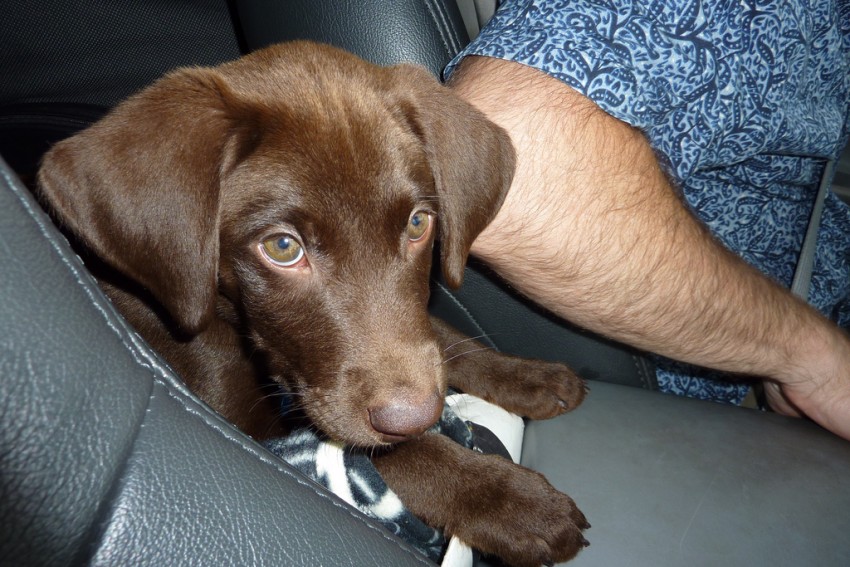
Planning on taking your dog on the road with you?
If so, you may be wondering how to travel with a dog in car — safely and smoothly.
Before you start your trip, read the tips below.
In this expert guide to traveling with a dog in a car, we’ll cover:
- How to keep your dog safe
- Which harnesses or carriers are best for dogs in cars
- Tips for taking a dog on longer trips in a car
- What about letting a dog ride in the back of a pickup truck?
- How you can prevent motion sickness in your dog before a car ride
- And much more!
So buckle up, and let’s begin…
Part 1: How to Keep Your Dog Safe in the Car
Prevent a tragedy — vow right now to make sure your dog is properly restrained whenever you take them with you in the car.
The expense and slight inconvenience of using the appropriate vehicle safety items is well worth the risk.
Plus, restraining the dog also keeps them from moving around the car and distracting you while you’re driving.
Safely Restraining Your Dog in a Car
Dog harness.
First, get a harness for your dog.
If you restrain your dog using only a collar, your pet may get strangled if you get into a wreck, especially if you rear-end someone. A harness may protect the dog’s neck and spine.
We prefer fabric harnesses that wrap around the dog’s neck and torso. Many also have a loop on the top through which you can thread the seat belt.
The PoyPet No-Pull Dog Harness has a reflective vest, a leash connection on both the front and back, and (last we checked) was less than $20. Worth every penny.
Dog seat belts attach to harnesses, keeping your dog immobilized in the back seat.
There are 2 basic models:
- Those that attach to your car’s seat belt
- Those that clip into the “female” end of the seat belt lock
Either kind will work. Choose the one that works best for your car.
This strap from PetSafe is adjustable and easy to use.
Remember: Don’t attach the seat belt to your dog’s collar — attach it to the dog’s harness instead, to avoid strangulation.
Booster Seat
A small dog who loves to look out the car window will enjoy having a booster seat.
Was YOUR Pet Food Recalled?
Check Now: Blue Buffalo • Science Diet • Purina • Wellness • 4health • Canine Carry Outs • Friskies • Taste of the Wild • See 200+ more brands…
CHECK RECALLS NOW!

Designed to fit in your back seat, booster seats are secured with your automobile’s seat belt, around which you clip a dog seat belt that you attach to the harness.
These specialized seats not only provide a safe place for travel but they also act as a comfortable dog bed. Most are made out of sturdy foam core topped with fabric and fleece. Add a blanket, and you’re good to go.
Booster seats provide maximum comfort and a view for your pup. They last a long time.
Here’s a highly rated car booster seat for small dogs sold by a company called Kurgo.
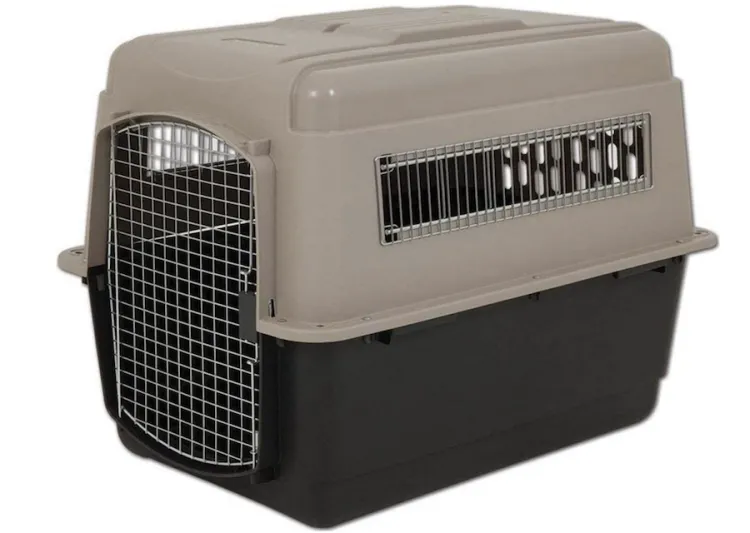
Dog Carrier
The safest way to transport your dog? In the back seat, confined to a hard-sided dog carrier (also called a travel kennel or crate) that you’ve secured with a seat belt.
In the event of a car accident, your dog should be well protected in a carrier.
The Petmate Ultra Vari Kennel is billed as being heavy-duty and secure for a safe and comfortable travel experience.
But according to the Center for Pet Safety (CPS), this exact crate was “far and away the most impressive crate” that this safety organization tested. It “was able to withstand the most significant forces generated in testing,” the CPS reported.
A few dog carrier tips for car travel:
- Make sure that whatever carrier or crate you get is large enough for your dog to stand, sit, lie down and turn around in.
- Place the carrier in the back seat, and then thread the seat belt through the handle. (Unsecured carriers can slide around on the seat.)
- Avoid putting too many items in the carrier that take up space or could cause injury to your dog.
Don’t Take a Chance on Safety
Pets aren’t children, but with respect to car travel, you should treat dogs as you would young kids.
Your dog should always sit in the back seat, secured with a safety restraint. Don’t let them ride in the front seat.
Yes, small dogs are cute and may fit in your lap perfectly, but you should not drive this way or allow your small dog to lie on a dashboard or other areas in the vehicle. This causes a distraction for you and increases your dog’s chances of being injured.
Getting a Dog Used to the Carrier
If your dog is not familiar with a carrier, try using it in the home before your trip to get your dog accustomed to it:
- Leave the door open.
- Place some of your dog’s favorite things inside to spark curiosity.
More Dog Carrier Tips for Car Trips
- Make sure that the carrier has enough ventilation to allow air to pass through freely, either through gated areas or holes.
- If your dog makes a mess inside the carrier during the trip, carry the carrier to a confined area such as a bathroom before letting your dog out. This lets you clean the carrier without the risk of your dog running away.
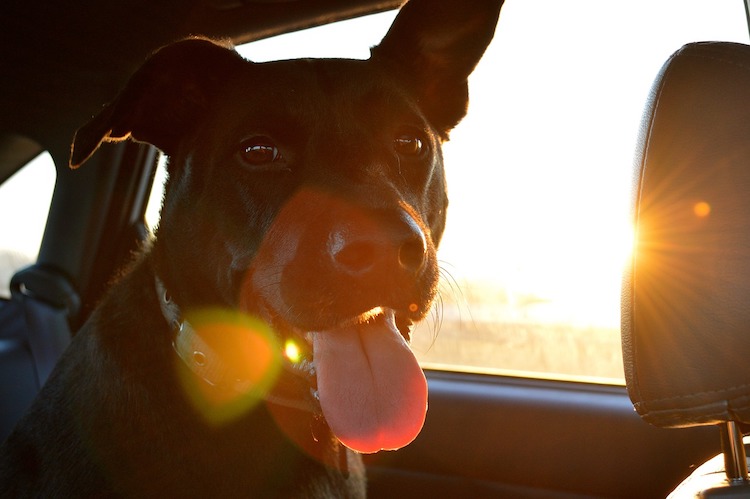
Part 2: Advice for Traveling With a Dog on Longer Car Trips
Be aware of the temperature.
This is an important topic for any pet when it comes to car travel.
Be aware of what the temperature will be at your destination and along the way, and never leave your dog in the car.
It takes only a few minutes for the temperature to rise to dangerous levels inside a vehicle, even in mild temperatures such as 75 degrees Fahrenheit. Lowering the car windows is not an effective way to ventilate the car — and may even allow your dog to escape.
The same can be said for the cold: Dogs can get hypothermia or die from dangerously low temperatures. Keep extra blankets with you, and again — don’t leave your dog in the car.
Hotels, Motels and Camps
If your trip includes staying overnight, check with the place you will be staying to learn about the pet policies, costs and other concerns.
If you plan to find a place to sleep as you go, make a list of dog-friendly places along the way so you know which ones to head to first.
See the Vet Before Long Car Trips With Your Dog
A vet visit is a good idea before a trip, especially for longer trips.
The dog’s veterinarian can check their health and make sure travel will be fine. Discuss sedation with your vet if you feel your dog will be stressed, anxious or have significant issues during travel. (See the next section on ways to prevent motion sickness.)
Do not self-medicate your dog or give your medications created for humans or other animals — these could be deadly.
- Consider getting your dog microchipped before the trip.
- Traveling across states, you may be asked to produce your dog’s rabies vaccination information. Take a copy of your dog’s records, as well as a current photograph in case your dog gets lost.
- Keep a copy of the paperwork and a picture of your pet in 3 places: your car, taped to the carrier and with you at all times. Add your contact information so someone finding your dog can contact you.
- Make sure your dog has a current tag on their collar — and bring an extra one in case it needs to be replaced while you are on the road.
Food and Water
- Limit your dog’s food intake before traveling to reduce the possibility of sickness or nausea.
- Take extra pet food and snacks with you for stops or for when you reach your destination. Stores may not have your dog’s usual brand of food, and changing food during a stressful situation such as travel might be a combination that causes stomach upset, diarrhea or other unpleasantness for your dog.
- Finally, take bottled water — and lots of it — with you on your trip.
- Try to plan stops every 3–4 hours to ensure your dog has ample opportunities to stretch, potty, drink water and get a break from the car.
- Don’t forget to bring along poop bags and/or a scooper to clean up after your dog.
- Keep your dog leashed on walks.
Talk to the Kids
If you are traveling with children, talk to them about allowing the dog to enjoy personal space without distraction.
Discuss behaviors they shouldn’t do, such as:
- Hitting or shaking the carrier
- Feeding the dog their food or snacks
- Teasing, hitting, pulling, or opening the crate — or releasing the harness
Any of these behaviors can add stress to your dog, and the goal is to keep your dog as comfortable and happy as possible while the dog is traveling in the car.

Part 3: How to Prevent Motion Sickness in Your Dog
Did you know 1 in 6 dogs suffers from motion sickness?
If you have a motion-sick dog, then you have our sympathy. Knowing your dog will arrive shivering and salivating (at best!) takes the fun out of a car trip.
Some dogs even learn to anticipate the feelings of nausea, and this makes them reluctant to even get in a car.
If you avoid car travel with your dog or always travel with a full cleanup kit, help is at hand. But don’t expect a quick fix — the answer takes time and dedication.
Positive Associations
Some dogs only have to see a car to start drooling because they link road travel to feeling sick.
This makes them unwilling to get into the car, which means you end up forcing the dog in — which only adds to the dog’s anxiety and feelings of unease.
Put an end to this vicious circle by teaching your dog to associate the car with good things.
- Play with your dog’s favorite toy in the back seat of your parked car.
- End each session on a high by giving them a treat.
- Hop out to go for a walk before they get anxious.
- Reward them for being calm while inside the car with another tasty food treat, and praise their bold behavior.
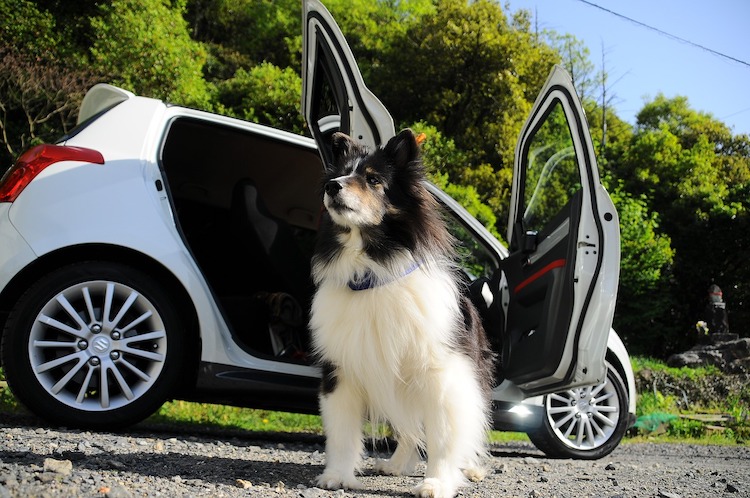
Another option includes spending at least a couple of weeks engaging the dog in a game inside the car but with the doors open so your pet doesn’t feel trapped.
Also try other strategies, such as feeding meals inside the car (perhaps invest in a waterproof seat cover) so your dog sees the car as an extension of the home.
Once the dog is willingly jumping into the vehicle, you’re ready to progress. Take things slow, though — move on to the next stage only when your dog’s tail is in the air rather than between their legs.
Introduce one new change at a time, giving them plenty of time to accept each step.
A retraining journey includes:
- Shutting the car doors
- Starting the engine but keeping the car in park
- Reversing a few feet, then driving back to the parked position
- A short, straight drive up the road
- A short drive around the block, then back into the drive
- A short drive in the neighborhood
All the while, remember the 3 golden rules:
- Praise their calmness.
- Stop before they become distressed.
- End on a positive note.

Car Climate
There’s nothing worse than a hot, stuffy car for making me feel sick when traveling, and the same is true for dogs.
- Make sure the vehicle is cool with fresh air circulating. It also helps some dogs if they can see out of a window — for smaller dogs, consider a booster seat or dog pod.
- Most dogs travel best with a handful of dry biscuits in their stomach, given 1–2 hours beforehand, rather than traveling with a totally empty stomach.
- Stop frequently to let your dog stretch his legs and drink water.
Travel Medications
If you have an urgent journey to make, you may not have the time to desensitize your dog to car travel.
Medication may be your best way forward. At least then the dog will be spared the nausea associated with car travel.
Some people swear by traditional remedies, such as ginger or peppermint. There are also herbal options, such as skullcap and valerian, or quick fixes such as Rescue Remedy.
That said, these are not scientifically proven to be effective, and it’s best not to rely on them, especially for a long trip.
There are also these medications:
- Acepromazine (ACP): This is a sedative with an anti-motion sickness action. ACP isn’t suitable for short journeys, as the dog is groggy for around 8 hours. Also, some dogs have an adverse reaction where they become “hyper” rather than sedated, so test it out before committing to a long journey.
- Maropitant (Cerenia): This drug acts on the nausea center in the brain and turns it off. This makes it the ideal motion sickness tablet — it works for 24 hours without sedating the dog. The only drawback is the price.
Here are a few more great tips from Pet Health Network:

In short, reintroduce the car as a fun place to be, and use medication to stop your dog from feeling sick.
By preventing nausea and building new associations, you’ll find that along this path lies the promise of stress-free car travel with your dog.
Part 4: Why Are Dogs Still Riding in the Back of Trucks?
You’re driving down the road, windows open, hair blowing in the wind and music blaring.
It’s a gorgeous, sunny day that’s absolutely perfect for a road trip.
Until you spot something that puts a knot in your stomach — someone’s dog is freely riding in the bed of their pickup truck.
Not only that, but also you see the driver look down to switch the radio station, only to swerve away from the curb after looking back up. The dog, of course, bumps hard into the side of the truck bed, almost losing balance. The sight makes you cringe.
What do you do? There must be a law against something like this, right?
The straight answer is yes, there are laws against driving with dogs in the back of pickup trucks.
Unfortunately, those laws are sparse and certainly not all-encompassing.
According to the Animal Legal and Historical Center, as of 2017, only 5 U.S. states had laws in place to keep dogs out of truck beds:
- Connecticut
- Massachusetts
- New Hampshire
- Rhode Island
Even in those states, there are exceptions to the law.

How Dangerous Is it to Let a Dog Ride in the Back of a Truck?
DMV.org reports that thousands of dogs are killed each year riding in the back of pickup trucks.
That number doesn’t even account for all the injuries that don’t lead to deaths.
You know how gravel and dirt sometimes spray onto your windshield, resulting in tiny cracks in the glass? A dog riding in a truck bed is susceptible to that same gravel and dirt spray. If it’s forceful enough to crack a windshield, there’s no doubt it can harm a dog’s eyes, nose or even lungs if it’s breathed in.
Of course, there are also more obvious consequences, like a dog being thrown from the truck (or being slammed against the back of the cab) if the driver slams on the brakes or swerves.
How Dogs Can Ride Safely in a Truck
Drivers of pickup trucks should always ride with their dogs in the cab and strap them to the seat with a dog-friendly car restraint.
Yes, there are ways to secure crates to a truck bed, but even then, gravel and dirt could potentially damage a dog’s ears, eyes and throat.
And yes, there are ways to cross-tether a dog in a truck bed to prevent them from falling or jumping, but the same dangers remain.
The only real solution when taking your dog for a ride, no matter what kind of vehicle, is to safely secure them with a dog car seat or harness (in the back seat).
Sure, taking that extra step might delay the trip by a few minutes. But isn’t potentially saving lives worth it?
- Center for Pet Safety. “Gunner Kennel G1 Intermediate.” June 2015. https://www.centerforpetsafety.org/cps-certified/gunner-kennel-g1-intermediate/ .
- Becker, Marty, DVM et al. From Fearful to Fear Free: A Positive Program to Free Your Dog From Anxiety, Fears and Phobias . Fear Free, LLC. 2018.
- Horwitz, Debra, DVM, DACVB, and Gary Landsberg, DVM, DACVB, DECAWBM. “Air and Car Travel.” VCA Hospitals. 2013. https://vcahospitals.com/know-your-pet/dog-behavior-and-training-traveling-air-and-car-travel .
- DMV.org. “Traveling With Your Pet.” https://www.dmv.org/how-to-guides/pet-travelling.php .

Don’t leave your pet’s food safety to chance.
Sign up for petful’s recall alerts today. (it’s 100% free.).

Stay informed. Protect your pets.
Meet Petful
- How We Help
Pet Food Safety
- Free Recall Alerts
- Pet Food Recalls
- Report Problems
- Vet-Approved Recipes
- Adopt a Pet
- Privacy Policy
- Cookie Policy
- Terms & Conditions
© 2024 Petful® / P51 Capital All rights reserved. Petful does not provide medical advice, diagnosis or treatment. More information.

25 Road Trip Hacks when Traveling with Dogs in Cars
Road trips are one of the easiest and funnest ways to travel. Plus, they’re a great option for dog owners, since dogs of all shapes and sizes can ride in a car. Whether your trip is hours long or days long, there are things you can do to make life on the road a little bit easier for both you and your dog. Check out these 25 road trip hacks for when you’re riding with your dog.
Article Contents
1. Get Astroturf

If you’re traveling with dogs, and you want to protect your car from hair and dirt, consider Astroturf.
Astroturf is a synthetic material that looks like fake grass. It’s usually found on sports fields or walkways.
But it works great for dogs and cars too! Purchase a cheap roll of Astroturf at your local hardware store, measure your space, and cut it to fit.
The Astroturf provides your dogs with something to grip on, so they won’t slide around in the back. It’s great for traction, and it’s easy to put on and remove.
It’ll also catch all the debris – like dirt, fur or gravel – that your dog will inevitably track in. It’s just a matter of shaking it off to clean it, or giving it a quick spray of water. And remember, it’s a synthetic material, so it’ll dry super quick.
Get Astroturf here .
Bonus: if you’re into messy outdoor activities – hiking, camping, going to the beach, etc. – it’ll be great for you and your gear too!
2. Use a spill-proof bowl

You have to stay hydrated while on the road.
Ideally, you’ll want to stop for water breaks, and drink al fresco. But if you’re staying in the car, either due to time constraints, bad weather, or because it’s dark out, you’ll want to serve up that fresh H2O in a spill proof bowl.
Spill proof bowls ensure your dog won’t get water everywhere or drench your car in dog drool.
Keep one on hand for mess free feedings, so your dog stays hydrated while your car stays clean.
Get the no spill bowl here .
3. Keep all your dog’s important documents in a waterproof, sealable Ziploc bag
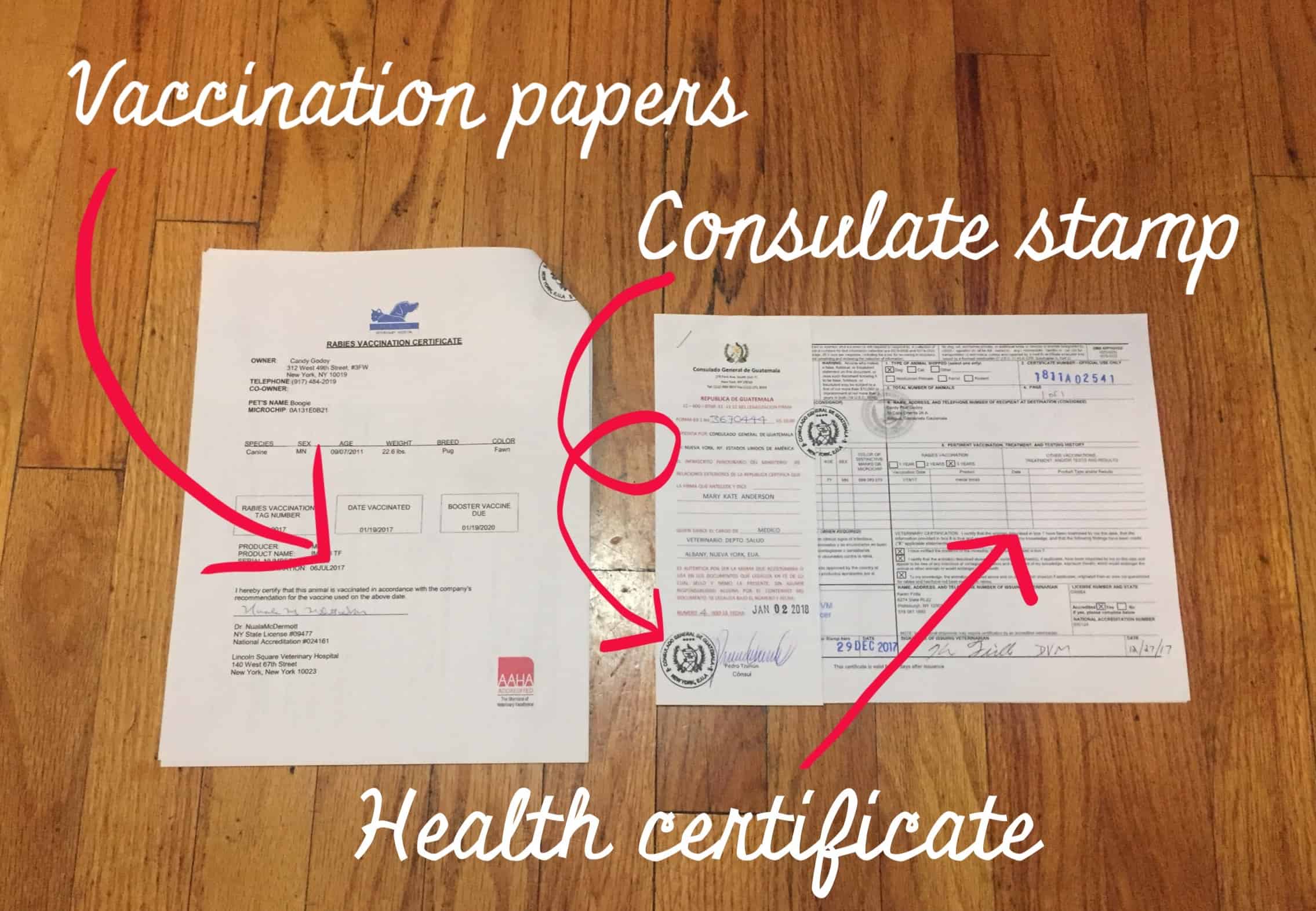
When you’re traveling with your dog, it’s important to keep vital documents, like medical records, extra copies, and ID information, on hand, especially if you’re crossing state lines.
And when there are muddy paws, dirty shoes, and the potential for spills, you’ll want to be sure these documents stay clean and dry.
Keep them safe in a waterproof and sealable ziplock bag. This is easy to throw it in a backpack or the glove compartment, and means you won’t have to worry about keeping them readable.
4. Use seat covers or a blanket
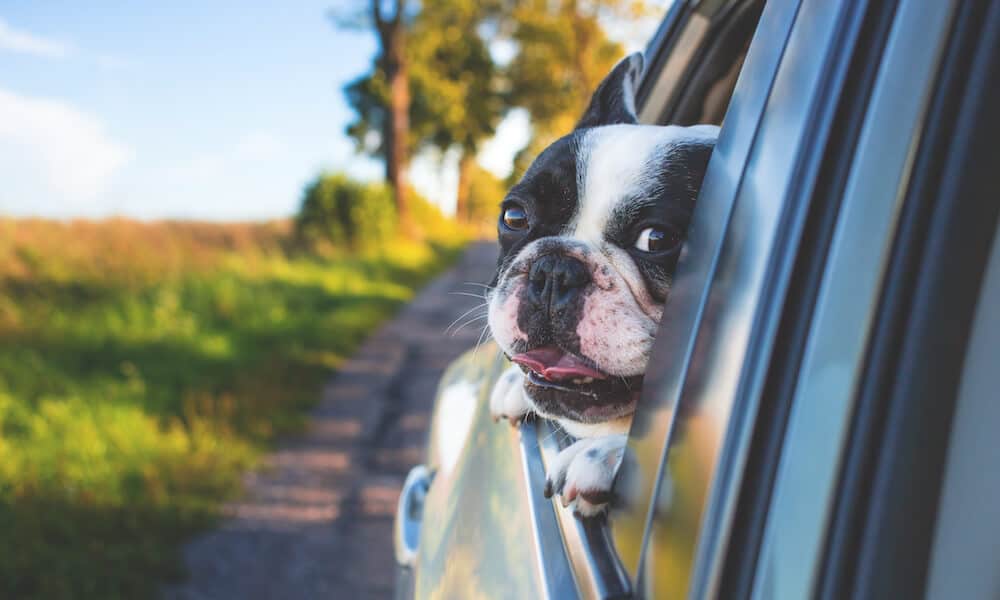
Dog hair and seat scratches are easily preventable by keeping seat covers or a blanket on hand. They both protect your car and make it easy to shake off loose fur and debris.
They’re especially useful if you’re renting a car. Who doesn’t love an easy clean up?
Bonus: get waterproof seat covers to make your ride even smoother – there’ll be no need to worry about wet dogs!
Get seat covers here .
5. A crate, car seat, and/or seatbelt are necessary
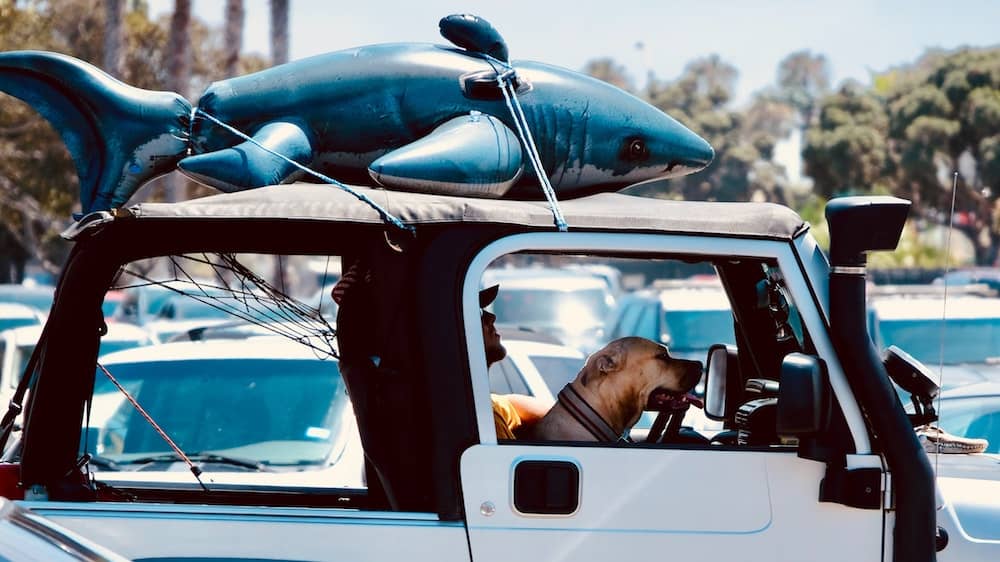
Safety is important when you’re on the road. If you stop short, slam on the brakes, or get into an accident, your dog can get seriously hurt.
To protect your dog, make sure to secure them while in the vehicle.
For medium to large dogs, try a crate or dog seatbelt. For smaller dogs, check out car seats.
Consider collapsible travel crates , no matter your dog’s size, which double as in-car restraint systems and a dog suite in your hotel room or campsite.
6. Use a pet ramp for easy access
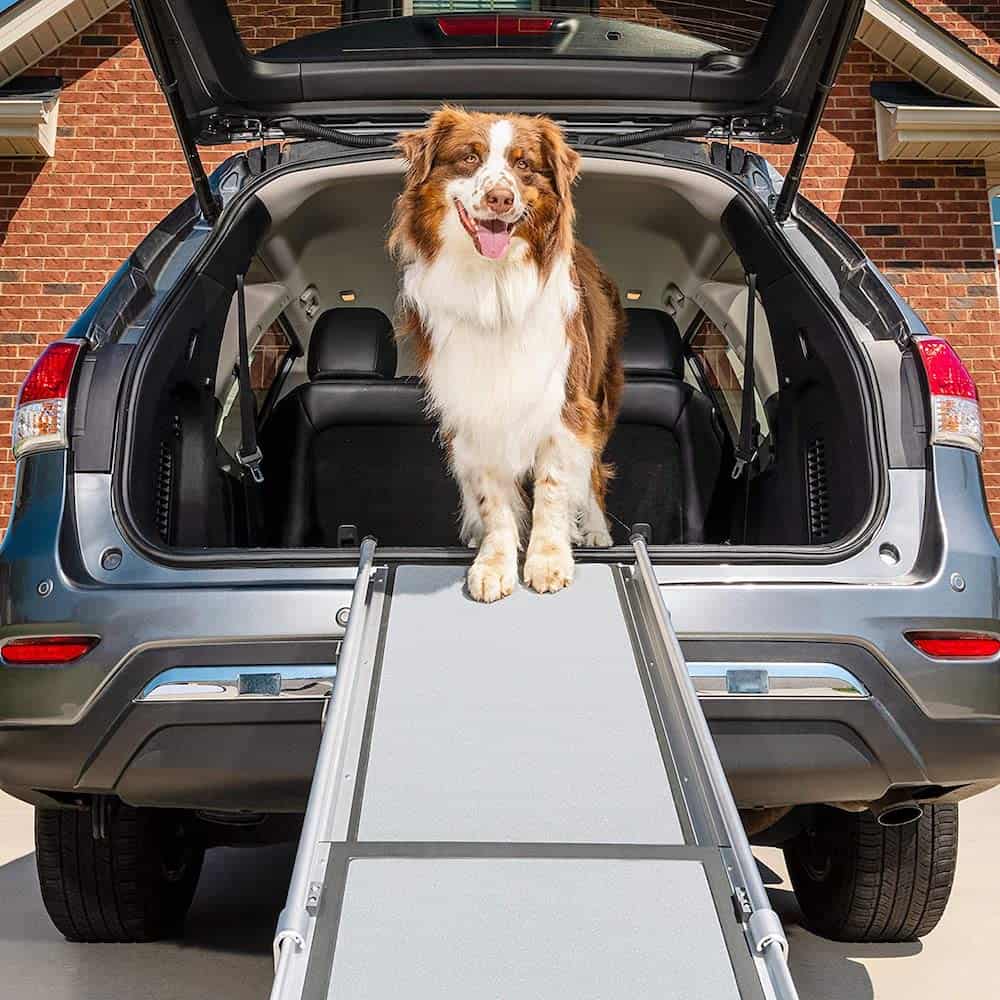
Some dogs, like older pets or dogs with mobility issues, might have trouble getting in and out of the car. Carrying them isn’t really an option if they’re big, or if your hands are full.
A pet ramp is a great option to help with easy load ins and outs.
This one is adjustable, works with all sizes of vehicle, and can withstand up to 400 pounds. Its high traction surface prevents slips and falls. Plus, the ramp is easy to carry – it’s only 13 pounds – and easy to store.
7. Use up to date dog tags

Up to date dog tags are important in your dog’s daily life, and especially while traveling.
They signify to others that your pet has a home. They’ll protect your pet from being mistaken as a stray, and make it easy for people to contact you should anything happen.
My dog’s tags have their name, my email address, and my phone number. Some might choose to include their home address as well.
Be sure your pet is microchipped too!
8. Use a travel pet food container

Throwing some kibble in a Ziploc bag sounds easy, but if you turn your back for a few minutes, your dog will sniff it out and rip right through it.
This kibble carrier keeps meals fresh and can hold up to five pounds of food. I love that it rolls down and clips securely, making it malleable so it changes size depending on how much food I pack.
This travel container is also great, especially on camping trips and long car rides. It includes two detachable bowls to serve food and water, and features an easy to carry handle.
9. Pack the right clean up tools
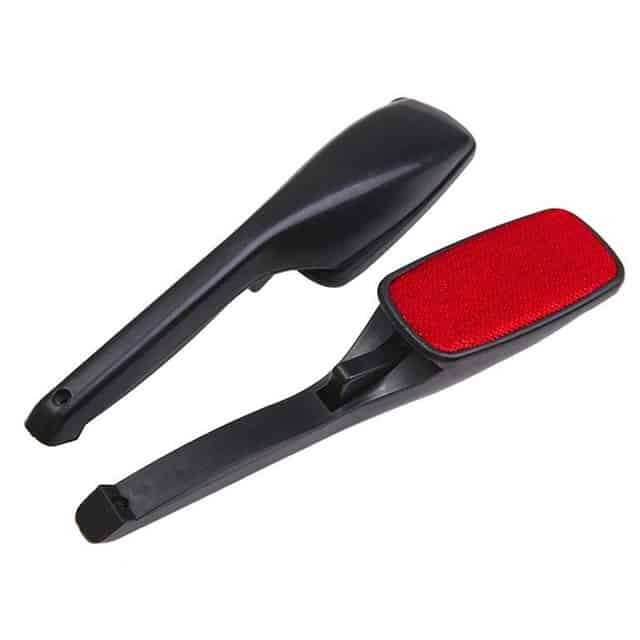
A road trip converts your car into a make shift home; you’ll be using it to eat, sleep and hang out. With all of that extra time in your vehicle, it won’t be smelling too fresh by the end of the day. Add one or two dogs, dirt and mud from outdoor excursions, and plenty of spills, and you’ve got yourself a locker room on wheels.
But who wants to travel in a dirty car? Not me! Especially if it’s a rental, and fees are involved. Keep your car clean and pack the right tools to help you.
This hair-removing silicone brush is great at loosening pet fur lodged in your car’s carpets and seats. It’s also small enough to keep in your glove compartment or to throw in a bag.
For a more thorough clean up, consider a vacuum. This handheld cordless vacuum will suck up all of the fur, sand and dirt tracked in from your dog, plus it comes in an easy to store bag.
It’s lightweight and portable, so perfect for road trips.
10. Stay shady
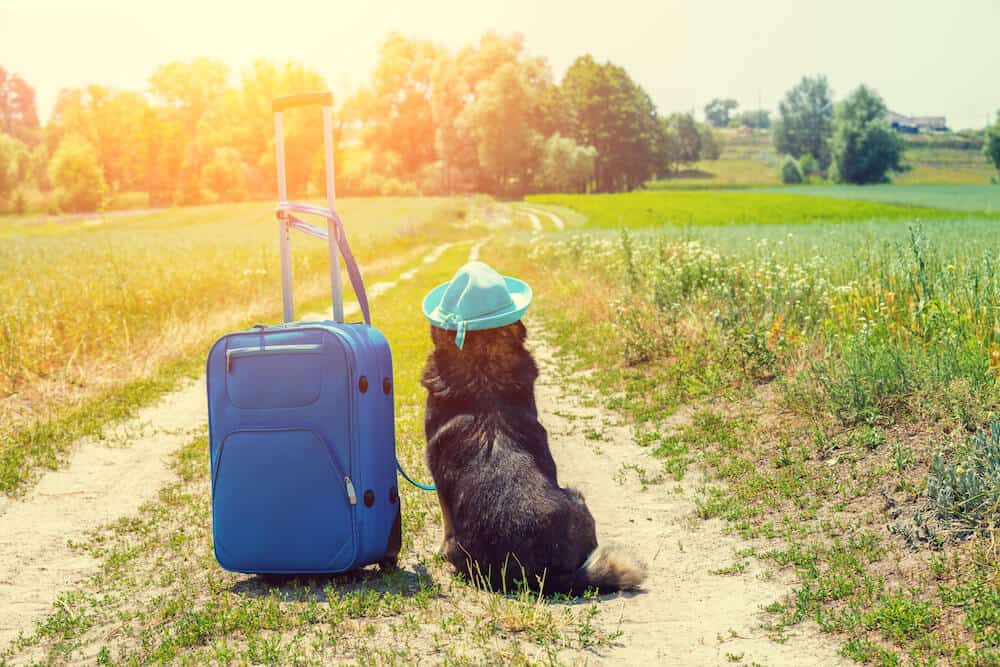
Driving on a hot day? Sunlight will heat up the interior of your car and turn your vehicle into an oven. It’ll dehydrate you and your dog, and make car rides uncomfortable.
Keep your car, whether on the road or parked, cool and stay shady.
This car window sun shade blocks over 97% of harmful UV Rays. It fits most car windows.
If your dog sits in the back (they should!), try these rear seat air fans . They plug into your cars’ cigarette lighter and help keep your pet cool on even the hottest of days.
11. Stay hydrated

Long hours on the road, especially on a hot day, can lead to dehydration.
While you’ll want to take frequent water breaks, sometimes, due to weather or time of day, you won’t be able to stop the car.
This dog water bottle fits right in the car cupholder, and dispenses water with a squeeze. It’ll make grabbing a quick lick easy while on the road.
12. Pet First Aid kits are a must
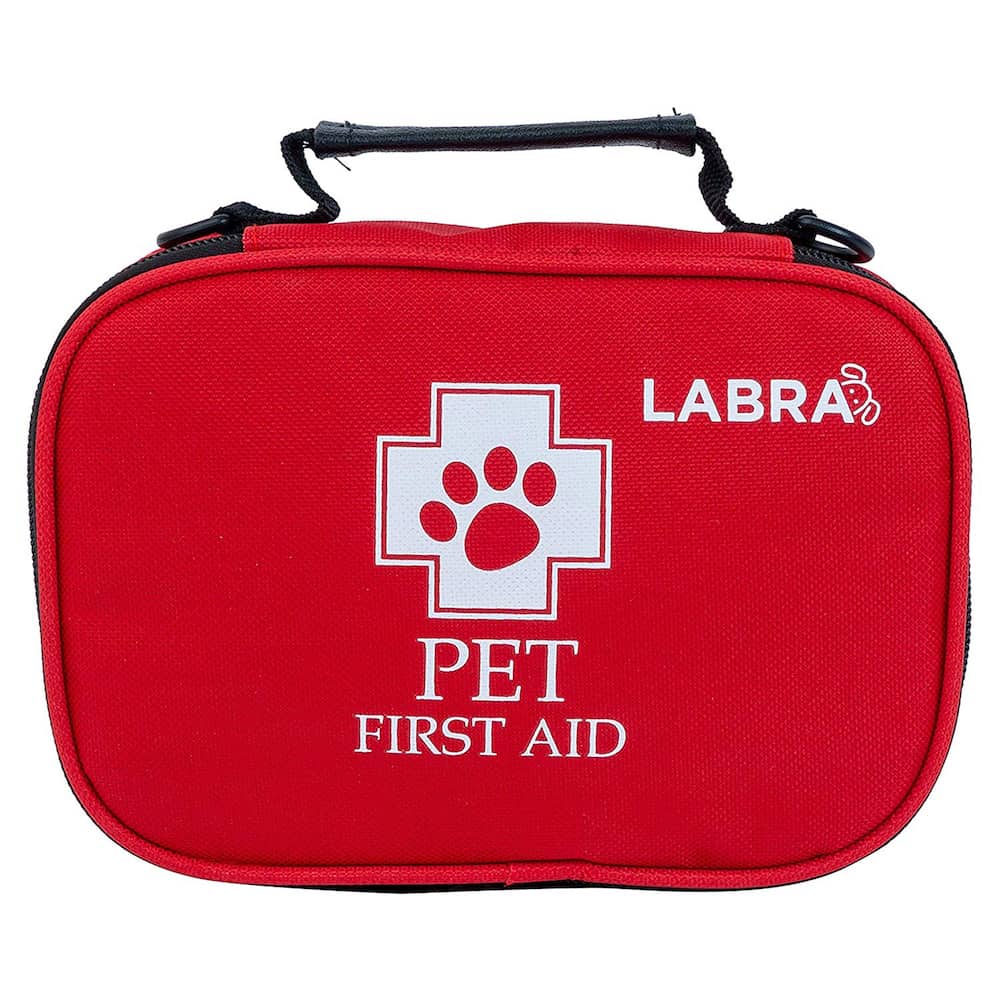
Every car needs a dog first aid kit to use in case of emergency.
You’ll be prepared for injuries and be able to treat cuts, scrapes, sprains and strains, no matter where you are. It’s always better to be safe than sorry.
This useful K9 First aid Kit is compact, sells for a reasonable price, and has all of the essentials. It includes scissors, tweezers, a pet brush, a pair of rubber gloves, antiseptic cleaning wipes, and more.
Or, save money and make your own with a few items from around the house.
Grab a container – a ziplock, drawstring bag or Tupperware works – and throw in the following:
- Hydrogen peroxide
- Antibiotic ointment
- Rubber Gloves
- Wet or Grooming Wipes
13. Be organized
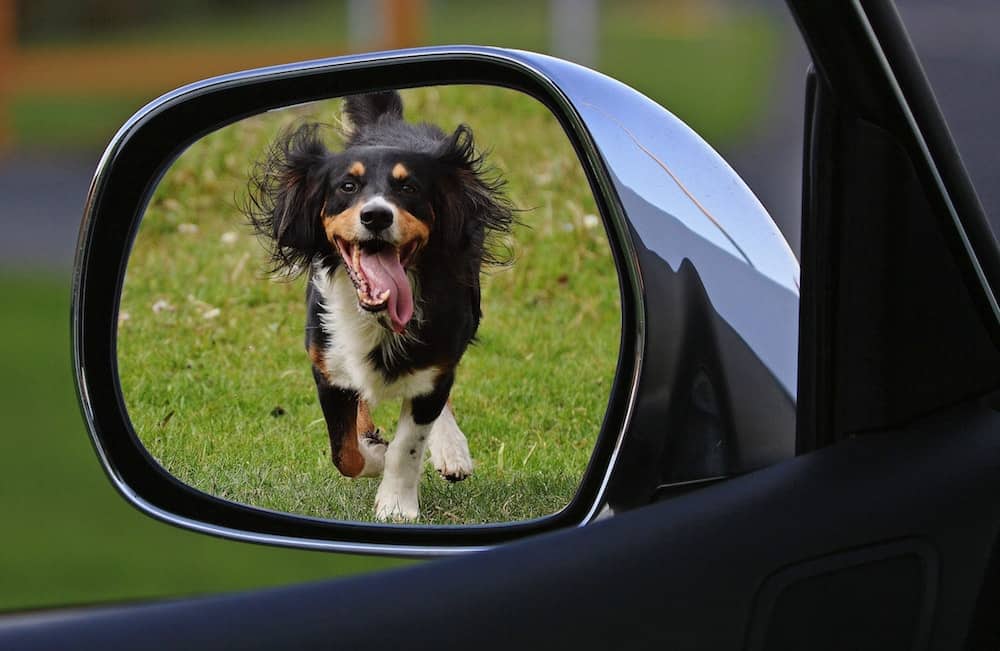
Throwing things in your car feels great until you’ve created a mountain of mess and can’t find something. Avoid this problem entirely by getting organized from the get go.
This strap in collapsible trunk organizer helps you neatly store all of your gear into sturdy, yet flexible compartments. Use it in half mode or open mode, depending on how much stuff you have.
I’m also digging this trunk divider that attaches with velcro and fits into even the most weirdly-shaped nooks of your car. It’s an easy way to secure loose clutter in the back.
14. Keep a packing list

Planning a road trip can be daunting, but you won’t have to worry about leaving things behind if you’ve got a good packing list to refer to.
This packing list works at the beginning of a trip, when you’re packing your bag, and throughout, to make sure you don’t leave anything behind.
Check out our dog travel checklist , and print out a copy for yourself.
15. Map out dog-friendly places to stop along the way

What’s a road trip without fun stops along the way? But with a dog in tow, not every location will be welcoming.
Before heading out, map out dog-friendly stops along your route, so you’re not totally clueless when it comes to breaks. It’ll make potty breaks or activities along the way easier and better.
Plus, doing a bit of research before the trip will help you discover dog-friendly places you never even knew existed.
Here are some helpful places where you and your dog will be welcome:
- The Best Dog-Friendly Places to Stay on a U.S. Road Trip
- Guide to the Ultimate Road Trip with your Dog
16. Soothe nervous dogs
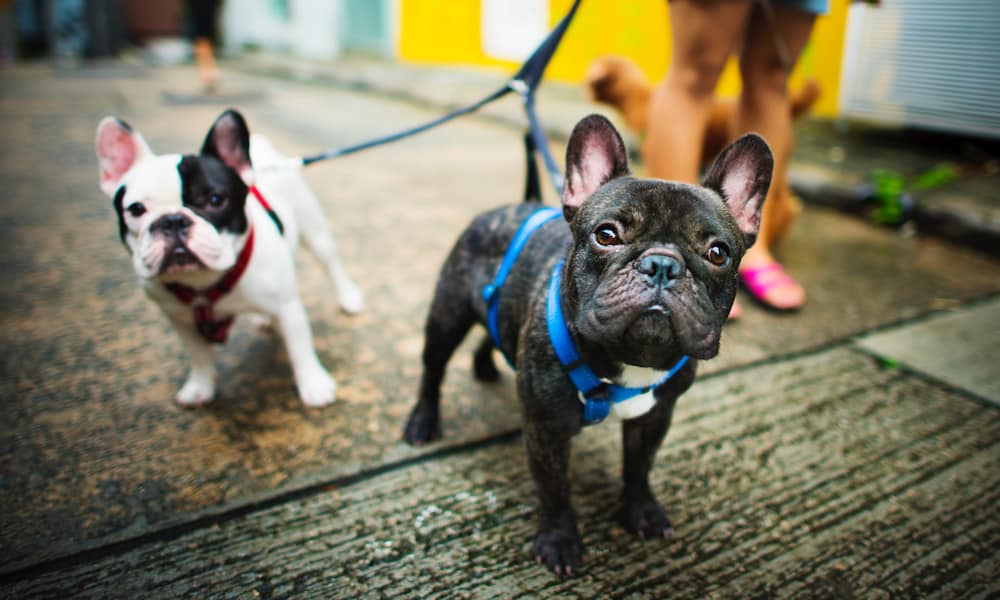
If your dog is nervous in the car, help soothe them so that they can rest and get comfortable.
Here are some tips for road tripping with a nervous dog:
- Bring along your dog’s favorite items, so they have familiar objects around from home. A favorite toy, dog bed or blanket with your scent.
- Put your dog in a thunder jacket; they apply constant pressure on a dog’s torso, similar to a parent swaddling a child.
- Experiment with CBD oil or CBD treats to help your dog remain calm.
- Make sure the car is comfortable and cool – crank the air conditioning and make their crate or the backseat nice and comfy.
- Do shorter rides with a great reward at the end before embarking on a longer trip.
17. Get rid of that wet dog smell

If you’re planning outdoor adventures like hiking or swimming, your dog is guaranteed to get wet and muddy. While that wet dog must is ok around the campfire, it’s not great once it infiltrates your car.
This bamboo charcoal car air freshener naturally absorbs odor like a stink sponge. It’s long lasting and fragrance free, and totally safe for your pets.
18. Keep supplies on hand for dirty paws
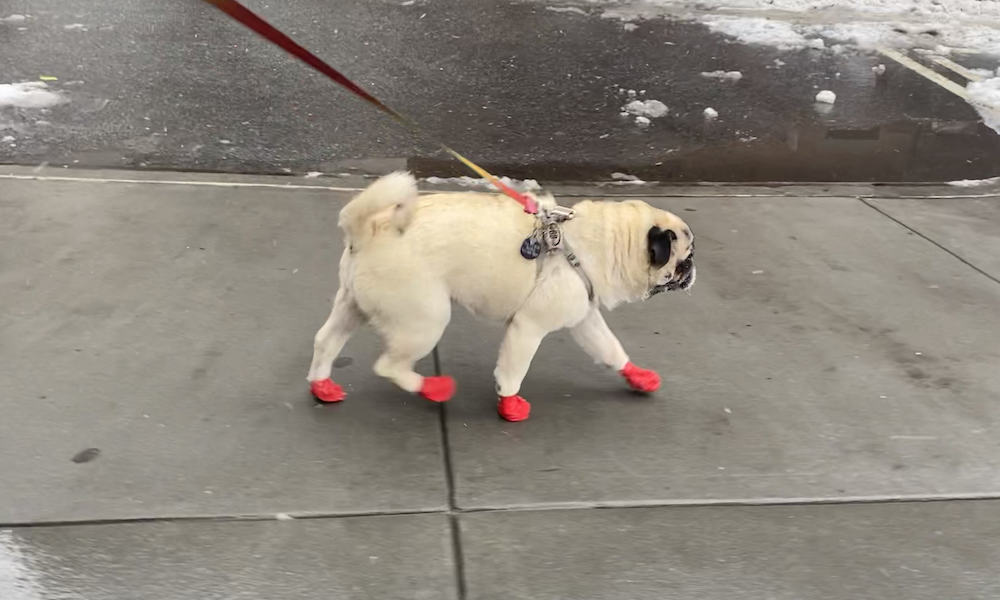
Just as you should wipe off or remove your dirty hiking boots after a trek, do the same for your dog. Dog paws can track in dirt, sand, mud and water that’ll get all over your car.
Keep some supplies on hand to prevent too much mess. A quick dry towel or grooming wipes should do the trick.
Or, make your dog wear dog boots ! They’ll keep your dog’s paws clean and you can take them off before getting in the car.
19. Download helpful apps

There are plenty of apps that can help when on the road with your dog. It’s gotten a lot easier than when I used to travel the world sans iPhone.
- BringFido: This app (and website!) helps you locate pet-friendly hotels, restaurants, parks and activities.
- DogTrekker: DogTrekkers lists dog-friendly places to stay, eat, hike, swim and have fun throughout the state of California.
- USA Rest Stops: This app helps you find the nearest rest stop. It’s great for water and potty breaks.
- Roadtrippers: Roadtrippers offers planning, maps and travel guides for road trips. It’s especially great if you’re camping – you can book campgrounds directly in the app.
- Sniffspot: Sniffspot showcases safe and private dog parks and off leash areas hosted by locals. It was made for reactive dogs, but any dog can use it. Find locations that work for you and book for some play time.
If you’re looking for more, check out this list of the best dog apps available for iOs and Android! We’ve also got a list of our favorite dog podcasts .
20. Plan ahead

Jumping in a car and driving wherever the wind takes you sounds romantic, but it’s not really very practical. You don’t want to be stuck with no place to stay.
Plan ahead! It’s an especially good idea if you prefer the comforts of a hotel or motel, rather than a campsite. Some places don’t allow dogs, while others have weight limits, breed restrictions or big fat pet fees.
Here’s a list of questions to ask dog-friendly hotels, and here’s another with the best dog-friendly places to stay on a road trip .
21. Keep fleas away

If you’re planning to hike or spend time in the woods, you’ll want to be certain your dog has flea, tick and heart worm medication. It would be terrible to pick up fleas, and get them in your car! Plus, they can be dangerous and cause health issues like lime disease.
We tend to pick up organic flea collars before going on a trip. They’re great to have in handy and safer than alternatives. Earth Animal also sells a flea and tick internal powder that comes highly recommended.
22. Reward your dog with a treat along the way!
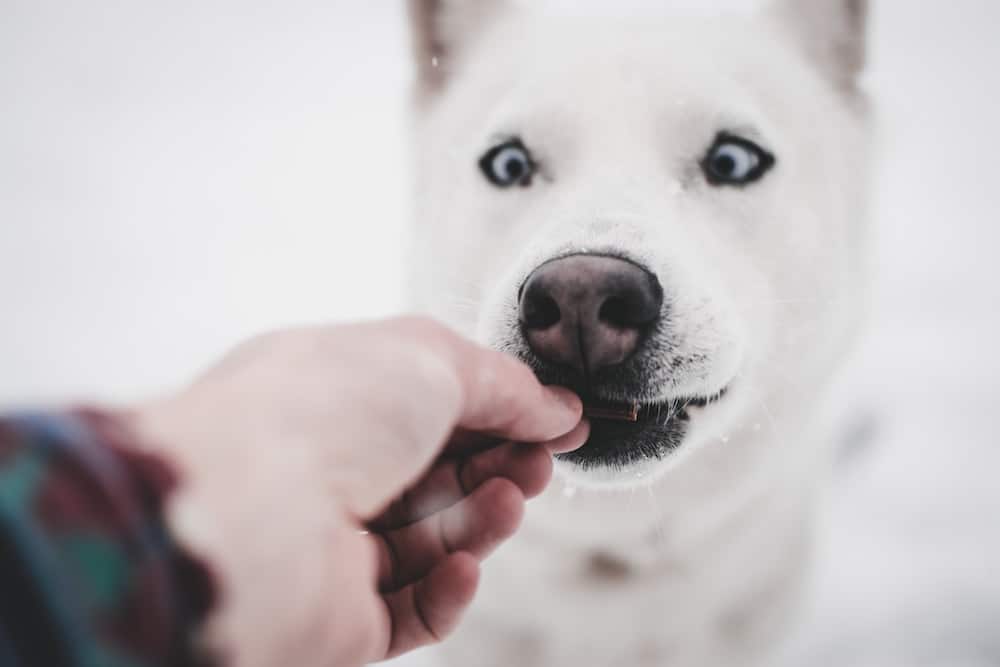
Road trips are fun, and your dog should be in on it. The car is a happy place! It’s taking you to new places, and on new adventures.
Remind your dog of this with positive reinforcement and treats.
When you’re on the road, stop at chains like Dairy Queen and Starbucks; both offer dog treats that you can pick up at the drive through. Dairy Queen has pup cups, and Starbucks has puppucinos .
23. Tired dogs are the best travelers

This is my number one piece of travel advice, whether you’re flying, road tripping or on a train.
Zoomies and a case of the wiggles are best left for wide open spaces. Confined spaces, like a car, mean your dog won’t be able to stretch their legs.
Make sure your dog gets a lot of exercise before doing a long stretch in the car, or stop along the way so they can run around. It’ll make your dog feel better, and make for a much more comfortable trip, for both you and your pup.
24. Use bottled water if you’re crossing state lines
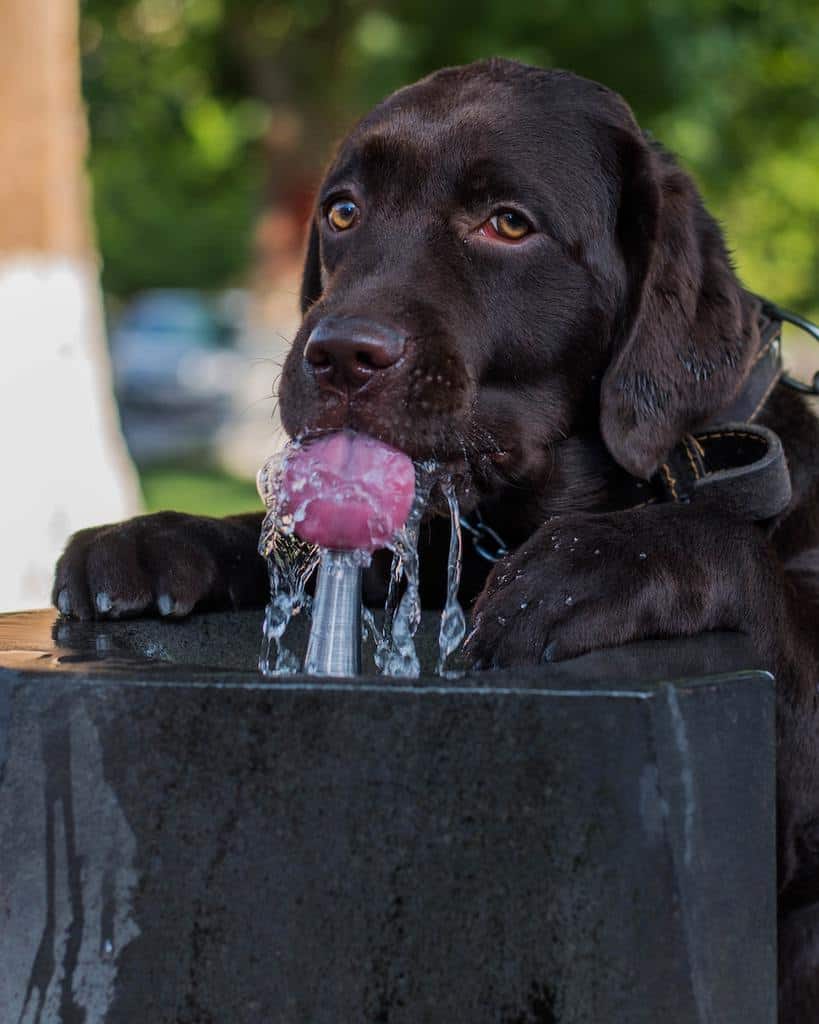
This is a trick I learned from show dogs who have to travel to compete.
Tap water is different in every place, especially when you cross state lines. The change in levels of things like chlorine can upset your dog’s digestion and cause diarrhea.
Take your own water from home, or buy bottled water.
If you bring your own water, gradually add some of the new water to the water from home, or just stick to bottled water the entire time to be safe.
We bought jugs of water at Costco and Walmart and just always kept extras in our trunk. Problem solved!
25. Bring a headlamp to pick up poop in the dark

Let’s be real, picking up dog poop in the dark is a drag.
Sure, you can use your cell phone as a flashlight, but that means you’ll have to do the one handed poop pick up, while you also hold a dog leash and bend over. What a mess!
The chances of falling, tripping or dropping your phone into some fresh poop are high.
And if you’re in a wooded area with grass? Even worse. Camouflaged poop is extra hard to find.
Free up your hands and be prepared with a headlamp! That way you can easily spot the fresh turds all while using both hands. Plus, you can use it for other stuff while in the dark. Stuff that hopefully doesn’t involve poo.
Here are some rechargeable headlamps that come highly rated.
Related:
- Rental Car Company Pet Policies
- This Is The Only Insurance Company That Will Cover Your Pet While Traveling
What other tips do you have for dog-friendly road trips? Let us know in the comments.
Pin for later!

Similar Posts
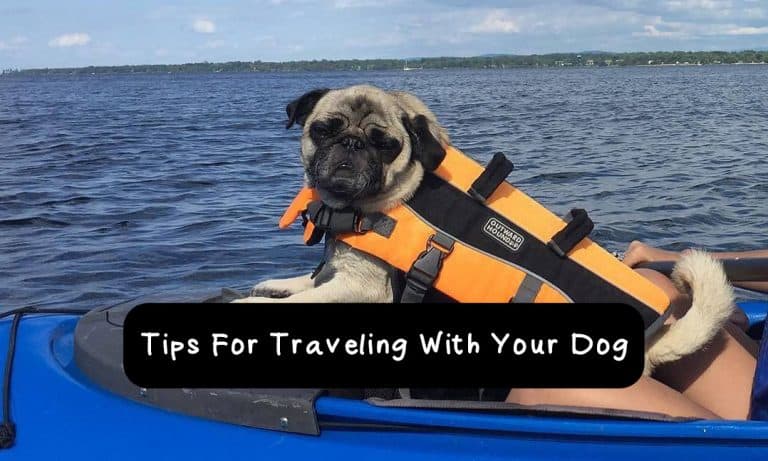
Tips for Traveling with your Dog
Many assume that traveling with your dog will be stressful, but it doesn’t have to be! Here are a few general tips for a dog on the go.
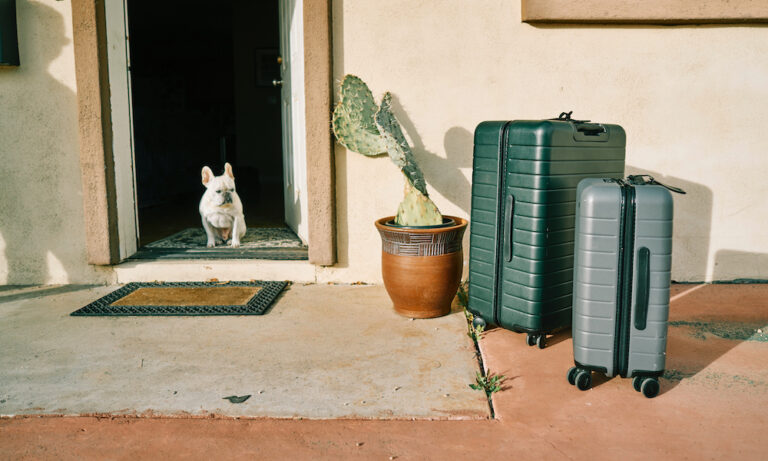
6 Steps to Being a Mindful Pet Traveler
Travel has an impact, especially if you’re traveling with a dog. Being a mindful pet traveler produces a richer travel experience for all involved.
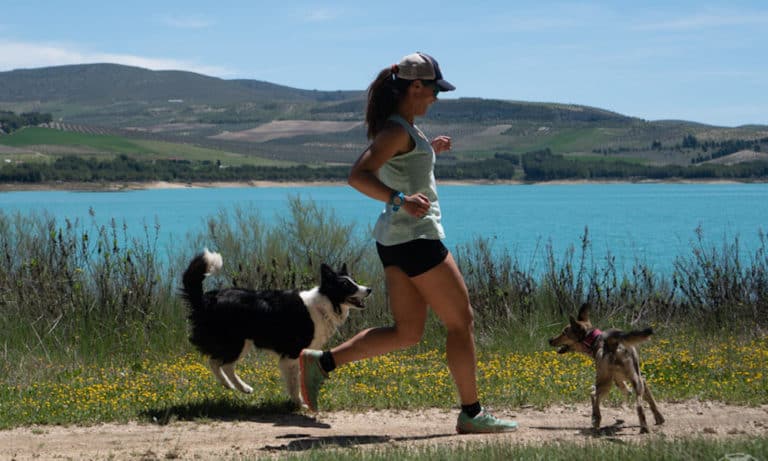
Active Dogs On The Road: An Interview With Long Haul Trekkers
American couple Jen Sotolongo and Dave Hoch, known as Long Haul Trekkers, share how they travel with two large dogs and stay active on the road.

This Pug Hikes Mountains: An Interview with Mack the Adventure Pug
Mack the adventure pug and his human Nate love to go on adventures together, camping and hiking all across the United States.

6 Dog-Friendly Things to Do in Burlington, Vermont
Vermont’s biggest city is a dog haven! There’s plenty to see and do with your pup. Here are 6 dog-friendly things to do in Burlington.

Can Pugs Fly? What You Need To Know About Planes and Pugs
Can pugs fly? Here’s the the low down on planes and pugs, and what you need to know before booking your next flight. Check it out!
GREAT article. thanks
Leave a Reply Cancel reply
Your email address will not be published. Required fields are marked *
Where Have We Been

Dog-Friendly New York City Dog-Friendly Brazil Dog-Friendly Boston Dog-Friendly Philadelphia Dog-Friendly Baltimore
Check It Out
About Privacy Policy Disclosure & Disclaimer Contact
Looking For Something?
Affiliates disclosure.
boogiethepug.com is a participant in the Amazon Services LLC Associates Program, an affiliate advertising program designed to provide a means for website owners to earn advertising fees by advertising and linking to amazon.com, audible.com, and any other website that may be affiliated with Amazon Service LLC Associates Program. As an Amazon Associate, the owner of this site earns a commission from qualifying purchases.
Travel Tips
Get Inspired How To Save For A Trip How To Plan A Dog-Friendly Trip Flying With Your Pet Get The Right Dog Gear Pet Friendly Accommodations Pet Friendly Destinations Roadtrips With Your Pet
Get the Latest Woof in Pet Travel
- PRO Courses Guides New Tech Help Pro Expert Videos About wikiHow Pro Upgrade Sign In
- EDIT Edit this Article
- EXPLORE Tech Help Pro About Us Random Article Quizzes Request a New Article Community Dashboard This Or That Game Popular Categories Arts and Entertainment Artwork Books Movies Computers and Electronics Computers Phone Skills Technology Hacks Health Men's Health Mental Health Women's Health Relationships Dating Love Relationship Issues Hobbies and Crafts Crafts Drawing Games Education & Communication Communication Skills Personal Development Studying Personal Care and Style Fashion Hair Care Personal Hygiene Youth Personal Care School Stuff Dating All Categories Arts and Entertainment Finance and Business Home and Garden Relationship Quizzes Cars & Other Vehicles Food and Entertaining Personal Care and Style Sports and Fitness Computers and Electronics Health Pets and Animals Travel Education & Communication Hobbies and Crafts Philosophy and Religion Work World Family Life Holidays and Traditions Relationships Youth
- Browse Articles
- Learn Something New
- Quizzes Hot
- This Or That Game
- Train Your Brain
- Explore More
- Support wikiHow
- About wikiHow
- Log in / Sign up
- Pets and Animals
- Transporting Dogs
How to Travel by Car with Your Dog
Last Updated: December 28, 2020 Approved
This article was co-authored by Elisabeth Weiss . Elisabeth Weiss is a Professional Dog Trainer and owner of Dog Relations NYC, a dog training service in New York, New York. Elisabeth relies on science-based, force-free, and reward-based techniques. Elisabeth offers behavior training, puppy manners, body awareness and injury prevention, diet, exercise and dog nutrition services. Her work has been featured in New York Magazine and on the Dog Save the People podcast. She also trained all the dogs in the movie "Heart of a Dog" by Laurie Anderson that features Elisabeth's journey with Laurie Anderson's and Lou Reed's dog Lolabelle and how her passion for playing the keyboards played a significant role in improving her quality of life after being diagnosed with pancreatic cancer. wikiHow marks an article as reader-approved once it receives enough positive feedback. In this case, 100% of readers who voted found the article helpful, earning it our reader-approved status. This article has been viewed 847,040 times.
Some dogs love to ride in cars and it's fun to take them along with you wherever you go. However, this is not the case for all dogs. Here are some safety tips you should think about before traveling by car with your favorite pet, whether they enjoy the journey or not.
Preparing to Travel with Your Dog

- If you don't want to cage your dog, at least find a way to make sure your dog is secure. For instance if you have an estate car, consider confining your dog to the rear of the car. If you do have a large window boot, put up a wire grid to stop your dog jumping over the back of the seats. Line the dog's area with dog blankets or place it's bed in the corner so it can nap comfortably on the journey. Make sure you don't have any heavy loose items, such as bowls or bottles, as those can become dangerous projectiles in an accident. Most dogs find sleeping an easy way to cope with motion sickness.
- You could also purchase a dog safety seat. While it is not as secure as a cage, it will be safer and more comfortable than a car seat for your dog if you turn or stop the car suddenly. The most popular among these are bucket seats. They attach at the back of the front seats, and the top of the back seats, creating a soft well in which your dog, and any liquids (or solids!) they may create, are contained. These can be made with a blanket or purchased cheaply.
- Car seatbelts for dogs are a great tool if you don't want your dogs confined, or if you only have a two-seater car. Make sure to attach them to a harness, and not a collar. They clip into the female buckle of a car seatbelt on one end, and have a standard lead clip on the other. By attaching them to a harness, you ensure the dog is secured by the body, and their neck won't be damaged in an emergency.
- If you use a cage, make sure it is secured. Make sure it is very secure to prevent it from moving if you stop suddenly or get hit. An unsecured cage can be just as, or even more dangerous than an unsecured dog.

- Squeaky toys are also undesirable as they will drive you crazy.

Going on a Long Drive with Your Dog

- This is especially important if your going on a long journey. Four hours is your average dog's absolute limit for driving without a longer break, but as a driver it's recommended you take a break after every two hours of driving. Make sure you stop somewhere grassy and relatively quiet (not right beside the road), lock your car, feed your dog some food and water, and take him for a walk so he can let off some of his excess energy.
- If you stop by the highway your dog MUST be on a lead for his own safety.

- If you stop for a meal, park your car in the shade, and let the windows down about an inch each to let cool air in. Put a bowl of cool water in the car for your dog and unbuckle him or her if in a dog seat. Lock your car doors, and order your food to go.
- Try to spend no more than five minutes away from the car if it is a warm day, as you don't want your dog to overheat. If your stop will take a bit longer, for instance you are waiting in a long queue for food, tie your dog to a post either just inside the front door or just outside in a place where you can see it. At least he or she will be out of the heat while you wait. Make sure to tie the dog with secure knots so it doesn't escape. Tight knots will also mean it will be less likely for someone to steal your dog.

Expert Q&A

- If your dog has a favorite towel or blanket be sure to bring it in order to comfort your pet. Thanks Helpful 6 Not Helpful 0
- Try to have your (non-toy*) puppy's first car rides be "on an empty stomach" by withholding food for 2-4 hours before the ride. Several rides without nausea will help tremendously to prevent the puppy from developing car sickness. Thanks Helpful 4 Not Helpful 0
- If you are traveling more than 24 hours, look beforehand for a pet-friendly hotel for you to unwind and for your dog too. Thanks Helpful 3 Not Helpful 0

- Some dogs can get very queasy. Keep a close eye on it and line the back seat with old blankets or newspaper if you want to be on the safe side. Thanks Helpful 42 Not Helpful 2
You Might Also Like

- ↑ https://www.cesarsway.com/dog-care/travel/dog-is-my-co-pilot
- ↑ https://www.cesarsway.com/dog-care/travel/cesars-travel-tips
- ↑ Elisabeth Weiss. Professional Dog Trainer. Expert Interview. 3 September 2020.
About This Article

To travel by car with your dog, you should restrain it with either a cage, a safety seat, or a seat belt designed for dogs, which will keep it safe and prevent distractions while you’re driving. Before your go for your drive, exercise your dog so that it will be tired and less anxious or hyperactive in the car. Additionally, pack supplies such as water, treats, and a few chew toys to help keep your dog occupied. You should also avoid feeding your dog right before a car trip to prevent it from getting carsick or relieving itself in the car. For more advice from our Veterinary co-author, like how to prepare a hyperactive dog for a car trip, keep reading. Did this summary help you? Yes No
- Send fan mail to authors
Reader Success Stories
Ana Carolina
Aug 10, 2016
Did this article help you?

Cheryl Davis
Apr 30, 2017
Larry Cullop
Jul 20, 2017
Feb 16, 2017
Leanne Chatterton
Aug 15, 2016

Featured Articles

Trending Articles

Watch Articles

- Terms of Use
- Privacy Policy
- Do Not Sell or Share My Info
- Not Selling Info
wikiHow Tech Help Pro:
Develop the tech skills you need for work and life
The safest way to travel with dogs

There’s something idyllic about taking to the open road with your dog by your side ― seeing their head hanging happily out of the window from your rear-view mirror, their faces warm in the sun, their ears flapping in the wind.
However, some of what we love most about driving around town with our constant companions may not be wise.
Whether you’re taking your pup to the pet supply store for some quick socialization or embarking on a cross-country road trip for the holidays, here’s what you should know to keep you and your best friend safe.
@animalhumanemn How do you keep your pet safe in the car? #dogsoftiktok #AnimalHumaneMN #travelwithdogs #cattledog ♬ Countless - Official Sound Studio
Buckle up your pup
Seatbelts are lifesaving — for people as well as pets. Any time you take your dog in the car it’s crucial they are secured.
Kennels are the best way to keep your pooch safe and ensure they aren’t distracting you while you navigate and drive.
However, if you’d prefer to keep an eye on your buddy during your trip, you can purchase a harness or car seat that buckles into your vehicle’s seatbelt system.
Not only will keeping your pet secure prevent injuries from an accident, but it can also protect you and others in your car as pets can become dangerous projectiles during a crash.
According to Allianz Life Insurance Company, if a car crashes at a speed of just 25mph, an unrestrained dog can be projected forward at a force equal to 40 times their weight. That means a 50-pound dog can achieve an impact force of 2,000 pounds in a car crash!
Though many states, including Minnesota, don’t have a specific law prohibiting dogs from being loose in your car, you could still get pulled over — and even receive a ticket — if an officer determines your dog was distracting you from driving or obstructing your vision. And wrangling a loose dog in your car while talking to a police officer can lead to other unwanted challenges!
Windows up for a healthy pup
We know how much dogs love sticking their heads out of the window to catch some breeze, and there’s something magical about seeing your dog so happy. Unfortunately, it’s not a safe habit for your four-legged friend.
Eye injuries, from dirt, rocks, dust, and other debris, are common when dogs have their heads outside of moving cars. Even a small amount of debris or a slight scratch to their cornea can cause serious damage resulting in time-consuming and expensive vet visits.
Ears flapping from high speeds can also result in lifelong problems for your pup. If you notice your dog’s ears are irritated or even swollen after a long car ride, you may want to think twice about lowering the windows the next time you hit the road.

Know your dog’s speed limits
Every pup is different. Some jump with excitement the second they hear “car ride,” while others can be downright terrified by the experience.
Many dogs that are fearful or anxious about riding in a vehicle will insist on curling up in your lap ― their safe space.
If this sounds like your dog, check out our tips for training your dog to tolerate car rides , or talk to a vet or behaviorist for more help.
They can prescribe situational medications to help with temporary anxiety and training methods to help you desensitize your doggo to life on the road.
Arriving at your destination
These precautions may seem like a lot, especially if you’re used to frequent car rides with your dog riding shotgun and have never had an issue.
As responsible pet parents, it’s up to us to examine our habits and admit when they aren’t safe.
Whether you’re traveling with dogs or your feline friends , the most important thing is arriving safely at your destination.
Sign up for AHS email
If you found this article helpful and want more information about pet parenting, sign up for email from AHS . You'll receive behavior tips, stories about adorable, adoptable animals, and more!
SIGN UP NOW
Related Resources

For caring, compassionate advice and resources to address all your animal concerns.
Contact the Pet Helpline
Hepper is reader-supported. When you buy via links on our site, we may earn an affiliate commission at no cost to you. Learn more .
How to Travel With a Dog in a Car: 11 Vet-Reviewed Tips

By Nicole Cosgrove
Updated on Feb 23, 2024
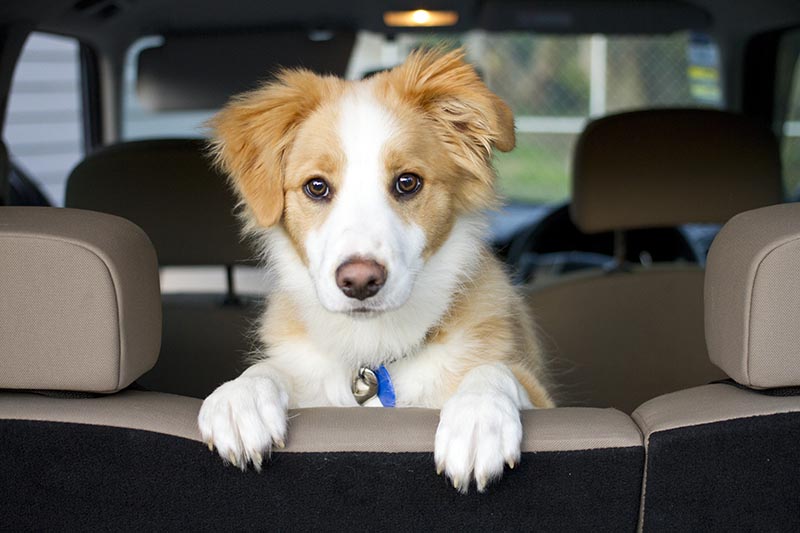
Vet approved
Reviewed & Fact-Checked By
Dr. Lauren Demos
DVM (Veterinarian)
The information is current and up-to-date in accordance with the latest veterinarian research.
Road trips are a great way to get out of the house and enjoy time away from work by exploring. They’re even better when you can take your canine best friend along.
Cars aren’t inherently geared up to be safe for dogs, though, and there are a few things that you need to sort out before you let your dog join you on a long trip. Investing in a sturdy dog seatbelt 1 and making sure the doors and windows are secure are essential, for example.
There are also a few other adjustments to your travel plans that you’ll need to consider to ensure that the journey is as fun for your dog as it is for you.
The 11 Great Tips for Traveling With a Dog in a Car
1. building up to longer trips.
To make a long car ride more comfortable for you and your dog, it’s best to build up their tolerance. Start with short drives around the neighborhood. This will help introduce your dog to the feel of the car in motion and give you an idea of how well they handle car rides in general.
Getting used to the car will help ease their nerves about trips. If they’re a puppy that has never been in a car or they associate car rides with veterinary visits, you need to teach them that car rides are a good thing.
2. Seatbelts or Restraints
For the safety of you, your dog, and everyone else on the road, it’s best if you have a way to keep your dog restrained while the car is in motion. This is important whether you’re driving alone with your dog or you have passengers who can keep them out of trouble for you.
Dog seatbelts are one way to accomplish this. These can either be leashes with seatbelt attachments or straps that hook over the headrest and attach to your dog’s harness. You can also use a dog crate or car seat to keep your dog in one place.
Not only does restraining your dog keep them from jumping around the vehicle while it’s moving, but it’ll also keep them and other passengers safe during an accident, along with helping emergency services tend to the injured without a scared, loose dog threatening their safety.
3. Empty Stomach
Dogs can get carsick just like we do. If you know that your dog suffers from car sickness or just want to make the ride as comfortable as possible for sensitive stomachs, don’t feed them as much before you set out.
For longer car trips, give your dog a small, light meal a few hours before you set off. This will digest easily and still keep your hungry pooch happy while they’re cooped up in the car.
Avoid feeding them big meals during the journey. Take along snacks that they can chew on, but otherwise, wait to feed them their dinner until you’ve reached your destination.
4. Plenty of Water
It might be a bad idea to let your dog eat big meals during car rides, but you need to make sure they drink plenty of water. Driving long distances can make it easy to forget to take breaks, and your dog is unlikely to have free access to water while the car’s moving, especially if you don’t want water spilling everywhere.
Pack a few water bottles and a travel-sized water bowl for your dog, and offer them water every time you stop at gas stations or rest stops. This is especially important if your dog doesn’t like to drink while the car is in motion.
5. Regular Potty Breaks
Car rides can be uncomfortable and boring, for your dog and for you. You might be able to keep yourself distracted from long drives by listening to the radio or chatting with your passengers, but your dog won’t be able to play while they’re restrained in a crate. While you can give them their favorite toys to play with, nothing works as well as taking frequent breaks.
Stopping at rest stops regularly enables you to stretch your legs, take a break from driving, and give your dog much-needed playtime. They’ll be able to go to the bathroom, drink water, and explore for a bit.
A vigorous game of fetch might even wear your dog out enough that they sleep through most of the trip.
6. Not Leaving Them Unattended
Summer, cars, and dogs don’t mix well. Never leave your dog in a locked car unattended, even for just a few minutes. Cars quickly become far too hot on sunny days, and your dog has a fur coat to worry about too. The opposite is true on frigid winter days. Without the heating running in the car, your dog will quickly get too cold.
It’s not just the health of your dog that you should consider. A well-meaning bystander who sees a dog left alone in a car might smash the window to get them out, even if you’ve only been gone for a few seconds.
7. Canine Travel Kit
Whether you’re taking a week-long road trip or just heading out for the day, you’re likely to only pack a few essentials . If you’re traveling alone, this can be limited to one or two small bags. Once your dog is included, though, there are a few other essentials that you need to consider.
Your canine travel kit should include all the basics: poop bags, a collapsible water dish, a dog first aid kit, your dog’s favorite toy, a few chews, and their favorite treats to snack on while you drive. You may also want to take health and vaccination records with you.
The best part is that most of these doggy essentials are lightweight. If you use a harness, you can attach small bags to it, so your dog can carry their own travel kit and everything that they need is always close at hand.
8. Microchipping Your Dog
Your dog should already have a collar and ID tag with your contact information on it, but these aren’t infallible. If your dog loses their collar or tag for any reason, there will be no way for strangers to identify your dog if they get lost. A microchip is a permanent form of identification that is always with your dog.
While it’s not pleasant to consider the possibility of your dog getting lost during your road trip, a microchip will increase the odds of them getting back to you quickly. If someone finds them and takes them to a veterinarian or a shelter, whoever scans the microchip will be able to contact you and get your dog back home.
9. Closed Windows
Many people love to let their dogs stick their heads out of the car windows during long drives. It can be cute and many dogs enjoy it, but it’s a dangerous habit to let your dog develop.
When you’re driving — whether on slow back country roads or busy highways — the wheels kick up a large amount of dirt from the road, and dust can get thrown around by other cars. There’s also the risk of an unrestrained dog spotting a squirrel on the side of the road that they simply must get to immediately.
If you do want to keep the windows open, don’t open them far enough to let your dog stick their head out. Or, only open the windows that your restrained pet can’t reach.
10. No Rides in an Open Truck Bed
Dogs can get muddy and horrifically smelly when you’re adventuring together. In these cases, riding in an enclosed car with them isn’t pleasant. You shouldn’t use this as an excuse to let them ride in the open bed of your truck, though. Packing dry shampoo or wet wipes is often enough to get your dog smelling good enough until you’re back home, or you can even bring a makeshift shower head for on-the-go baths.
If you don’t have enough room in your truck’s cabin for everything that you need to take and your dog, reconsider if you need everything that you’ve packed, find alternative transport, or ask someone to look after your dog while you’re away.
While it’s always sad leaving a dog behind, it’s far safer than risking a serious injury or death by letting them ride in the back of the truck.
11. Local Veterinarians
If you’re in an unfamiliar town, locating a veterinarian can be stressful during emergencies. Unfortunately, accidents happen, and planning ahead is the best way to make a horrible situation easier to handle.
Before you head out on your trip, plan your route. Make a note of all the places that you can stop at for potty breaks and to sleep overnight. For each place, keep a list of numbers for the nearest 24-hour veterinary clinics, especially if you’re unfamiliar with the area you’re road-tripping through. If you’re heading out for a day trip, keep your destination’s local veterinarian’s number handy.
While this might seem excessive, if your dog does get into an accident, you’ll be prepared to handle it.
Final Thoughts
Traveling is fun but stressful , particularly when your dog tags along. While there’s nothing better than going on an adventure with your furry friend, it’s important to keep them safe too. These tips not only will help you keep your dog safe during car rides but also as comfortable as possible. We hope that we have helped you plan for your next trip with your dog!
Related Reads:
- Is It Safe for Dogs to Fly? Flight Options & Preparation
- Benefits of Traveling With Dogs: 10 Advantages & Tips For Your Trip
- https://www.animaltrust.org.uk/blog/how-to-travel-in-the-car-with-your-dog/
- https://www.akc.org/expert-advice/home-living/complete-guide-to-traveling-with-your-dog/
Featured Image Credit: Aarontphotography, Shutterstock
Related Articles
Further Reading
What Is a Wolf Dog? What Science Tells Us
Jan 17, 2024 - 5 min read
Why Does My Dog Bark at a Specific Person: 7 Vet Reviewed Reasons & Solutions
Mar 28, 2024 - 5 min read
Bichon Frise Pros & Cons: What To Consider Before Bringing One Home
Jan 15, 2024 - 6 min read
Vet Articles
Latest Vet Answers
The latest veterinarians' answers to questions from our database
7 Neurological Issues in Dogs & Common Signs to Keep in Mind (Vet Approved)
Answered by Dr. Chantal Villeneuve, MS BVetMed (Vet)
Can Two Male Betta Fish Live Together? Our Vet Explains
Answered by Dr. Luqman Javed, DVM (Vet)
Betta Fish Popeye: Causes, Signs, & Treatment Explained By Our Vet!
How to Check a Dog’s Heart Rate: Our Vet’s Tips, Tricks, & Guide
Can Dogs Eat Barley? Our Vet Explains The Nutrition Facts
What to Feed Betta Fish Fry: Our Vet’s Feeding Guide & Growth Tips!
Cat food recalls
Have a cat? Stay on top of cat food recalls here >
Dog food recalls
Have a dog? Stay on top of dog food recalls here >
Have a question? talk to a vet online for advice >

Travel safely with your pet
Tips to keep your pet safe while transporting them by car, airplane, ship or train
When making travel decisions, choose what is safest and most comfortable for your pet. For instance, unless you'll be able to spend a lot of time with your dog, they'll probably be happier at home than tagging along on your trip. As a rule, cats are almost always better off in their own home. But if you have decided it's best to bring your pet along, follow our tips for a safe and low-stress trip!
Do you know the best place for your dog or cat in your car?
Dogs shouldn't roam in the car
The safest way for your dog to travel in the car is in a crate that has been anchored to the vehicle using a seat belt or other secure means. Dog restraints or seat belts are useful for preventing your dog from roaming around the car and being a distraction to the driver, but they haven't been reliably shown to protect dogs during a crash.
Cats belong in carriers
Most cats aren't comfortable traveling in cars, so for their safety as well as yours, keep them in a carrier. It's important to restrain these carriers in the car so that they don't bounce around and hurt your cat. Do this by securing a seat belt around the front of the carrier.
Leave the front seat for humans
Keep your pet in the back seat of the car. If an airbag deploys while your pet is in the passenger seat (even in a crate), it might injure your pet.
Keep those heads inside
Dogs and cats should always be kept safely inside the car. Pets who are allowed to stick their heads out the window of moving vehicles can be injured by particles of debris or made sick by having cold air forced into their lungs. Never transport a pet in the back of an open pickup truck.
Give your pet plenty of rest stops
Stop frequently to allow your pet to exercise and eliminate, but never permit your pet to leave the car without a collar , ID tag and leash.
Bring along a human buddy
Whenever possible, share the driving and pet caretaking duties with a friend or family member. You'll be able to get food or use the facilities at rest stops knowing that someone you trust is keeping a close eye on your pets.
Don't ever leave your pet alone in a car
A quick pit stop may feel like no time at all to you, but it's too long to leave your pet alone in a car. Heat is a serious hazard: when it's 72 degrees Fahrenheit outside, the temperature inside your car can heat up to 116 degrees within an hour. On an 85-degree day, even with the windows slightly open, the temperature inside your car can reach 102 degrees in just 10 minutes. Even if you’re certain of your timing, you can get held up — in just 30 minutes, you could return to a 120 degree car and a pet suffering irreversible organ damage or death.
If you see a pet left inside a hot car, take these steps to help them.
Spread the word about the dangers of leaving pets in a hot car by printing our Hot Car flyer [PDF] , posting it in public places and sharing it with your friends, family and coworkers.
Another hazard of leaving your pet in the car alone is the possibility of someone stealing your pet while you are away from the vehicle.
Use our checklist to assemble an emergency kit for yourself and all your pets. During disasters, creating an emergency plan can be a lifesaver.
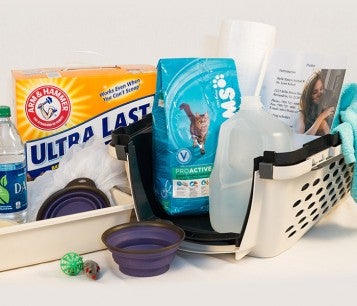
By airplane
Before booking a flight for your pup, you’ll want to think through all your options.
Air travel can be risky for pets
We recommend that you weigh all the risks when deciding whether to transport your pet by airplane. Air travel can be particularly dangerous for animals with "pushed in" faces (the medical term is "brachycephalic"), such as bulldogs, pugs and Persian cats. Their short nasal passages leave them especially vulnerable to oxygen deprivation and heat stroke.
Consider all the alternatives to flying
If you plan to bring your pet on vacation, driving is usually a better option. If you can't travel by car, your pet will probably be healthier and happier if you leave them behind under the care of a pet-sitter or boarding kennel. But there are times when that won’t be possible and you’ll have to determine whether the benefits of flying outweigh the risks.
Visit your vet
Most airlines require a health certificate for animals, typically issued within 10 days of travel. This is also a good time to ensure your pet’s vaccinations are up to date and that they aren’t battling any illnesses that could be exacerbated by heat or stress.
Research your destination
If you’re flying internationally, or even to Hawai'i, your pets may need to be quarantined upon arrival. They may also require import forms. Familiarize yourself with the requirements, where they’ll be quarantined and for how long.
If you decide to fly with your pet, choose the cabin when possible
If transporting your pet by air is the only option, find out whether they can travel in the cabin with you. Most airlines will allow you to take a cat or small dog in the cabin for an additional fee. But you must call the airline well in advance; there are limits to the number of animals allowed in the cabin. If you are transporting your dog, make sure they meet the size requirements. If you get overwhelmed by all the regulations, there are companies that can help you navigate through the process of flying with a pet.
Ask these questions if your pet is flying in the cabin
When you contact the airline, be sure to get clear answers to these questions:
- Will the airline allow you to take your cat or small dog in the cabin with you?
- Does the airline have any special pet health and immunization requirements?
- Does the airline require a specific type of carrier? Most airlines will accept either hard-sided carriers or soft-sided carriers (which may be more comfortable for your pet), but only certain brands of soft-sided carriers are acceptable to certain airlines.
- If you can't take your pet in the cabin, does the airline have any restrictions on transporting your pet in the cargo hold?
Take precautions when bringing your pet through airport security
Your pet's carrier will have to pass through the security screening along with you. You have two options: Either be sure your pet is securely harnessed so you can safely contain them outside their carrier while it's being x-rayed, or request a special secondary screening that won't require you to take them out of their carrier.
Be aware of the dangers of flying your pet in a cargo hold
While most animals flown in the cargo area of airplanes are fine, you should be aware that some animals are killed, injured or lost on commercial flights each year. Excessively hot or cold temperatures, poor ventilation and rough handling are often to blame.
Most U.S. airlines are required to report all companion animal incidents that occur in the cargo hold, and consumers should study the performance record of any airline before choosing to fly your pet in a cargo hold.
Follow these tips if your pet must fly in the cargo hold
If your pet must travel in the cargo hold, you can increase the chances of a safe flight for your pet by following these tips.
- Use direct flights. You will avoid the mistakes that occur during airline transfers and possible delays in getting your pet off the plane.
- Travel on the same flight as your pet when possible. Ask the airline if you can watch your pet being loaded into the cargo hold and unloaded.
- When you board the plane, notify the captain and at least one flight attendant that your pet is traveling in the cargo hold. If the captain knows that pets are on board, they may take special precautions.
- Don't ever ship brachycephalic animals such as Pekingese dogs, bulldogs or Persian cats in the cargo holds .
- If traveling during the summer or winter months, choose flights that will accommodate the temperature extremes . Early morning or late evening flights are better in the summer; afternoon flights are better in the winter.
- Fit your pet with a collar that can't get caught in carrier doors. Affix two pieces of identification on the collar: a permanent ID with your name and home address and telephone number, and a temporary travel ID with the address and telephone number where you or a contact person can be reached. Make sure your pet’s microchip information is up to date.
- Affix a travel label to the carrier on which you've written your name, permanent address and telephone number, final destination and where you or a contact person can be reached as soon as the flight arrives.
- Make sure that your pet's nails have been clipped to protect against them getting hooked in the carrier's door, holes and other crevices.
- Give your pet at least a month before your flight to become familiar with the travel carrier . This will minimize their stress during travel.
- Do not give your pet tranquilizers unless they are prescribed by your veterinarian. Make sure your veterinarian understands that the prescription is for air travel.
- Do not feed your pet for four to six hours before the trip. However, you can give them small amounts of water. If possible, put ice cubes in the water tray attached to the inside of your pet's crate or kennel. (A full water bowl will only spill and cause discomfort.)
- Try not to fly with your pet during busy travel times such as holidays and the summer . Your pet is more likely to undergo rough handling during hectic travel periods.
- Carry a current photograph of your pet . If your pet is lost during the trip, a photograph will make it much easier for airline employees to search effectively.
- When you arrive at your destination, open the carrier as soon as you are in a safe place and examine your pet. If anything seems wrong, take your pet to a veterinarian immediately. Get the results of the examination in writing, including the date and time.
Speak up if you see something
Don't hesitate to complain if you witness the mishandling of an animal—either yours or someone else's—at any airport. Ask to speak with the manager of the section where the incident occurred and report mishandling both in person and in writing.
With the exception of assistance dogs, pets are welcome on only a few cruise lines—and usually on ocean crossings only. Some lines permit pets in private cabins, but most confine pets to kennels. Contact your cruise line in advance to find out its policies and which of its ships have kennel facilities. If you must use the ship's kennel, make sure it is protected from the elements and check on your pet frequently.
Amtrak now allows some pets on select trains and service animals are allowed on all lines. Some smaller U.S. railroad companies may permit animals on board. Many trains in European countries allow pets. Generally, it's the passengers' responsibility to feed and exercise their pets at station stops.
Didn't find what you need? Use the search!
Pet Keen is reader-supported. When you buy via links on our site, we may earn an affiliate commission at no cost to you. Learn more .
How to Travel by Car With Your Dog: 10 Vet-Approved Tips for Safety & Comfort
Vet approved
Reviewed & Fact-Checked By
Dr. Paola Cuevas
Veterinarian, MVZ
The information is current and up-to-date in accordance with the latest veterinarian research.
We often grow so closely attached to our dogs that it’s hard to imagine a trip or vacation without them. Instead of leaving our beloved pets with a sitter, it’s sometimes more manageable to bring them along for the ride. That said, traveling can be a stressful time for both you and your pet when you aren’t prepared. When you come up with a travel strategy in advance, the journey becomes much more enjoyable.
Whether traveling for pleasure or necessity, there are crucial steps that you must take to prepare for your dog’s needs. Taking the family pet on the road makes the experience more fun for everyone involved, but you want your dog to be as stress-free as possible while you head to your next destination.
- Preparing to Travel by Car With Your Dog
The vet’s office isn’t just for yearly checkups and emergencies. Always take your animal to the vet for a checkup before going on a trip. The vet will make sure your dog’s vaccinations are up to date and supply you with a health certification if you’re traveling across a border. On top of that, veterinarians are equipped with tools and advice for traveling with pets, and they may bring up valid points that you would have missed if you didn’t make the appointment.
You should always be prepared for a road trip emergency and check for a 24-hour hospital at your final destination. If traveling by car, look up a few veterinary clinics on your route so there is always an option in case anything goes wrong.
The last thing that you want to deal with is a lost dog in unfamiliar territory. Make sure both your dog’s leash and collar have tags with the dog’s name, your name and number, and proof of a rabies shot. Give all the information to your vacation host, too so they can pass along the details if necessary. Keep an up-to-date photo of your dog with you, and have a copy of their health records on hand.
The 10 Tips on How to Travel by Car With Your Dog
Preparing for a big trip is already anxiety-inducing, and the stress only gets worse when you have one of your most beloved family members hitting the road with you. These traveling tips can help you out.
- 1. Keep Your Dog Restrained
We have seat belts to keep us safe, and your pet should also have a security measure in place. A dog crate is a smart way to keep your dog secure and protected while on a road trip. It’s also easy to move in and out of buildings, and you can keep your dog out of trouble if you’re staying in a hotel.
Only use a large enough crate that your pet can stand, sit, and lie down in. Try to get a crate with a leak-proof bottom that you can fill with absorbent material in case they have any accidents in the car. Ventilation is highly important, and there shouldn’t be anything blocking the holes that enable air to flow into the crate.
To make your dog more comfortable, throw in a few of their favorite toys, a comfortable mat or bed, and a water bottle in case they get thirsty.
- 2. Get Them Accustomed to Travel
It’s not a wise idea to take your dog on a 10-hour road trip if they’ve never been in your car for longer than 15 minutes. The experience will be better for all involved if you take them on short trips a few months before the big vacation.
Set up your car so your dog is traveling in the same way that it will be for the final journey. On each short trip, gradually increase the amount of time that you spend in the car. Eventually, your dog will grow accustomed to the travel, and the longer trips will be a breeze.
- 3. Stop to Feed Your Dog
Trust us when we say that it’s never a good idea to feed your dog while the car is moving. If sudden car sickness comes on, you’re one turn away from having to stop to clean up vomit.
Give your dog a meal 3 to 4 hours before you hit the road. Whenever it is time for them to eat again, always pull the car over and stop to let them eat and take a bathroom break before resuming.
- 4. Don’t Leave Your Dog in the Car
Do not ever leave your dog in a car unattended. It is a sure way to make your dog freeze or overheat, and it could have deadly consequences. Also, a passerby might view your choice to keep the dog in the car as a poor one and break your window in order to free them.
- 5. Pack a Bag for Them
Humans aren’t the only family members who should have luggage on this trip . You should be prepared for any situation, and there are essential items that you should have stashed in one safe place . Include your pet’s most recent immunization and health records, food, water, bowls, and medications. It’s also smart to come prepared with cleaning supplies, waste bags, and a few toys so they don’t get bored. Last but not least, a pet first-aid kit is a wise investment if you haven’t already bought one.
- 6. Have a Way to Identify Your Pet
You might want to consider getting your dog microchipped if the vet hasn’t already done so. Aside from a collar that could come loose, microchips are embedded into the dog’s skin. If your pet were to get loose and someone took them in, most places would check for a microchip so they can get in contact with you about their whereabouts. If possible, get your dog a GPS tracker so you know where to find them in case they get lost.
- 7. Don’t Let Them Stick Their Head Out the Window
It seems like a fun idea to let your dog feel the breeze blowing through their fur , and we won’t deny that it’s cute, but this puts your pet at major risk of injury. They could get struck by other passing cars, thrown from the vehicle if in a crash, or fall out of the car while it’s moving at high speeds. Your number-one concern on your trip should be safety for all, and that includes your furry friend.
- 8. Have Plenty of Water on Hand
You don’t want your dog drinking from an unfamiliar source on the side of a parking lot. It’s less stressful if you have a case of water in your car that you can grab whenever your dog is feeling thirsty. This way, they get a freshwater source, and you don’t have to go searching for somewhere they can get a drink.
- 9. Protect Your Car
With shedding fur, long nails, and anxiety at an all-time high, it’s a good idea to invest in car seat covers or mats that can protect your car’s interior from damage . You never truly know how your dogs will react while traveling, and the last thing that you want to do is to pay for repairs.
- 10. Ask Your Vet for Medicine
Some dogs travel better than others , and if your pet has a great deal of anxiety, your veterinarian may be able to prescribe helpful medication to ease that anxiety while traveling. These medicines can work wonders if you have a nervous dog, and they can make the trip more enjoyable for you too.
- Final Thoughts
Traveling is exciting, stressful, and demanding all at the same time. The only way to make the ride go as smoothly as possible with your dog is to prepare, prepare, prepare! Envision the entire trip, and try to think of every situation that could happen. You want to be able to handle whatever life throws your way, and if you’re already one step ahead, you’re going to experience a much better car ride with your furry family member than if you winged it from the beginning.
- 15 Tips for Making Your Dog’s First Vacation a Success
- 10 Best Dog-Friendly Vacation Destinations in Canada
Featured Image Credit: Andrey_Popov, Shutterstock
Nicole Cosgrove
Lead Pet Expert & Pet-ditor in Chief
Related articles
When will my labradoodle calm down facts & faq, how much exercise does an australian shepherd need vet approved advice.
Search our database of over 16755 posts with up-to-date information from our experts and veterinarians.
Want to talk to a vet online?
Whether you have concerns about your dog, cat, or other pet, trained vets have the answers!
10 Tips for Traveling With Your Dog

John M. Vincent | U.S. News & World Report
Tips for Taking Your Pet on a Road Trip
Many of us think of our pets as members of the family and can’t fathom the idea of leaving our furry friends behind as we go on vacation. However, taking Rover on a road trip with you isn’t as simple as jumping in the car and heading cross-country.
Advertisement
Successful car travel with your pet takes some planning, some patience, and some flexibility. You’ll need to think about them when you plan what vehicle you take, where you stay, how often you stop, and how long you can drive each day.
On the following slides, we explore some tips to make the travel experience pleasant for everyone in the family. We'll focus on traveling with dogs, but much of the advice also applies to cats and other critters.
Vacationing with a pet can be an amazing bonding opportunity, especially if your itinerary takes you to some of the spectacular destinations this country has to offer. While the tips in this slideshow might sound excessive, they can help ensure that you’ll both have a memorable time.

Jodi Jacobson | Getty Images
Make Sure Your Pet Is Up for the Trip
The last thing that you want to find out an hour into your family’s epic 10-day adventure to Yellowstone is that your dog gets car sick every time you turn a corner. Some pets aren’t healthy enough or don’t have the temperament for traveling, and it’s not a smart idea to force them to.
Starting at least a few weeks before the big trip, start taking your animal on short car rides, taking care to use the crate or harness that you’ll be using on the road trip. Don’t assume because your last dog was great in the car that her puppies will be too. Aging dogs may also be less comfortable on long road trips than they were during their younger years.
“They may be anxious if they only travel a couple of times a year to the veterinarian,” says Dr. Mike Topper, president of the American Veterinary Medical Association, adding “Every animal is different.”
Experts suggest doing everything you can to make their crate a happy place where they are comfortable and want to ride. Put familiar blankets and favorite toys inside the car kennel, and reward your dog for using it. Never force your dog into the box.
There’s often a lot of chaos in a household when families are preparing for trips. Animals tend to get more anxious when there’s a whirlwind of activity around them, so you’ll want to take special care to make sure they can remain calm and comfortable in the days leading up to the trip.

Robert Daly | Getty Images
Check Those Tags and Microchips
Before you hit the road, you’ll want to make sure your dog has tags with up-to-date information and a microchip that is registered and current. Nobody expects their pooch to escape during a trip, but it happens, and you want to maximize the chance of getting Rover back.
A pet microchip is a small transponder, about the size of a grain of rice, that a veterinarian injects under your animal's skin. It has a registration number that can be read using a scanning tool and linked to your contact information. Make sure the microchip company has your current cell phone number on file, as having them call your home phone while you are on the road won’t help reunite you with your puppy.

Jamie Page Deaton | U.S. News & World Report
Pick the Right Ride
People who spend hours on the road want vehicles that are comfortable and safe. Those same two factors apply when you’re considering your four-legged best friends. If you have a Chihuahua, the right ride might be a Honda Fit . A pair of Saint Bernards? A Chevy Tahoe’s cabin might be more appropriate.
A two-seat convertible is almost never an appropriate car to use when transporting a pet, unless you have a carrier that can be secured on the passenger-side floor. Airbags are designed for humans but can be devastating to animals. Likewise, putting your dog loose in the bed of a pickup truck isn’t a good idea for either its safety or comfort.
Looking for a pet-friendly new ride? Check out our story on the best cars for dogs .
More on the 2017 Chevrolet Tahoe
- See 2017 Chevrolet Tahoe Photos »
- Find 2017 Chevrolet Tahoe For Sale »
- Read the 2017 Chevrolet Tahoe Full Review »
- See 2017 Affordable Large SUV Rankings »

Banks Photos | Getty Images
Keep Them (and You) Safe on the Road
Having loose animals in the car is never a good idea. Not only can they distract you and get into things that they shouldn't, but they can also be injured or killed if you stop suddenly or get into an accident. Unrestrained, they can become missiles, injuring you or your passengers.
An 80-pound pet colliding with your seat at 30 mph exerts 2,400 pounds of force. Unrestrained pets can also be ejected into traffic, endangering themselves and other motorists.
The two best ways to restrain your pet are harnesses and crates. Many harnesses easily attach to a car’s LATCH child car seat anchors, so you should make sure when you’re shopping for a car that the LATCH hardware is easily accessible. Tying your dog's leash to a seat belt or something else in the car can be dangerous to both you and your pet in case of an accident.
The Insurance Institute for Highway Safety (IIHS) evaluates the ease of use for LATCH hardware, and you can see how any tested vehicle rates at IIHS.org . The 2017 Audi Q7 , Lexus RX , and Toyota Prius all earn the IIHS’ Good+ rating for their child seat anchors.
If you have an SUV or crossover, you’ll want to strongly consider having your dog ride in a crate, making sure the carrier is firmly strapped down. Not only does it give your dog a comfortable, private space, but it also keeps them contained in case of an accident. Many pets are lost each year when they flee the chaotic scene of a traffic accident. Be careful that your dog’s tags or collars can’t get caught in the grates on the crate’s door or windows. Many experts suggest taking their collar off when they go into the crate, and putting it back on before you let them out.
The Center for Pet Safety studies the pet restraint systems on the market and has certified a number of products for their ability to safely contain and protect animals during simulated crashes. Their list of approved products can be found at centerforpetsafety.org .
Watch where the sun is hitting your car and make sure the area where you are keeping your pet is well-ventilated. While the driver’s seat might be in the shade, sun streaming in the back window of your SUV can overheat your pet.
Don't ever let your dog hang their head out the window. First, if it can get its head out, the window is probably open far enough that it can get the rest of its body out if it sees something it wants to get to. Second, bugs, rocks, and other road debris can destroy your pup's vision.
More on the 2017 Lexus RX 350
- See 2017 Lexus RX 350 Photos »
- Find 2017 Lexus RX 350 For Sale »
- Read the 2017 Lexus RX 350 Full Review »
- See 2017 Luxury Midsize SUV Rankings »

Proxima13 | Getty Images
Pack Their Food, Medications, and Water
When you are traveling with your pet, you want to pack plenty of their food. There’s enough stress placed on our furry friends with travel, and you don’t want to change up their eating habits when you’re on the road. Take a bit extra in case your return home is delayed.
It’s better to take it from your supply at home than buy it on the road, as some pet manufacturers source the ingredients from various suppliers in different parts of the country. The pet food you find in one state might be different than the food in the same packaging somewhere else. Your dog’s sensitive stomach might take notice.
You’ll also want to take plenty of water along, either in jugs from the tap at home or bottled water. Animals can be more sensitive than humans to what’s in the water, and you don’t want issues with their tummies upsetting your trip. Buying bottled water for your pet might sound like an indulgence, but it’s a whole lot better than traveling with a dog that has intestinal issues.
When the helpful desk clerk offers your dog a biscuit when you check into your hotel for the night, you might want to decline politely. Without knowing the source and quality of the treat, you don't want to take a chance of making your pet ill.
The 2017 Chrysler Pacifica minivan has Stow ‘n Go middle seats. When the seats are up, there are generous-sized in-floor storage bins that make a great place to store extra dog food and water out of the sun.
Bottom line: Keep your pet’s food, water, and treats consistent, and feed them at the same times you would feed them at home.
Don’t forget to take an ample amount of your pet’s medications with you, plus a copy of their prescriptions in case you have to get more while you’re on the road.
More on the 2017 Chrysler Pacifica
- See 2017 Chrysler Pacifica Photos »
- Find 2017 Chrysler Pacifica For Sale »
- Read the 2017 Chrysler Pacifica Full Review »
- See 2017 Minivan Rankings »

marcoventuriniautieri | Getty Images
Take Time for Breaks
While your bladder may be able to make the run from Raleigh to Orlando with hardly a break, your dog might not be as comfortable with your goal. You should probably plan to stop every couple of hours to relieve your puppy and let them stretch their legs.
Many vehicles, including the 2017 Volvo XC90 and Mercedes-Benz E-Class , feature a system that senses when the driver is getting sleepy. If you’ve been behind the wheel so long that it’s time for you to take a break, your pet would probably appreciate one too. A short walk would be beneficial for both of you.
You might also want to plan a slightly less ambitious travel schedule than you might otherwise envision. Leave plenty of time each morning and evening to take your dog for a long walk. Making them a bit tired will help keep them calm in the car and quiet in the hotel room. Stretching your own legs will also prepare you for a long drive.
More on the 2017 Volvo XC90
- See 2017 Volvo XC90 Photos »
- Find 2017 Volvo XC90 For Sale »
- Read the 2017 Volvo XC90 Full Review »

Ken Gillespie Photography | Getty Images
Plan for Dog-Friendly Lodging
Don’t assume that every hotel or campground will accommodate your pet. Many won’t, and some that do will charge you exorbitant fees to welcome Fido. Some have weight limits or won’t host some types of animals or breeds of pets. Call the property directly to verify their pet policy before you go.
There are several websites that offer resources for travelers with four-legged companions. PetsWelcome.com , BringFido.com , and GoPetFriendly.com have extensive listings of pet-friendly properties across the country.
If you’re already on the go, vehicles with internet-connected navigation systems, such as the Audi A4 or any vehicle with Apple CarPlay or Android Auto , can automatically dial your phone so that you’re able to check with hotels on your route and find out about their pet policies.
Some hotel chains have exceptional pet travel policies. Kimpton Hotels welcomes pets to all of its properties with no additional fee. The La Quinta chain of more than 800 properties only has a few locations that charge a pet fee and allows up to two domestic pets per room.
It’s a good idea to use your car’s pet carrier or another soft kennel while you’re in the hotel room. Not only is your pet likely to be comfortable there, but it’s safer too. Before you let your doggy roam about the room, check around the room and under the bed for dangerous or disgusting things the housekeeper might have missed. A dropped pill from a previous guest might escape the vacuum cleaner, and it could be fatal to your pet.
For the sake of fellow travelers who visit at the same time as you and after you, it’s important to be a responsible pet owner. Have their favorite toys, treats, or peanut-butter-filled Kong toys to keep your dog from barking in the hotel room. Clean up after your pet both in the room and on the hotel grounds.
More on the 2017 Audi A4
- See 2017 Audi A4 Photos »
- Find 2017 Audi A4 For Sale »
- Read the 2017 Audi A4 Full Review »
- See 2017 Luxury Small Car Rankings »

MichaelSvoboda | Getty Images
Make Sure Your Beagle Is Legal
If you are traveling across state or international borders, you will need a health certificate for your pets. Just a few days before you leave, take your pet to the vet so they can be checked out and receive a health certificate. It’s a form that veterinarians routinely issue.
A health certificate is also required for any part of your itinerary that involves flying on a commercial airline.
While you’re at the vet, it is also a good idea to get a record of any vaccinations your pet has received, and any medications it requires. Paper copies of your pet’s prescriptions are handy if you have to refill them when on the road.
“It’s always good to travel with information about any condition that your pet may have," says Topper.
Some communities enforce regulations on certain breeds of dogs. Check with any city that you plan to stay overnight in to ensure that it is legal to have your dog there. Some have leniency for pets that are just traveling through, but others might seize your pet if they deem it to be a banned breed.

Image taken by Mayte Torres | Getty Images
Keep an Eye on Your Pet at All Times
Just as visiting new places is exciting for you, it’s also exciting for your pet. Keep your dog on leash at all times, because if they see something new and fascinating, the perfect "come" you have at home won’t bring your dog back.
Dogs tend to explore with their nose and not their eyes. With their nose on the ground, they can quickly get into trouble, whether from that wrapper that's covered in melted chocolate or that critter that's just interesting back at home but poisonous in the desert southwest.

Irfan Khan | Contributor
Don’t Leave Your Pet in a Parked Car
Finally, in the hustle and bustle of travel, it’s often easy or convenient to leave your pet in the car. Unless you’re in a secure, cool, and covered parking garage, it’s a horrible mistake. It takes only a few minutes for a car’s interior temperature to climb to a fatal level.
More and more places are making it illegal to leave a pet in a hot car. If you leave your pet inside, you might come back to a car with a broken window, no pet, and a police officer with handcuffs at the ready.
Many Chevrolet , Buick , GMC , and Cadillac vehicles now come with a Rear Seat Reminder system. If you use the back door to load your pet into the car, you'll get a reminder to check the back seat the next time you turn the engine off.
More on the 2018 GMC Terrain
- See 2018 GMC Terrain Photos »
- Find 2018 GMC Terrain For Sale »
- Read the 2018 GMC Terrain Full Review »
- See 2018 Affordable Compact SUV Rankings »

U.S. News and World Report |
Car Shopping Tools From U.S. News & World Report
Traveling with your four-legged best friends can be an exciting experience, especially if you have a great car and a sensational itinerary. Use our new car rankings and used car research to find your next ride and U.S. News & World Report’s Travel Rankings to find your next adventure.
You can save some money for your next trip by taking advantage of special new car deals. Explore our financing incentives and lease deals pages to see the best offer our professional researchers and journalists have discovered this month. Our Best Price Program can save you even more. On average, buyers save $3,279 off MSRP by using the program, which links them to guaranteed savings at local dealers.
Browse Cars

Recommended Articles

Best Truck Lease Deals
Kristen Hall-Geisler May 7, 2024

Best 0% Car Deals
George Kennedy May 7, 2024

Best Luxury SUV Lease Deals

Best SUV Lease Deals Under $300

Best SUV Lease Deals
George Kennedy May 6, 2024

Best Sports Car Deals
Caroline Anschutz May 6, 2024
Traveling With Dogs In The Car Safely
Road trips can be a lot of fun, and staying safe while traveling in your car is a priority. We all think about wearing our seatbelts and following the rules of the road. But how often do you think about how to keep your dog safe in the car? Focusing on traveling safely with your pup in the car will help you all have a better time and enjoy your trip.
Last Updated: January 24, 2024 | 4 min read | Leave a Comment
When you purchase through links on our site, we may earn a commission. Here’s how it works .
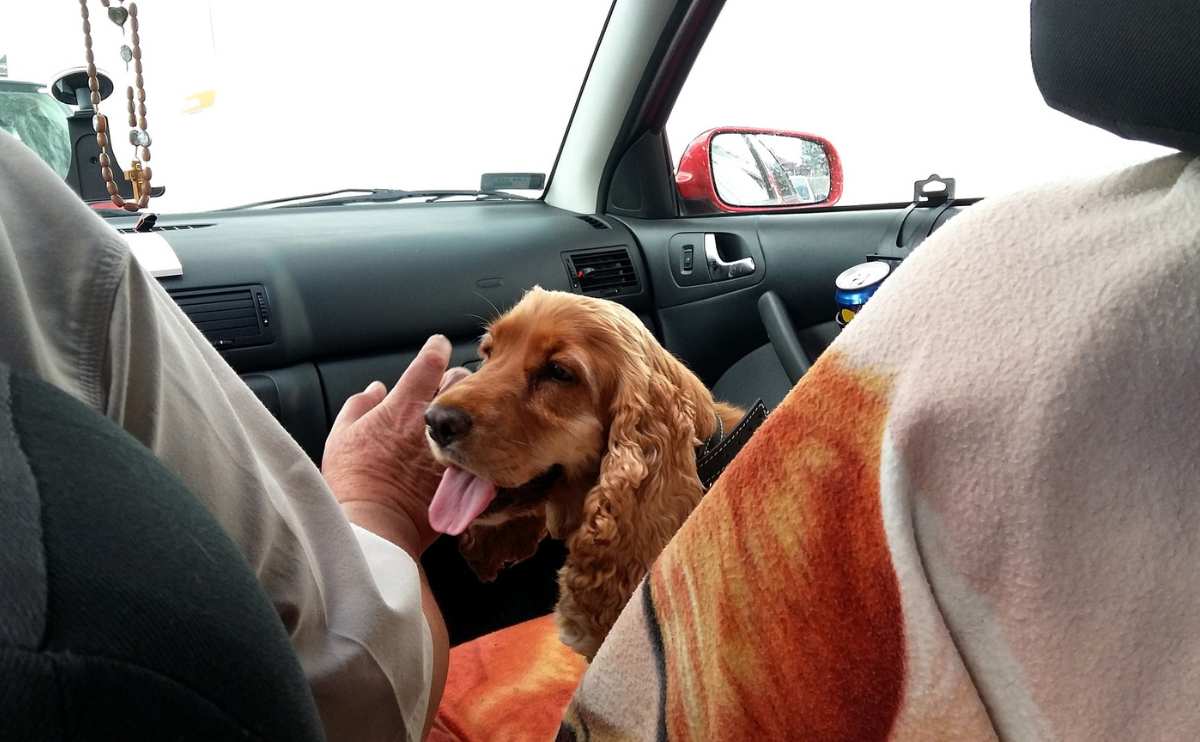
Traveling With Dogs Safely
While it may be fun to have your pup riding shotgun while you cruise down the highway, it isn’t the safest choice for you or him. You may want to consider easing your dog into a car trip and securing your dog in a safe place in the car. Below are our recommendations on how to travel safely with your dog in your car.
Never Leave Your Dog Unattended In Your Car
It’s unsafe to leave your dog in the car alone, especially in the summer , when he could easily overheat in a matter of minutes in a car. Even slightly cracking your car windows isn’t safe.
Start Small

Small trips can give you a feel for how your pup does in the car. It can also help you figure out if your dog is dealing with car sickness or anxiety before you work up to a longer trip.
Your Dog Is Safer When Restrained
Along with dangers if a crash should occur, your dog runs the risk of putting his head out an open window. He could even lower the window on his own or move into a seat near an airbag, which can be very dangerous in an accident.
Legal Issues
It’s the law or a potential law to buckle up animals in cars in a growing number of states. More states are regulating the transportation of dogs in cars for the safety of both dogs and humans.
Fewer Driver Distractions
A restrained dog will reduce driver distractions. If you’ve ever had a dog suddenly hop into the front seat, into your lap, or even down near the gas or brake pedal, you know the risk of distracted driving. A Kurgo /AAA survey showed that 29% of drivers admitted to being distracted by their dog . 1
Dog Restraints Protect Human Passengers
Kurgo reports that an unrestrained 10-pound dog in a crash at only 30 mph will exert roughly 300 pounds of pressure. In comparison, an unrestrained 80-pound dog in a crash at only 30 mph will exert approximately 2,400 pounds of force. Imagine the pressure exerted at freeway speeds! 1
You Can Unload Secured Dogs From The Car More Safely
On arrival, you can safely put the leash on your dog before unbuckling and removing him from the car. Regardless of prior training, an unsecured dog can become excited on arrival and quickly bolt when the door is opened.
Secured Dogs Are Safer For Emergency Responders
If you should get into an accident and need the help of emergency workers, having a secure dog in the car allows emergency personnel to enter the vehicle quickly without concern of an unsafe situation.
Traveling With A Puppy In A Car
Traveling with a puppy can be stressful for you and him. Try not to start with a long trip. Get your pup acquainted with your car and test things out. You don’t want to learn that your little guy gets carsick, anxious, or that your plan to secure him isn’t working out when you’re in the car for hours.
How To Secure Your Dog In The Car
Whether you’re planning a dream vacation or just an afternoon of errands, a few moments spent securing your canine can be a lifesaver in the event of an accident. Securing your dog in the car will depend on several factors, including your dog’s size and the layout of your vehicle . Here are some options for you to consider:
Dog Car Booster Seat
A booster seat is a semi-enclosed kennel seat , some of which include a seat belt. Our top pick is the Flow.month booster seat , which can keep your pup cozy and safe.
Dog Carrier or Crate
Small dogs (as well as cats) are also often transported in carriers. You can secure the carrier so they can’t become projectiles if a sudden stop occurs. For larger dogs, secured dog crates provide a safe option .
Dog Car Harness
A dog car harness that buckles into a seat belt or clips to cargo tie-down is an option that works for most dogs and vehicles . A car harness for dogs can create a safer, more comfortable ride for your pup. When it comes to picking a dog harness, we recommend the PetSafe Deluxe Harness . This harness works with any seatbelt and can also be used to walk your dog.
Dog Barrier Or Seat Cover
If you have an SUV and a large dog, a dog barrier could be a good solution. There are also dog seat covers that create a hammock for your dog.
What Do I Need To Travel With My Dog?
When you’re thinking about how to travel with a dog, remember that traveling with dogs isn’t only about keeping them secure. It’s also about making each trip safe, healthy, and comfortable. Here are a few tips to make your trip a success:
Need A Dog Ramp?
Do you have trouble getting your pup in and out of the car? A dog ramp can be an excellent addition to your travel experience to provide a convenient and safe way for your pup to get in and out of the car without injuring themselves or their owners.
Keep Your Pup Hydrated
Bringing a dog water bottle is a travel-friendly alternative to a water bowl and can help you hydrate your pup on a trip without a lot of mess.
Take Breaks
It’s so important for you to take a break from driving for your pup to potty and get a bit of exercise. These stops will prevent accidents and keep your pup from getting bored in the car.
Identification
If your dog gets away while you’re out of town, you want to make sure he can get back to you. Make sure your pup has an ID tag or a microchip so people can easily identify him if gets lost.
Snacks And Treats
Don’t forget to bring some treats for your pup to snack on in the car. He may get hungry, especially if your travel disrupts his regular eating routine.
Dog toys can be a lifesaver on a long trip to prevent boredom and entertain your dog.
Keep Your Dog Clean
Adventure can be messy. Keeping a paw cleaner or dog wipes in the car can help you clean up your pup before he gets in the car.
Adventure Awaits
This seven-minute video from Mojo Travels gives you some great ideas on the best places in North America to take your pup. You’re sure to be inspired for your next road trip.
Be Prepared However You Choose To Travel
Making sure you know how to travel in a car with a dog is essential. But if you love to travel and you want to bring your pup along, you’ll want to know how to prepare for all types of travel no matter what your destination.
Sources: [1] Kurgo
The information provided through this website should not be used to diagnose or treat a health problem or disease; it is not intended to offer any legal opinion or advice or a substitute for professional safety advice or professional care. Please consult your health care provider, attorney, or product manual for professional advice. Products and services reviewed are provided by third parties; we are not responsible in any way for them, nor do we guarantee their functionality, utility, safety, or reliability. Our content is for educational purposes only.
More From Travel

Does Car Insurance Cover Injured Pets Or Hitting A Dog?

Pet Sitting Contract: Why It’s So Important, Where To Find One & What To Include

How Much Does It Cost To Fly A Dog?
How to Travel With a Dog by Plane, Train and Automobile
By: Greg Mellen Updated: December 27, 2023
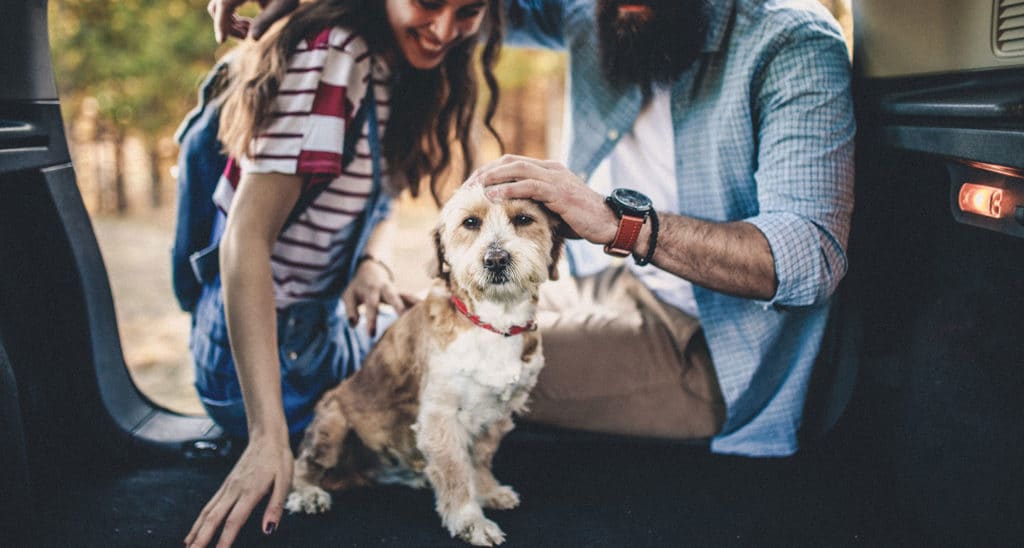
Home / BeInspired / How to Travel With a Dog by Plane, Train and Automobile
Planes, trains and automobiles and … dogs! Increasingly, pet owners are taking their dogs along for the ride, whether it’s a short trip, a family visit or even an extended vacation. But do you know how to travel with a dog in the safest and most stress-free way?
About 45 percent of pet owners travel with their pets every year, mostly by car, up from 19 percent a decade ago, according to the 2019–2020 National Pet Owners Survey conducted by the American Pet Products Association (APPA). And while automobile remains the overwhelmingly preferred option, pet parents also travel by plane and train with their pets.
However, it’s not as simple as loading your dog up and taking to the sky, rails or roads.
Follow these tips for traveling with a dog by car, plane and train, and you’ll set both you and your pet up for a smooth ride.
Before You Go: General Tips for Traveling with a Dog
Whether traveling by car, plane or train, experts say it’s important to think about the welfare of your pet first and not just your own enjoyment.
Jennie Lane, RVT, ACAAB, certified animal behaviorist and owner of Synergy Animal Behavior in Germantown, Tennessee, says it’s important to decide “if the pet is healthy and is likely to enjoy the experience.”
“Pet owners should definitely have their pet examined by a veterinarian and discuss with the veterinarian whether or not the pet is prepared physically and mentally for the planned excursion,” she adds.
Factors to consider in your decision whether or not to take your pet on your travels include “where you are going, for how long, how you plan to spend your time, and who will look after your pet when she can’t be with you,” says Suzanne Hetts, Ph.D., and Daniel Estep, Ph.D. , CAABs with Animal Behavior Associates Inc. in Sun City, Arizona. “Certainly, some trips with your pet can be great fun, but there are times when it might be best for Fido or Fluffy to stay at home.”
If you’ve decided to travel with your dog, socializing them and acclimating them to travel conditions is important, Lane says. Take pet carriers, for instance.
“The mistake many make is they only put an animal in a container when they’re going to the vet,” she explains. Instead, she says, pet parents should introduce positive experiences with the carrier, such as giving the pet treats or toys and making the space comforting and inviting.
No matter how you’re traveling, “Make sure you bring a familiar bed and toys along on a trip, along with any products related to your dog’s daily activities, such as a particular chew toy that the dog likes to chew before going to bed,” says Mary R. Burch , Ph.D., CAAB, CABC, BCBA-D, certified animal behaviorist in greater New York City area and director of the AKC Canine Good Citizen program . “A crate is essential to keep your dog safe and provide a familiar den for the dog.”
Now, let’s talk about the specific modes of transportation for traveling with your dog.
How to Travel With a Dog in a Car
One way to avoid paperwork, regulations, hassles and sidelong glances from fellow travelers is to pack up your own automobile and avoid commercial carriers.
According to the Automobile Association of America (AAA), “The first thing to consider [when road tripping with your dog] is how you are going to restrain your pet.”
While some pets may generally behave well, driving with an unrestrained dog can be unsafe not only for the driver, but the pet as well—and many drivers don’t know how to travel with a dog in a car without putting themselves or their furry friends at risk. According to a July 2011 AAA and Kurgo survey, 52 percent of respondents admitted to petting their dog while driving and 19 percent of respondents admitted to taking their hands off the wheel to restrain a dog. Such behaviors can distract the driver and increase the risk of a crash, according to the report.
There are many safer ways to drive with your dog. Some dogs have been trained to relax in carriers or kennels and find it the best way to travel. For some more nervous dogs, it may be a good idea to cover the crate with a blanket or cover to limit outside stimuli and distractions.
Make sure the carrier is safely secured. Otherwise it can become a projectile and dangerous to pet and traveler.
“Drivers should use a pet restraint system for your dog every time their pet is in the vehicle,” Jennifer Huebner-Davidson, AAA National, Traffic Safety Programs manager, told the AAA NewsRoom, adding, “an unrestrained 80-pound dog in a crash at only 30 mph will exert approximately 2,400 pounds of pressure. Imagine the devastation that can cause to your pet and anyone in its path.”
Some dogs ride well with a harness secured to a seat belt. Snoozer Pet Products’ Luxury Lookout dog and cat car seat is designed to calm pets with travel anxiety, giving them a soft, elevated perch while still restraining them with a connection strap that attaches the seat belt to the pet’s harness.
“There are also back seat bridges/extenders, seat covers, door protectors and seat fabric cleaners and deodorizers (for the inevitable accidents), to protect the inside of the car and make it more comfortable for the pet. Some may enjoy pet videos or soft music,” advises Hetts and Estep.
The Petego Car Seat Extender prevents pets from falling off the seat onto the floor, supporting dogs up to 165 pounds. Frisco’s Quilted Water-Resistant Hammock car seat cover also keeps pets from falling—while also protecting your auto upholstery from fur and scratches.

How to Travel With a Dog on a Plane
More than 2 million pets and live animals fly across the United States each year, according to the U.S. Department of Transportation —not to mention the recent increase in emotional support animals on flights.
Federal guidelines require service animals and psychiatric or emotional support animals to be allowed on planes and fly for free, under provisions in the Air Carrier Access Act .
Pet dogs can also fly for a fee in-cabin or as cargo on all major domestic carriers. Each airline sets its own criteria for the pets in regard to size. Generally, they must fit inside a carrier stowed under a seat and must remain there.
Fees generally range from $75 to $125 for in-cabin dogs, and cargo rates vary. Southwest, Allegiant, Frontier, Jet Blue and Spirit Airlines do not allow animals as cargo.
Alice Moon-Fanelli , Ph.D., CAAB, certified animal behaviorist and owner of Animal Behavior Consultations LLC in Hartford, Connecticut, recommends against traveling with dogs as cargo, which she says is highly stressful, even for crate-trained dogs who can tolerate loud noises and location changes.
“I don’t know there’s a lot an owner can do to prepare a pet for that level of ‘over-stimulation assault,” she says.
In August 2019, the Department of Transportation (DOT) updated and clarified its guidance to airlines on service and emotional support animals. As the policy evolves, several airlines are changing their policies, so it is important to contact carriers for the latest.
Most airlines require documentation from physicians and/or veterinarians showing the need for animal support, current vaccinations and training. They must accept medical forms and letters that meet DOT criteria. The regulations give some latitude to carriers in the animals they will permit, but all dogs are allowed and airlines can no longer ban specific breeds as support animals.
Service and emotional support animals are defined by DOT as “individually trained or able to provide assistance to a person with a disability” or by providing emotional support to a person with a disability.
Some behaviorists, including Burch, are concerned about “owners misrepresenting their pet dogs as service or emotional support animals so they can fly with them. I certainly feel better when my dog is with me, but it’s simply unethical to abuse the system,” she says.
Many vets recommend against bringing brachycephalic, or flat-faced dogs such as Boxers, Bulldogs and Boston Terriers, on planes because of their sensitivity to pressure changes, recycled air and other environmental conditions. Some airlines limit the breeds of dogs they allow as cargo.
Although airlines cannot limit the number of service or support animals on a flight, they often limit the number of pet dogs allowed. If you plan to pay to bring along your dog as a pet, book early.
Also, it is important to talk with your travel provider about airport limitations and restrictions -- some don’t allow pet travel between certain dates as cargo temperatures may climb too high or low. Before you book, troubleshoot as many issues as you can in advance to reduce the potential for headaches en route.
If you are traveling internationally, be careful to check on added restrictions, including quarantines.
Check with individual carriers about pet policies: American Airlines , Delta Air Lines , Southwest Airlines , United Airlines , JetBlue , Alaska Airlines , Spirit Airlines , Frontier Airlines , Allegiant Air .
Read our complete guide to U.S. airlines pet policies.
Tips for Traveling With a Dog on a Train
When it comes to traveling with dogs by train, Amtrak is calling all aboard . Service animals, which Amtrak describes as “trained to perform a specific task for the benefit of a person with a disability,” are allowed on any train, and the number of dog-friendly routes for pet dogs has been growing steadily.
Service dogs travel for free. The fee for pets is $25 each way for trips less than 7 hours. One pet per passenger is allowed in coach class only. Pet dogs must weigh 20 pounds or less, including the carrier, which can be no more than 19-by-14-by-10.5 inches, and must be stowed under your seat. The carrier must be leakproof and waterproof with adequate ventilation.
Apart from Amtrak, more than 40 metro, regional and tourist trains and subways across the country allow small pets to ride as long as they are leashed or in carriers. If they are service animals, some train stations will require they wear some sort of identifying vest or special identification to indicate their status.
In most cases, no proof of vaccinations, health certificate, or any other paperwork is required, according to Million Mile Secrets’ train travel guide .
With proper planning and consideration for your pooch, traveling together can be a rewarding experience.
As Lane says, “Just like with many family members, people enjoy the company of someone they love.”
- 9 Secrets for Traveling With a Dog on a Plane
- Traveling With Your Dog: Expectation vs. Reality
- Tips for Stress-Free Dog Travel
Featured Products

Temporarily out of stock

Related Posts

The Best Dog-Friendly Coffee Shops in Each State

Flying With Pets: Pet Air Travel Guide and Pet-Friendly Airlines
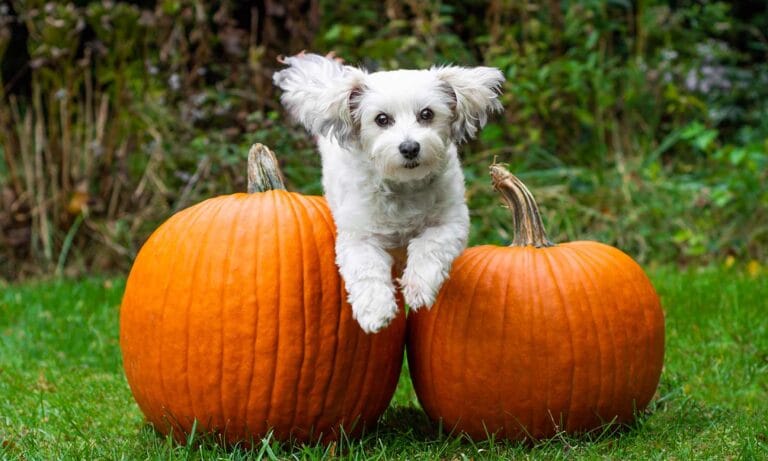
The 50+ Best Dog-Friendly Pumpkin Patches in the U.S.
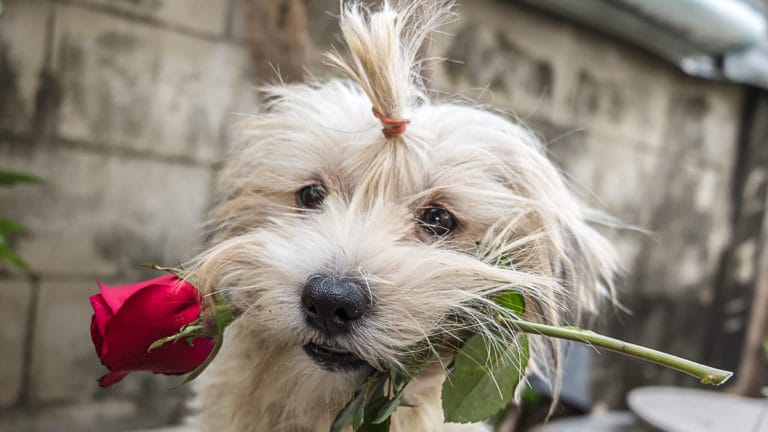
Dog-Friendly Places to Spend Valentine’s Day With Your Dog

Dog-Friendly Restaurant Etiquette
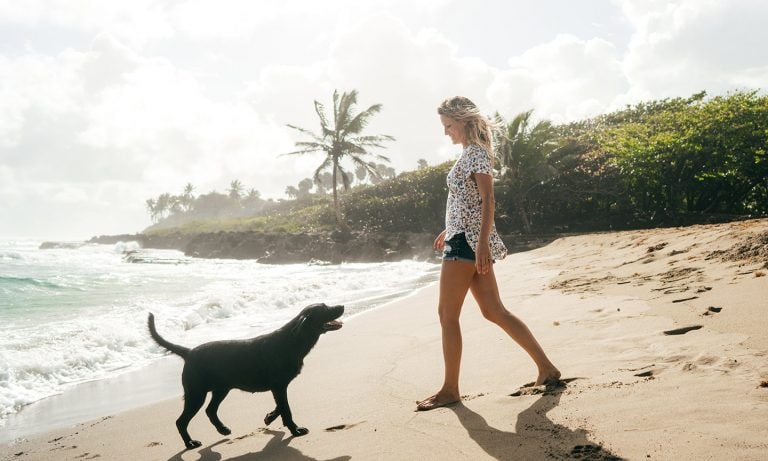
The 10 Best Dog-Friendly Vacation Destinations
- Health & Nutrition
- View all in be well
- Style & Decor
- View all in be home
- Get Answers
- View all in be smart
- People X Pets
- View all in be inspired
- Chewy Gives Back
- Shelters / Rescues
- View all in be generous
Most Popular

By: BeChewy Editors Updated: October 10, 2023
Learn what to feed a puppy at every stage in their development with this veterinarian-approved puppy feeding guide for new puppy parents.
More Details

By: Linda Rodgers Updated: October 13, 2023
Some plants can give your pup diarrhea, others are extremely poisonous and can cause serious problems.

By: Irith Bloom, CPDT-KSA Updated: October 10, 2023
Want to know how you can potty train your dog in 7 days? Follow along on one family’s potty training journey and learn how you can housetrain your dog, too.
A comprehensive guide to traveling with pets

Traveling with a pet, especially for the first time, is a daunting and stressful task — for both you as well as your furry companion. (That's why we typically suggest only traveling with your pet when necessary.)
Of course, some animals don't mind the jet-set life and make great travel buddies. Just like humans, each pet is a unique individual that adapts to the world differently. Whether it's your pet's first flight or they're a seasoned, four-legged world traveler, these tips will help guarantee you and your furry friend have a seamless journey.
For more curated TPG travel tips and recommendations delivered each morning to your inbox, sign up for our free daily newsletter .
Before You Go
First, and most importantly, make sure your pet is fit to travel. Some animals simply cannot handle travel due to age, illness, injury or temperament. If you're unsure, consult with your veterinarian for an expert opinion.
Identification
Get ready to travel by making sure you have all of the proper identification for your travel buddy. Purchase an ID tag for your pet's collar that lists your home address and cellphone number, as well as a temporary tag with the location and phone number of the hotel you plan to stay at.
If you haven't already, now is a good time to microchip your pet. Microchipping is a safe and permanent form of identification that can be extremely useful if your pet wrests free from his or her collar. If your companion is already microchipped, confirm that all the contact information registered on the chip is accurate and up to date before your departure.
Important documents
Take photos of your pet's medical history documents and save them on your phone. In the event of a medical emergency, these documents could be useful for the vet treating your fur baby. Note that some states require specific documentation , such as a Certificate of Veterinary Inspection, an Official Health Certificate or proof of rabies vaccines — so a quick trip to the vet may be necessary even before traveling around the country. And if you plan on traveling frequently within Europe, it may be a good idea to get your pet its own EU Pet Passport .
Accessories
Your pet's travel crate or carrier should be well-ventilated and must be large enough for your pet to stand, sit, turn around and lie down. Always introduce your pet to the new carrier at home before using it on a trip — and be sure to check your airline's pet carrier size guidelines and specifications before purchasing any new gear. Sherpa-brand carriers are well regarded and some sizes are approved for use on most U.S. airlines.
Hitting the Road
Whether you travel by car, plane or train, one way to calm animals is to tire them out before departure. Play a wild game of fetch or take your four-legged friend on a long walk before leaving — it will help them sleep through the trek. And be sure to cushion your pet's carrier with a favorite blanket, or a T-shirt with your scent. A sense of familiarity can relax a distressed pet.
Before em- barking (see what we did there?) on a long road trip, give your pet time to become familiar with spending time in a car. Sit with your buddy inside a parked car with the engine off. Once your pet is comfortable being in the car, you can start taking short drives to a local park for playtime — not to the vet. This will create a positive association between car rides and fun. You should reward your pet with treats and praise after each ride. As your pet becomes more accustomed to car travel, start to gradually increase the length of your trips.
And, of course, pets are not excluded from the old adage to buckle up for safety! Make sure your pet is safe and secure in the back seat. You can invest in a pet car seat, travel crate or seat belt leash to keep your dog restrained in the back. Preventing your pet from wandering freely around the car will not only keep them safe, but it will reduce distraction for the driver as well. A travel crate is a great option, as it provides extra protection in the event of a crash.
No matter how much you love cuddling with your pet, never let him or her sit on your lap when you're behind the wheel. Not only is it a major distraction, but it's also extremely dangerous for your favorite canine (or feline). A slam on the breaks could squish them between you and the steering wheel. And even the most well-behaved lapdog can be startled by a noise and decide to hop down to the floor between the pedals.
Please, keep all paws inside the moving vehicle. As adorable as it is to see a furry face hanging out a car window, we do not recommend allowing your dog to do so. Another car, a tree branch or an unexpected obstacle could come too close and injure your pup.
Give your pet a light meal no less than four hours before leaving on your journey, and refrain from feeding Fido in the car to prevent motion sickness. Make pit stops every two to three hours to allow time for bathroom breaks and exercise. If your pet is notorious for, well, leaving their mark, invest in a waterproof seat cover and rubberized floor mat.
Keep your companion comfortable by regulating the temperature. Make sure the air is circulating in the back where your sidekick is sitting. If your car is capable of isolating the radio, keep the sound up front for the humans so you don't irritate your pet's sensitive ears . It's bad enough they have to listen to your singing during the road trip.
This should go without saying but never leave your animal alone in a parked vehicle. Even with the windows cracked, the inside of a car can reach 104 degrees in just 10 minutes on an 85-degree day.

In-cabin air travel
Small animals, generally around 20 pounds or less, are permitted to travel in the cabin with an adult. Only a limited number of animals are allowed on each flight, so contact the airline as soon as possible to reserve a spot. If your travel plans are flexible, opt for a midweek flight, which will likely be less crowded.
Avoid flying with your pet during the holidays and take a nonstop flight whenever possible. If you do have a layover, let your dog stretch its legs and use the bathroom at a pet relief station (available at many major airports). Always be prepared for flight delays, and keep extra food and toys in your carry-on. It could be a lifesaver if your checked baggage gets lost en route to your destination.
Once you board, place your airline-friendly pet carrier under the seat or in a designated spot (if you fly first or business class on an American Airlines A321T , for example, you'll have to put your pooch in a special open compartment during taxi, takeoff, landing and turbulence). Never put your pet in the overhead bin , even if you're told to by airline staff.
Give your pet a bit of water or an ice cube during takeoff. Swallowing can help unpop their ears while the plane is ascending and alleviate any discomfort.
Tranquilizing an animal is not recommended prior to flying, as it could hinder breathing. Most airlines won't even accept a tranquilized animal. If you're worried about your pet becoming anxious mid-flight, try the Thunder Shirt, which has worked wonders for nervous, traveling pets. Consult your veterinarian, and see if they can offer any specific advice or medication for your pet.
Cargo air travel
We do not recommend flying your pet in cargo, but sometimes it's unavoidable. If you must bring a large animal on a flight, you'll have to check them underneath the passenger cabin. Many airlines forbid snub-nosed breeds of dogs and cats — which are susceptible to breathing difficulties — from traveling in cargo. Some airlines do not fly pets in the cargo hold at all, so check with your airline to confirm that your pet will be welcomed aboard. A separate booking is required for any pets flying cargo.
It's also important to avoid traveling when it's extremely hot or cold. Most airlines will not fly pets in cargo during the summer months. Even though the cargo hold is temperature controlled, your pet will have to endure the extreme temperatures during loading and unloading on the tarmac. Book a direct flight to reduce the amount of handling. (Layovers allow the opportunity for your pet to be left out on the ground or mishandled by the baggage crew.)
Make sure your pet's crate is clearly labeled with a "live animal" sticker and your contact information, including your name, cellphone number, address and phone number for your ultimate destination. If you happen to be traveling to an international location, you should also translate "live animal" to the local language, so baggage handlers understand they're dealing with precious cargo.
Invest in a crate with a sturdy metal door (which some airlines require over plastic) that allows your pet plenty of room to completely stand up and turn around. The crate should provide adequate ventilation and a waterproof bottom with a spring lock door. Patty from the TPG Lounge suggested keeping your pet hydrated during the flight by freezing a water bowl to place inside the crate. This prevents spillage during handling before the flight.
Travelers should also request that the gate agent notify you once your pet has been loaded on the plane. When you board, alert the cabin crew that you have a live animal in the hold so they know to keep an extra close eye on the cargo pressure and temperature.

Booking a pet-friendly hotel stay
Do your research before you go, and make sure you're selecting a pet-friendly hotel before booking. In addition to noting special amenities and programs, be aware of fees that may be associated with bedding down with a pet in tow.
Request a room by an exit on the ground floor to conveniently take your dog for a walk, and note that some hotels do not allow pets on the furniture. You should always abide by the rules, but just in case your pet doesn't, grab an extra towel and drape it over the furniture to avoid any rips or scratches. Even if your dog is potty-trained, an unfamiliar setting could leave them anxious and susceptible to having an accident. Put down a pee pad in the room, just in case. Better safe than paying a hefty cleaning fee.
Photo by Richard Atrero de Guzman/Anadolu Agency/Getty Images
14 travel essentials to keep your dog safe and comfortable on road trips, recommended by experts
When you buy through our links, Business Insider may earn an affiliate commission. Learn more
- If you're taking a road trip with your dog, you'll need to ensure their safety and comfort.
- We rounded up the best gear for driving in the car with a dog, including a dog crate and harness .
- You can protect your dog from overheating on the road with window shades and plenty of water.

Americans across the country are hitting the road with dogs as their copilots this summer. Whether your plan is to hike and camp , explore back roads and under-the-radar towns, or visit family and friends, the promise of an adventure on the open road is intoxicating not just for you but for your dog, too.
To ensure the success of a road trip with your pup, you'll need a handful of dog car travel accessories to keep them safe and comfortable during long drives. As a professional dog trainer by day and travel writer by night, I have years of experience hitting the road with dogs. I've combed through my own gear to come up with this list of essentials for a canine-friendly road trip.
For expertise on traveling safely with a dog in the hot summer months, I've consulted with veterinarian Tanya Fraser , medical director of VCA Allendale Animal Hospital in Allendale, Michigan, and Lindsey Wolko, founder of the Center for Pet Safety in Reston, Virginia. Below we've rounded up our favorite travel gear as well as tips for traveling safely with your dog .
Here are 14 of the best dog car travel accessories for a canine-friendly road trip:
A crash-tested kennel to protect your dog in a collision.
Gunner G1 Kennel, available at Gunner, from $499
According to Wolko, you should never travel with your dog in a plastic crate that has been buckled in with a car seat belt because it can easily fracture in a crash. Instead, use a crash-test-certified crate to give your pet the best possible chance of survival in a crash. The Center for Pet Safety has tested several crates for their Center for Pet Safety certified list , including the Gunner G1 Kennel, which received a five-star crash-test rating. It's also a top pick in our guide the best airline cat carriers . Crating may also help alleviate motion sickness in some dogs, according to Fraser.
A foldable car ramp for pets with mobility issues
Petsafe Happy Ride Bi-Fold Pet Ramp, available at Chewy , Amazon , and Wayfair , from $74.95
Just because a dog's mobility is limited doesn't mean they aren't an ideal road trip companion. Bring along a lightweight car ramp to make your travels with an older or disabled dog go more smoothly and save you from having to lift them in and out of the vehicle 20 times a day. In between stops, just fold up the ramp and slide it behind the seat for easy storage.
A crash-tested harness to travel safely with your dog outside of a crate
Sleepypod Clickit Sport Dog Safety Harness, available at Sleepypod, $94.99
Sleepypod Clickit Terrain Dog Safety Harness, available at Sleepypod, $94.99
Testing done by the Center for Pet Safety indicates that a crash-test-certified travel harness is an effective way to keep a dog safe on a road trip, especially a dog that has never been crate trained or that suffers from confinement distress. Sleepypod's Clickit Sport Harness and Terrain Harness each earned a five-star rating. They attach to the seat belts in the back seat of a car through built-in loops.
Read our full review of the Sleepypod Clickit Sport harness .
Shades to block the sun and keep car temperatures down
Munchkin Brica Window Shade, available at Buy Buy Baby , Target , and Amazon , from $14.99
Even with the air conditioning on full blast, the interior of the car can heat up to uncomfortable levels when temperatures get extreme outside. Sunshades can help to minimize the greenhouse effect inside the car by blocking the heat out. Don't expect them to help when you've parked the car, though. Temperatures can skyrocket inside a parked car in just minutes. "Never leave your dog in the car, even with the windows down, and even for just a few minutes," said Fraser.
A hammock-style seat cover to keep paw prints and dirt at bay
Orvis Grip-Tight Windowed Hammock Seat Protector, available at Orvis, from $189
If any portion of your road trip involves hiking, camping, or other explorations of the great outdoors, do yourself a favor and get a water-resistant seat cover to protect your car from moisture and dirt. This version from Orvis blankets the back seat and the backs of the front seats. A see-through mesh panel between the two front seats prevents your dog from feeling too isolated.
A soft, washable blanket that doubles as a dog bed
Carhartt Dog Blanket, available at Amazon and Carhartt , from $84.99
If you're exhausted by the end of a day of driving, so is your dog. Whether you're staying in a hotel or camping overnight, pack something soft and cozy for your pup to cuddle up in. I always bring a soft, washable blanket along for the ride. Not only is a blanket easy to fit into an overstuffed trunk, it's ultra-portable and can double as a dog bed whenever needed.
A pet first-aid kit just in case
Adventure Dog Series Medical Kit, available at Chewy, $27.49
From foxtails to ticks, there are dozens of nasty surprises that await your dog on a road trip. Be prepared for the dangers in your path with a high-quality pet first-aid kit. Fraser also recommends downloading the American Red Cross's Pet First-Aid app to help you navigate minor injuries. If you're headed for a specific destination, she suggests looking up a local emergency clinic before you arrive.
An insulated water bottle with a dog bowl built right in
Kong H20 Stainless Steel Dog Water Bottle, available at Amazon and Chewy , from $11.21
Whether you're on a nature walk or in a socially distanced beer garden, keep your dog hydrated with a combination water bottle and dog bowl. This version from Kong is made of insulated stainless steel that will keep liquids cool and refreshing all day long.
A spill-minimizing bowl so your dog can quench their thirst anytime they want
Heininger Waterboy Portable Pet Bowl, available at Chewy, $24.95
Heininger's portable water bowl, which has a reservoir that fills with water when laid flat, has lived in my car on and off for years. Leave it out while you drive — the well has been designed to minimize spillage — or stand it up to drain the well water back into the jug. The BPA-free device holds up to 3 quarts of liquid.
A long line to let your dog safely explore new environments
Signature K9 Biothane Long Line, available at Amazon, from $34.99
Even if your dog has an excellent recall, the allure of the new environments they'll be exploring on your road trip may prove more powerful than your cue. Bring along a 15- to 20-foot long line to give your dog some freedom while ensuring they remain out of trouble.
Interlocking treat-dispensing puzzle toys to help alleviate boredom
West Paw Toppl, available at Chewy , Walmart , and West Paw , from $18.95
Keep your dog from getting restless on the road by occupying them with treat-dispensing puzzle toys. West Paw's Toppl can be stuffed with treats, spread with peanut butter, or sprayed with cheesy goodness. For smarty pants dogs, try combining a large Toppl with a small one to create a toy that's a bit more challenging.
Grooming wipes or waterless shampoo to quickly remove grime and nasty smells
Earthbath Green Tea & Awapuhi Grooming Wipes, available at Petco, $15.99
Bodhi Dog Waterless Lavender Dog Dry Shampoo, available at Chewy and Amazon , $13.99
On the road, there may be hundreds of miles between you and the closest dog-washing station, but if your dog is living their best road trip life, chances are they'll need at least a little cleanup before your trip is over. Grooming wipes are an easy way to freshen up your dog's coat or remove debris from their paws or muzzle. If you've got a dog that loves to roll in stinky things, I can tell you from experience that you'll need something stronger to remove the stench. A waterless dog shampoo works a bit better and it never hurts to bring a bottle along for the ride.
A dog-size backpack for outdoor adventures
Ruffwear Approach Dog Pack, available at Ruffwear , Backcountry , and REI , from $53.93
If you plan on doing a lot of hiking or backpacking on your road trip, it's only fair that your dog should carry their share of the gear. Always limit your dog's load to no more than 25% of their body weight and make sure the pack fits properly before your adventure.
A folding travel crate for use inside a hotel room
Orvis Hose-Off Folding Travel Crate, available at Orvis, $159
To keep everyone safe when you leave your hotel room, you'll need a portable crate to set up inside your room. While most hotels don't require this, I've heard one too many horror stories about a hotel staff member who has been bitten after walking into a room with a canine guest. Choose something that collapses flat and has a handle for easy carrying. I like Orvis's version, which also has two doors and plenty of ventilation and comes with a padded fleece mat.
Additional safety tips for road trips with dogs
To ensure the success of a road trip with your pup, you'll need a handful of items to keep them safe and comfortable during long drives. Dogs also need regular breaks from the road, just like we do. "Stopping every few hours to get out, move around, and use the bathroom is ideal," said Fraser.
All that driving also increases the possibility that your dog may, at some point, experience some car sickness. Most dogs outgrow motion sickness in puppyhood, according to Fraser, but if your dog is prone to nausea in the car, things like withholding food for a few hours before traveling or letting your dog see out the window can help. Roll down the window for additional airflow but not so low that your dog can thrust their head into the wind. That's very dangerous. "You know the sound your windshield makes when a rock hits it? Imagine your dog being hit by that rock. Ouch!" Wolko said.
Before you embark on your trip, Fraser recommends making sure your pet is up-to-date on their vaccines and parasite control. Consult your vet if you have questions. They can also provide you with anti-nausea medication if your dog frequently experiences motion sickness.
- Main content

Safely Driving with Dogs: the Ultimate Guide
Please share if you enjoy this content!
Looking to learn how you can safely go driving with dogs?
Road trips can be a blast if your dog loves riding in the car. My dogs do, so I take them everywhere that I can. We go to dog-friendly restaurants , stores that allow dogs (like Petsmart and Home Depot), walks, and events.
Driving with dogs can be great fun on day trips and longer adventures. I don’t love long drives, but my dogs do! So, they make the time pass a bit more easily when I’m behind the wheel with their company.
Driving with dogs takes some planning, but it can be a lot of fun for all. And, of course, many of these suggestions apply to other pets as well as dogs. Here’s what you need to know to have a great time.

This post may contain affiliate links, which means I’ll receive a commission if you purchase through my links at no extra cost to you. Please read the full disclosure for more information.
Driving with Dogs: Safety
One of the first things for you to consider when driving with dogs is safety. This includes both in the car and out of the car.
Though you want to have fun with your dog, it’s important to make sure they remain safe. And the reality is that your dog may be a bundle of happiness and may not be thinking, so you need to do it for them.
It’s not just about safety for your dog, either. People tend to be more distracted when driving with dogs , especially if they are not secured properly.
Safety Considerations While Driving with Dogs
When you’re driving, it’s a good idea to consider safety in case you get into an accident, have to hit your brakes, or make a sharp turn quickly. The best way to keep a pet safe is in a crate or in a carrier inside your vehicle.
This isn’t always possible, though. For example, I have a 55-pound dog and a small car, so his crate won’t fit.
Instead, it’s a good idea to use a harness that attaches to the seatbelt. Though the data has not proven this to be much safer than riding loose in a car, it is a good idea to consider and seems to make sense. After all, humans wear seatbelts, so why wouldn’t we use one for our dogs?
I have had a couple of friends who have been in car accidents, and their dogs were propelled through the windshield. Thankfully, both dogs ended up ok, but it’s a terrifying ordeal. If they are harnessed, they could still get injured, but any injuries would likely be less severe.
Using a hardness would also help with the situation I have with one of my dogs, who likes to jump out when I open the door. I learned to block his escape, but when he is harnessed in, he can’t go anywhere.
The Kurgo Tru-Fit Smart Harness is a harness that is highly rated by people who have purchased it. It’s also one that some of my friends use that they love. Another well-rated harness is the Mighty Paw Vehicle Safety Belt .
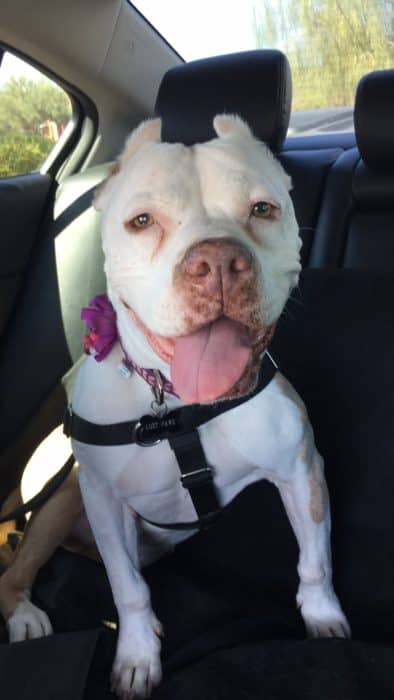
Use a Collar with Tags
Another good safety idea is to make sure your dog has a collar and tags at all times during your trip. This is helpful if your dog were to get out, either in the case of a car accident or if they launch past you when you open the door. If they are wearing their tags, you have a better chance of successfully getting them back safely.
I generally keep collars on my dogs, but I honestly didn’t think of this one until one of my friends got into a car accident with her dog. She was unconscious for a short time, and her dog got spooked and ran off.
She got him back quickly because someone happened to witness the accident and saw her dog run away. They were kind enough to stop and get her dog for her. Can you even imagine? My heart shudders to think about it!
And with the example of my dog, who likes to dash off when I open the door, he didn’t go far. However, what if something happened that spooked him?
If a loud truck rolled into the parking lot or fireworks went off, he might have shot off, and it would have been tough to get home without his identification. We might carry ours in our wallets, and our dogs carry theirs around their neck.
It probably goes without saying, but you also should make sure the tags have your current contact information and address. If you move or change your number, make sure to update the tag.
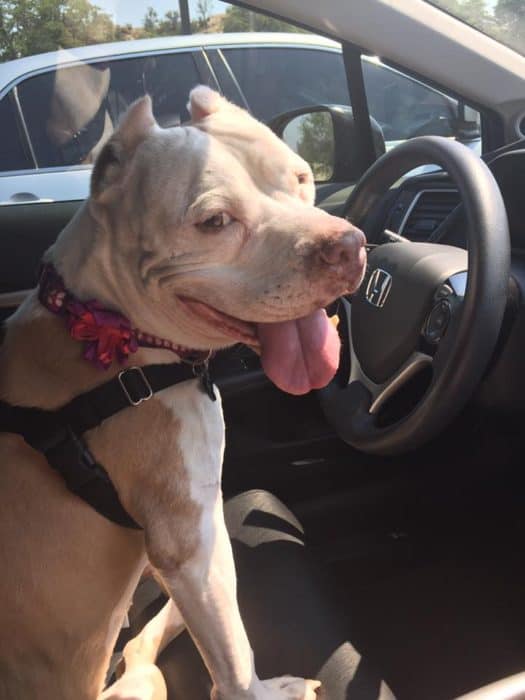
Get Your Dog Microchipped
Another really good safety measure is to make sure your dog is microchipped. All vets have microchip scanners. So do Banfield Pet Hospitals in Petsmart and most animal shelters.
Now, it obviously requires someone to take your dog to get scanned, but if they do that or if they end up at the shelter, they will be identified so they can be returned to you.
You still want to use a collar, as that is the fastest and easiest way to ensure your dog is identified. However, a microchip is a really good additional level of protection.
Microchips do require that you update your information with the chip company as well. So, if you move or your phone number changes and you don’t update it, they may not be able to contact you.
Additionally, some companies do require a fee. Sometimes it’s an annual fee, and sometimes it’s a lifetime charge. It could also be a one-time fee. Make sure you know and mark your calendar to make sure you stay current. Your dog’s life, and being returned to you, may depend on it.
Some popular microchip companies include:
- AKC Reunite
- 24 PetWatch
Seat Placement
Another safety consideration for driving with dogs is seat placement. I always keep my dogs in the back seat and think it’s a good idea.
Of course, I do know people who let their dogs ride shotgun, and I understand wanting the company in the front seat. I just don’t think it’s a good idea and I don’t do it with my personal dogs.
There are a few reasons for this. First, due to the risk of injury when the airbag deploys. Your dog is likely to get injured if you do get into an accident and the airbag deploys.
Second, if you were to get into an accident, they really have little protection in the front seat. You do not want your best friend ejected from your vehicle in an awful situation if you get into a car accident.
Now, my one dog likes to supervise my driving. He will often sit as far forward as he can over the center console if I don’t put him in a harness. That’s not any safer than his being in the front seat. So, it’s something for you to consider when you decide where your dog will sit when you’re driving.
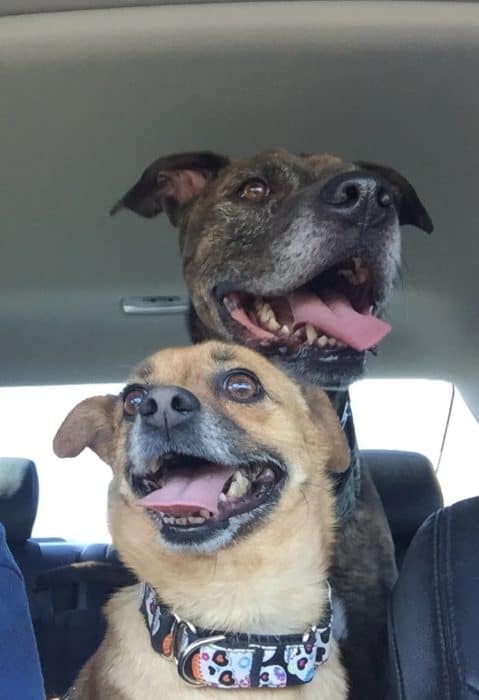
Driving in Trucks
I hope it goes without saying, but dogs should never, ever be left loose in the truck bed of a truck. They also should not be leashed to something in the truck bed. It is not safe for people or animals to sit in the back of a truck like this.
Ideally, a dog should be kept inside the cabin of the truck. If the car is a two-seater, the dog is better off in the front seat than in the truck bed. But if that’s not possible, and you cannot keep your dog inside a truck, they should be kept in a crate securely fastened to the truck bed.
Too many times, I have seen dogs standing loose in the back of a truck bed. I have seen trucks roaring down the highway with a dog in the back hanging over the side of the truck.
There is nothing to keep the dog in the truck, and if the driver were to get into an accident or even stop short, that dog would have a high chance of flying out.
Driving with Dogs: Other Considerations
There are a number of other considerations for safety and comfort when you are driving with dogs. Remember, it’s your job to keep your dog safe and to think of everything you can to do so.
Temperature
Consider the temperature for all stops along your drive. Even if you think you will stop for just a few minutes, your car quickly heats up to an unbearable and potentially life-threatening level.
You can certainly crack the windows, but depending on the temperature outside, that may not help much, if at all.
For example, according to the American Veterinary Medicine Association, if the temperature outside is 70 degrees, in just 20 minutes, it is 99 degrees in the car. If it’s 90 degrees outside, it is 109 degrees inside the car in just ten minutes.
I wouldn’t want to be in that car! Lowering the windows has a minimal effect when it’s that hot outside. There is a helpful article with a full chart that shows the temperatures in your car based on the temps outside of your car .
Additionally, consider the feel of hot asphalt on paws. It doesn’t take long to burn them, and it’s quite painful. A good rule of thumb is to put your bare foot on the ground. If it’s too hot in a few seconds for your foot, then it’s too hot for your furry friend to walk on it as well.
Give it some thought before driving off with your dog. You may need to either keep your dog in the car, carry them to a grassy area with shade, or don’t bring them.
Supervision
It’s not a good idea to leave your pets unsupervised for long. Understandably, you cannot always take them with you. You may need to run to get a drink or go to the bathroom during a long drive. But try to minimize the time your pet is without supervision.
Ideally, park where you have a line of sight to your car so you can keep an eye on your dog. If you’re traveling alone and you can’t watch the car, try to minimize your time away.
Window Locks
I learned this lesson recently, as my dog apparently figured out how to lower the window to stick his head out and enjoy the breeze. I was wondering why my car was feeling cool, and it got a bit louder and sure enough, he did it not once, but twice!
That is how I learned my car has window locks. It was probably a feature for child safety, but I’m very happy to use it for dog safety, too. Without fail, if I leave the windows unlocked, he will roll the windows down.
Some people like to allow their dogs to hang out in their cars when they are driving. To some extent, it depends on your dog. Will the dog jump out if you stop, and do they know to stay far enough in to make sure they keep their balance, even if you hit a bump in the road?
For safety, I might roll down the window a little bit to allow his head partially out, but I stop at rolling the window entirely down. For me, it’s a safety concern, and I’d rather be safe.
Keep Your Dog on a Leash
It is a good idea always to keep your dog on a leash. Especially so when you are traveling away from home in an area your dog is not familiar with. This is true even if your dog is trained off-leash.
My dog is really good off-leash in my yard and won’t leave the perimeter. However, I won’t risk his safety when we’re away from home. Should he get scared by something unfamiliar and run, he might have a tough time getting back to me.
Another thing to consider is that not everyone loves dogs as much as we do. So, if your dog might approach a person when he is off-leash, it could escalate quickly. It’s just not worth it.
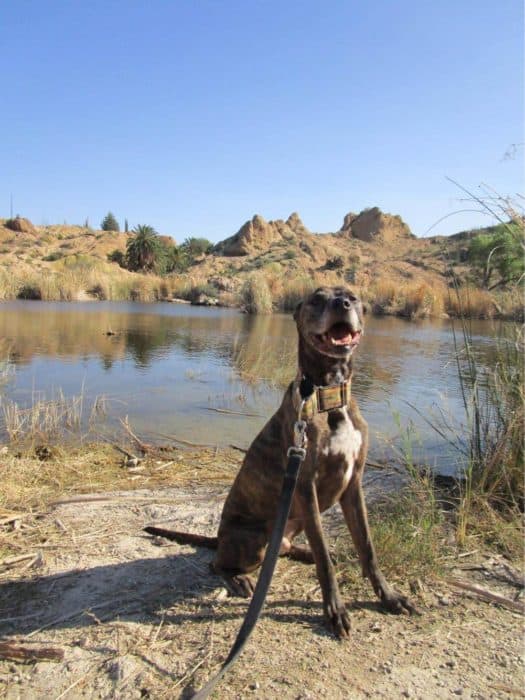
Is Your Pet Allowed on Your Stops?
I wrote another article about dining with your pet with a lot of detail, so check it out! You should always make sure your dog is allowed where you are going. Though restaurants generally won’t allow pets inside, many do offer outside dining on their patio with your furry friend.
Never try to sneak them in, though. It’s not worth it, and they will make you leave if they don’t allow dogs.
There are a lot of restaurants that do allow dogs. You can check beforehand if you know where you may stop on your road trip. Or you can call. But if you don’t have any advanced notice, you can always run in quickly to ask.
Of course, you’ll want to make sure your dog will behave well at restaurants. You don’t want to be that owner with your dog trying to climb onto people’s tables for their food. If you’re unsure, do a test run at home and try it. And be prepared to leave if you need to.
What Should You Pack When Driving with Dogs?
Packing for your trip does depend on how long the trip is and where you are going. (You may need specific items or may have to address temperature concerns). Here is a core list that you can modify as appropriate for your road trip:
- Collar, leash, and tags (harness if your dog wears one)—I use the EasyWalk Harness with my big dog as it has an added bonus of a hook at his chest to reduce his pulling. Here is a similar harness made by Petsafe . For my small dog (who thinks he’s HUGE) I use one like this Petsafe harness . It’s a great brand, and I like the harnesses that are more sturdy to ensure he doesn’t wriggle out of it. If you’d prefer to use a collar and not a harness, I highly recommend a martingale collar. It has a loop so it tightens when you pull the leash so the dog can’t back out of it. Max and Neo martingales are great, and they give back to support local animal rescues with every purchase.
- Water and a bowl —If I’m going for shorter walks or hikes, I bring a combination water bottle and bowl . If it’s a longer trek, I usually use my own water for my dogs and bring a collapsible bowl that I can attach to my pack (or my dog’s).
- Poop bags —You can never have too many poop bags. I love these Planet Friendly Poop Bags by Frisco . You can purchase a clip-on dispenser that makes it quite easy by always having them handy. If you’d rather buy the bags in bulk (I did say you can never have too many!) They come with a dispenser. They conveniently come in scented as well, in case your precious pup needs them.
- Optional —Why do all the work when your precious pooch can help! I have an Outward Hound backpack , and sometimes, I make my pup carry his own water and snacks if we go for a hike or a long walk.
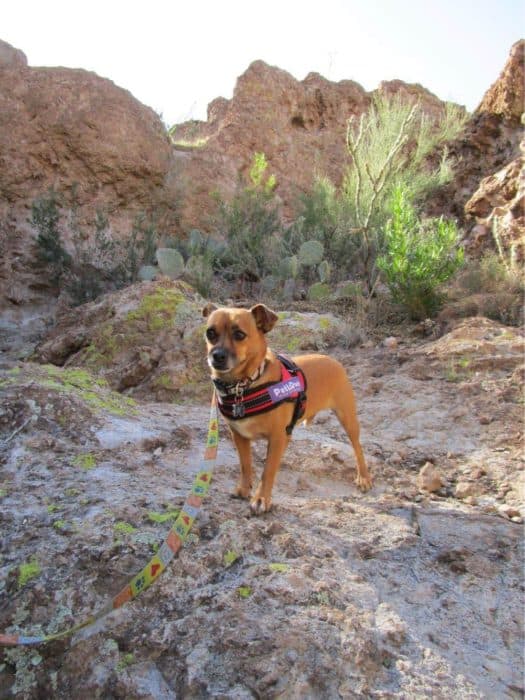
Longer Trips
In addition to the items listed above, I suggest:
- Food and a bowl
- Any meds required
- Bed or blanket
- Grooming items like brushes
- Copy of recent medical records and/or vaccination records (and if you’re leaving a state in the United States, you may need a health certificate )
- Seat covers and blankets for muddy paws and wet dogs (depending upon where you go)
- First-aid kit
- Toys, chews, and other fun items
Driving with Dogs: Taking Breaks
It’s important to take breaks for your furry friend. If you’re like me, driving makes you a tad sleepy, so I like to just go and get the drive done. Your buddy may need some stops for water breaks, potty breaks, and stimulation. A little exercise when you’re on the road will do you both good.
Take a short walk around the parking lot and check things out. Your dog will love you for it, and it’s bonding time. It’s also a great way to take a mental break from driving for a little while, too.
Driving with Dogs: Road Trip Planning
Road trips with your dogs can be a lot of fun. For day trips or longer, you can reduce the stress by planning ahead and making sure to pack everything that might be needed. A little forethought regarding safety goes a long way to making it a fun and safe trip. Enjoy!
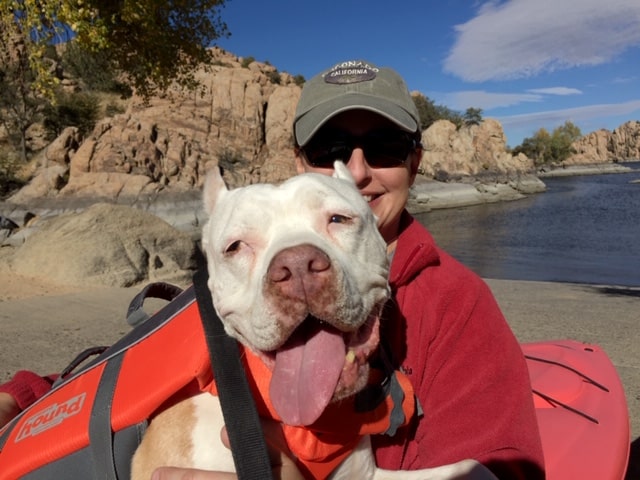
If you are unable to bring your pets when you travel and are seeking options to care for them while you’re away, this post has information for pet sitting to help you decide the best way to do that.
If you decide to fly, read more about considerations for flying with your dog . Read this post for tips for dining out at dog-friendly restaurants .
You Might Also Like
- Tips to Take Your Dog on Vacation (+ What to Do When You Can’t!)
- Flying with Dogs
- Dining With Dogs in a Pet-Friendly Restaurant
- Care for When You Can’t Bring Your Pets
- Hiking with a Dog—Top Tips for Safety and Fun
Like it? Pin it!
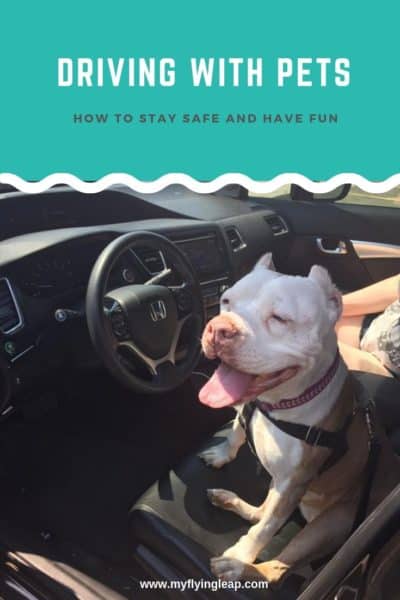
Sam is a travel-obsessed animal lover on a quest to create a life of travel with her dog. She loves learning new things, snuggling a dog, architecture, hiking, and bold red wine. Join her in creating a life to dream about!
Leave a Reply Cancel reply
Your email address will not be published. Required fields are marked *
AFFILIATE NOTICE
This website uses affiliate links, meaning I may earn a commission if you make a purchase through a link. As an Amazon Associate, I earn from qualifying purchases. Learn more .
- Exciting destinations
- Solo travel
- Travel Tips
- Travel Guides & Itineraries
- Traveling with Pets
- Work with me

Traveling with Dogs Made Easy: 5 Tips for Road Trip Success [Large Dogs]
Some of the links below are affiliate links, meaning that at no additional cost to you, I will receive a commission if you click through and make a purchase. For more information, read my full affiliate disclosure here .
![Traveling with Dogs Made Easy: 5 Tips for Road Trip Success [Large Dogs] 1 Traveling With Large Dogs](https://bigdogmom.com/wp-content/uploads/2021/04/Traveling-with-Large-Dogs-Pin-2-683x1024.jpg)
Whether you are moving cross country or planning a dog-friendly vacation, traveling with dogs can be daunting. Here are my top 5 tips for an easier road trip with your large dog.
Whether you are looking for a dog-friendly vacation or are moving with a dog cross-country, the prospect of traveling with dogs can feel both daunting and crazy.
The hair flying. Slobber flinging. Panting hot breath on your children as they try desperately to keep their books from getting saturated with your dogs’ jowl juice.
Driving over 2000 miles under these conditions can bring even the most tenured big dog mom to her knees if she isn’t prepared.
![Traveling with Dogs Made Easy: 5 Tips for Road Trip Success [Large Dogs] 5 Traveling with Large Dogs](https://bigdogmom.com/wp-content/uploads/2021/04/Road-Trip-With-Large-Dogs-Pin-3-683x1024.jpg)
The following are 5 simple tips, from my recent personal experience, that will help you maintain your sanity should you be considering a road trip with dogs . As an added bonus, I’ve included a VIDEO summary of these 5 tips linked below. Check that out when you finish reading…
In this post you will learn:
- How to transport your dog safely in the car,
- The 5 most important keys to successful travel with your big dog,
- What you need to have on hand in the event of an emergency,
- A sample project plan (checklist) to prepare for your trip with ease,
- How to relieve stress and anxiety for dogs that fear car rides,
- The best pet-friendly hotels for large dogs,
- And some helpful advice for fellow raw feeders!
Let’s get going…
Did you know?
Click here for my FREE Pre-Travel Checklist for Big Dog Owners that you may find helpful as you plan for your road trip. It contains 24 suggested dog-related action items to assist in your planning and preparation with a notes section for you to jot down phone numbers or other key information for your trip.
Travel Safety for Dogs
Did you know in an accident that occurs at 25 mph, a dog can be thrown forward with a force 40 times greater than its weight, hitting objects and passengers with thousands of pounds of force? ( 1 )
Consider the impact of a 200-pound mastiff. That would be a force of 8,000 pounds flying through the cabin, and worse, crashing through the front windshield!!
![Traveling with Dogs Made Easy: 5 Tips for Road Trip Success [Large Dogs] 6 Traveling With Large Dogs](https://bigdogmom.com/wp-content/uploads/2021/04/Traveling-With-Large-Dogs-3.jpg)
Whether you are in the car for 5 minutes or 10 hours or more with your dog, it is critically important that you factor into the cost of big dog ownership , money for a seat belt , harness , gate , crate , or some way to safely transport your dog in a car.
The make and model of your vehicle and the size of your dog(s) will determine what safety gear makes the most sense for you.
Here are a few options for your consideration.
![Traveling with Dogs Made Easy: 5 Tips for Road Trip Success [Large Dogs] 7 Traveling with Dogs Made Easy: 5 Tips for Road Trip Success [Large Dogs] Whether you are moving cross country or planning a dog-friendly vacation, traveling with dogs can be daunting. 5 tips for an easier road trip with your large dog.](https://bigdogmom.com/wp-content/uploads/2021/04/Amazon-Shopping-Callout.png)
Note: I’ve compiled all of the products I mention in this post into a convenient one-stop-shop on Amazo n to save you time shopping, so check there when you finish reading.
Best Products for Car Safety for Large Dogs
Seat belt or seat belt tether.
These will usually attach directly to the seatbelt in the car. An example is the Kurgo Seatbelt Swivel Tether which hooks onto your dog’s harness.
Read The Best Dog Harness for Large Dogs [Definitive Buyers Guide] for more on how to select the best harness for your large dog. If you prefer a video, check out How to Choose a Dog Harness for Large Dogs [“NO PULL” Truth REVEALED!] .
Car Harness
These are harnesses made exclusively for car travel for dogs. They are different than regular dog harnesses.
Examples include the Impact Dog Car Harness by Kurgo (crash test rated up to 108 pounds) and the PetSafe Deluxe Car Harness (up to 120 pounds).
A gate is simply a barrier between you (the driver) and your big dog.
Examples include the Kurgo Backseat Barrier or the WeatherTech Pet Barrier , which is the one I have.
Unfortunately, I have yet to find the perfect barrier for our Navigator. I’m sure I did something wrong with the installation of our WeatherTech one, but, for some reason, the second the dogs lean on it, it slips out of place. I do think this product would work well for smaller vehicles, vehicles without a liner, and families with just one dog, however. For our vehicle, the Kurgo Backseat Barrier would work much better!
If you have just one large dog, a crate may be an option for you.
A good example of a quality crate you could fit in the cargo space of a large SUV is the Pet Gear 3 Door Portable Soft Crate which would be big enough for a Labrador retriever, Boxer, or Collie size big dog.
For families, like us, with giant breed dogs or multiple dogs, a crate may not work for you given the substantial space limitations in most vehicles.
How to Get a Large Dog Into and Out of a Car
Secondly, you will want to think about how you are going to effectively get your dog into and out of the car safely.
We use a Twistep and LOVE it! This product attaches directly to the hitch on the back of our Navigator. To use it you simply lift the lock and swivel it out from under the car and it locks in place. When your dogs step out, you lift the lock again and swivel it back under for storage. Easy peasy and oh, so convenient! The Twistep has been a Godsend for me! Check out the video below to see it in action!
Other big dog owners love using a dog ramp for their dogs. For dogs with mobility issues like Wobblers, hip dysplasia, CCL injuries, or senior dogs, a ramp will likely work better for you than the Twistep . For healthy adult dogs and puppies, however, either one can work for most vans, SUVs, or trucks.
Check out my video, Hitch Step or Dog Ramp: Which is BEST For You? A Mastiff Owner’s Journey With Both | PROS & CONS , for a more in-depth comparison.
That said, if your car is small enough, you may not need either one.
Now that you have the means to travel safely, let’s move on to HOW to successfully survive a long-distance road trip with your big dog.
5 Tips for Long-Distance Travel with a Large Dog
1. preparation.
Preparation can mean many different things depending on what type of travel you are doing with your large dog.
Let’s discuss some possible scenarios and I will give you a few tips for each.
Traveling For a Few Days to a Week
While the most simple of the three scenarios, traveling long distance, even for just a couple of days, with a big dog involves some planning and preparation.
Consider your destination, the routine needs of your dog such as food, medication, and behavior, weather, and how many hours you will be traveling each day.
You will need to prepare food and medication, make hotel arrangements, and pack your Essentials Bag (see point #2 below).
If your dog will be riding in the car for more than a few hours at a time on this road trip, consider conditioning them to long car rides ahead of time. More on that in a minute…
Long Distance Road Trip for 7+ Days
In addition to the points made above, longer road trips require a little more pre-planning.
Depending on how long you will be gone, you may want to arrange for a routine vet visit beforehand to discuss any needed immunizations or medications your dog will need.
Inform your veterinarian about where you are traveling as there may be geographical health considerations you need to be aware of like Lyme disease, valley fever, or canine influenza.
You will also want to plan to have more food on hand or the possibility of buying dog food at your destination.
Don’t be surprised if your dog’s appetite is thrown off or if he chooses to skip a meal here or there. In my experience, this is normal.
Moving Cross-Country
The prospect of moving to a new state can be daunting, to say the least, especially if you have children and/or big dogs.
![Traveling with Dogs Made Easy: 5 Tips for Road Trip Success [Large Dogs] 8 Moving with large dogs](https://bigdogmom.com/wp-content/uploads/2021/04/Moving-with-a-Dog-Pin-2-683x1024.jpg)
Don’t expect to get much sleep in the weeks leading up to your move. With so many competing priorities and action items, it’s easy to get lost or overwhelmed.
In addition to everything I’ve already mentioned above, you will want to provide a forwarding address to your vet, as well as contact your state or county where your dog is licensed to let them know you are moving.
I also recommend getting all of your pet medications refilled a few days before your departure to give you time to get established with a new vet and pharmacy.
I’ve created a Pre-Travel Checklist for Big Dog Owners that you may find helpful as you plan for your road trip. It contains 24 suggested dog-related action items to assist in your planning and preparation with a notes section for you to jot down phone numbers or other key information for your trip.
Click here to simplify your travel prep with this FREE comprehensive project plan checklist.
2. Easy Access to Travel Essentials
There is nothing worse than 5 minutes after leaving a rest stop being forced to pull over yet again to retrieve something stored overhead in the car carrier .
My best advice is to try and consider anything and everything you might possibly need access to and keep it in a bag or safely stored nearby.
Call it a Go Bag, an Essentials Bag, or Mom’s Bottomless Pit Bag. This is the bag that contains your most essential items you need to have on hand at all times whether for convenience or emergency.
💡BIG DOG MOM TIP: If you have children, consider empowering them to pack their own Go Bag as well so they can begin to be responsible for their own stuff.
My car travel bag contains only dog-related items as my (Bottomless Pit) purse stores my personal belongings.
Here are just a few of the items I don’t leave home without when I am traveling with big dogs:
- ✅ Leash
- ✅ Collar / Harness (see my buyers guide to harnesses for big dogs here)
- ✅ Vet Records including immunizations
- ✅ Dog bowls (one for each dog)
- ✅ Drool cloths, waste bags (you can never have too many!)
- ✅ Treats ( dehydrated liver , Real Dog Box , and Raw Paws treats work best)
- ✅ Clicker , squeaker
- ✅ Dremel and styptic powder or Kwik Stop (Yes, I am a nail fanatic!)
- ✅ A few toys or balls (here is a great toy guide for big dogs )
- ✅ Gas-X , Probiotic
- ✅ Bloat Kit (read more about bloat here )
- ✅ Prescription Medications (including allergy meds and Melatonin )
- ✅ Alcohol, hydrogen peroxide, betadine
![Traveling with Dogs Made Easy: 5 Tips for Road Trip Success [Large Dogs] 9 Custom Banner 10% Off Big Dog Mom](https://static.shareasale.com/image/63436/970x90-BDM.jpg)
3. Maintain Routine… and Patience
Consider that the longer your road trip, the more your dog will be out of his or her normal routine.
This can cause disruptions in appetite, gut and bowel issues, anxiety, and stress in some dogs.
To minimize potential behavior or health issues, I recommend starting a probiotic in advance, bringing water from home, and bringing some of the dog’s bedding or soft toys for comfort and familiarity.
Feed your dog as close to your normal schedule as possible while on the road.
If you have been wanting to “feed this new dog food” or “try this new treat,” right before or during your road trip is not the time for the switch.
Anything new that you buy for your trip or your move should be introduced BEFORE you leave – that includes any items that require conditioning such as a crate, harness, or seat belt, as well as anything edible.
And finally, be patient with your dog while you travel.
Every trip with my dogs is an imperfect adventure. When you react to this simple fact of life with a sense of humor and ease, your dog will as well.
4. Stop Frequently for Exercise
Plan your stops so that you are able to provide ample exercise and potty time at each one.
And, better yet, map your route to schedule in extended times when your dog can burn off energy through play, running, hiking, etc.
Find a local park, hiking trail, or open field where you can safely let your dog off-leash or on an extended (not-retractable) leash .
After all, a tired dog is a happy dog!!
The added advantage of doing this is that most dogs enjoy meeting and interacting with new people and new smells.
Allowing your dog this freedom to do what they do best as a social scent hound will ensure your dog is comfortable and content to sit or sleep quietly until your next stop.
5. Relieve Dog Stress & Dog Anxiety
My guess is some of you have read up to this point and are asking, “What do I do if my dog is afraid of riding in the car?”
![Traveling with Dogs Made Easy: 5 Tips for Road Trip Success [Large Dogs] 11 Traveling With Large Dogs](https://bigdogmom.com/wp-content/uploads/2021/04/Traveling-with-Large-Dogs-Pin-2-683x1024.jpg)
If you have a dog that is fearful of getting into the car or riding in the car, and you are wondering, “What can I give my dog to calm her down,” this is the section for you.
Here are a few resources I found particularly helpful on the topic of how to cure car anxiety in dogs.
I’ve broken them down into three categories:
- ✅ Behavioral Supplements
- ✅ Behavioral Modification
- ✅ Behavioral Management
1. Nutritional Supplements for Dog Anxiety
According to Bravo et. al. in their study published in 2011 titled, “Ingestion of Lactobacillus strain regulates emotional behavior and central GABA receptor expression in a mouse via the vagus nerve.” ( 2 )
In this study, the authors conclude that what they call the gut-brain-HPA axis pathway, in part mediated by the neurotransmitter GABA, is significantly affected by the bacteria in the gut, which can be altered by the addition of a particular strain of Lactobacillus.
More simply, what’s in the gut affects behavior, and modifying what’s in the gut can modify the behavior as well.
In a more recent literature review in 2017, researchers at NIH found that gut health in a variety of species, including humans, are affected by the microorganisms living in the gut, and that the administration of probiotics could significantly increase gut health , and accordingly decrease symptoms of anxiety and depression. ( 3 )
While it may not be a silver bullet for your dog’s fear, anxiety, or stress, the potential health benefits are proven. How the probiotic affects your dog’s behavior is something I would love to hear about in the comments below!
One great probiotic option for calming a reluctant traveler is Calming Care Canine by Purina .
This product contains a proprietary probiotic strain of Bifidobacterium longum BL999 to “help dogs maintain calm behavior, cope with external stressors like separation, unfamiliar visitors, novel sounds, or changes in routine and location.”
Keep in mind, you will want to start your dog on Calming Care 4-6 weeks before traveling.
For a more in-depth analysis of probiotics for dogs, read Probiotics for Dogs: The Facts and Strains that Matter Most .
In addition to Calming Care , you may consider keeping some Melatonin on hand as well. Melatonin for dogs is both safe and effective. While there aren’t many studies done on animals, there is anecdotal evidence that melatonin works to treat behavioral and sleep issues, as well as specific types of hair loss.
I started giving Junior Melatonin for his patchy hair loss (non-allergic alopecia) and noticed that when he took it, he became calmer and more sleepy than normal.
Melatonin is not going to drastically alter your dog’s behavior, but it may help take the edge off in a dog that suffers from stress or anxiety in the car.
Melatonin takes about 1-2 hours to take full effect so you will want to dose it accordingly.
*NOTE: Consult your veterinarian for specific dosing and health considerations for your dog before you give Melatonin . While it’s a safe, natural supplement, there are some dogs who should not take it.
2. Behavioral Modification – Conditioning
As I mentioned above, conditioning your dog to ride in the car safely is a core responsibility for any dog owner.
Ideally, this will start when your dog is a puppy.
Socialization both in and out of the car is vital for the health and wellbeing of your dog, so start early if you can.
Make every trip an amazing one with tons of treats, praise, and fun. Never force your puppy into situations or places he or she is fearful of.
[Read: Puppy Socialization: 5 Common Mistakes You Don’t Want to Make
[Watch: How to Socialize Your Puppy at Home While Social Distancing – 15 Creative Ways (THAT WORK!)]
For now, let’s assume you have an adult dog who just needs to get used to riding in the car for long hours at a time.
Conditioning in this situation is nothing more than increasing the duration of time in the car in the weeks leading up to your trip.
For example, start with a 45-60 minute drive to a dog-friendly place near you where your dog is rewarded with adventure, exercise, and lots of treats. Increase the drive time over a few months to 2-3 hour-long trips, where again, your dog is rewarded with fun and love at each stop.
After a few short day trips, your dog should be well familiar with what it means to be a good canine companion on the road and the joy of the adventure that awaits.
3. Behavioral Management for Car Anxiety – Avoidance of Stressors
For dogs with fear or anxiety, sometimes the best choice is to avoid the stressor altogether.
If riding in the car is not the problem, but interacting with other dogs is, select stops on your route that are less likely to involve other dogs.
In my experience with an aggressive mastiff , management is absolutely critical. My dream of traveling and camping with my handsome Linus was not to be. For us, riding in the car was limited to essential trips to the vet only.
Patricia McConnell has a terrific blog post about how to determine whether your dog is a good fit for a long distance road trip or not.
In this article she says, “Some dogs are neophobic (afraid of new things). Some dogs would love a week in a cabin in the woods but hate the city. Or vice versa. Some dogs can’t wait to play with your grandchildren; others, not so much.” ( 5 )
Best Hotels That Allow Large Dogs!
While this is not an all-inclusive list, here are a few of our favorite dog-friendly hotels for when we are road tripping with our mastiffs:
I like to use Bringfido.com to identify and filter for hotels at my destination that both allow 2+ large dogs and that has NO PET FEE. From there I filter on price to find just the right pet-friendly hotel for my needs and budget.
If you haven’t tried BringFido , definitely check it out.
![Traveling with Dogs Made Easy: 5 Tips for Road Trip Success [Large Dogs] 12 Traveling with Dogs Made Easy: 5 Tips for Road Trip Success [Large Dogs] Whether you are moving cross country or planning a dog-friendly vacation, traveling with dogs can be daunting. 5 tips for an easier road trip with your large dog.](https://media.bringfido.com/banners/1.jpg)
Below is my list of top pet-friendly hotels for big dog owners. I have listed them in order from the BEST to the least wonderful, but still acceptable.
Keep in mind, the quality of an individual hotel depends on the property owner, age of property, and its location, so please take this list as a guide to start from as you plan for a road trip with your large dog.
- ✳️ TOP CHOICE: La Quinta Inn & Suites
- ✳️ RUNNER UP: Hampton Inn & Suites
- ✳️ 2ND RUNNER UP: Homewood Suites
- ✳️ Extended Stay
- ✳️ Country Inn & Suites
- ✳️ Motel 6
- ✳️ Super 8
Tips for Raw Feeding on the Road
This is a really tough one, unfortunately, but I feel compelled to offer a bit of advice and insight as a fellow raw feeder.
First and foremost, do not beat yourself up if you need to switch to kibble for a short time during your travel or move.
![Traveling with Dogs Made Easy: 5 Tips for Road Trip Success [Large Dogs] 15 Traveling With Large Dogs](https://bigdogmom.com/wp-content/uploads/2021/04/Traveling-with-Large-Dogs-2.jpg)
We moved from Arizona to Michigan during the fall of the 2020-pocalypse and the supply of raw food for my dogs became more difficult both financially and logistically to obtain. This forced me to switch my mastiffs to kibble for a few months until we arrived at our destination and I could locate a new raw food co-op in our area.
Despite their icky coats and shedding, they survived.
It’s not ideal, but sometimes preserving your sanity is more important when faced with the insanity that was 2020.
That said, I have traveled long distances with my mastiffs while continuing to raw feed. It absolutely CAN be done, but it definitely takes planning and preparation.
Depending on how long you will be on the road, you will need one or more coolers and separate containers for each meal. I have traveled and tried to portion out large quantities of raw meat, but doing this out of your car or in a hotel is VERY difficult (and MESSY)!
I highly recommend scheduling a raw dog food prep day before you travel when you portion out whole meals into separate containers so that the only cleaning you need to do when raw feeding on the road is of that one container after your dog eats.
Be sure to pack plenty of Clorox or Lysol wipes or a bottle of vinegar (1:1 vinegar: water) to sanitize your dishes, sink, car, etc.
Lastly, if your budget allows, consider investing in pre-prepared raw dog food like Darwin’s , Raw Paws Pet Food , or Dr. Harvey’s .
I have reviews for all three linked below for you to see what will work best for you and your big dog. All have their pluses and minuses, but would be a headache-free way to continue to raw feed your big dog while you travel.
- Feeding the Way Nature Intended: A Review of Raw Paws Pet Food
- Top 5 Reasons Why Darwin’s Raw Dog Food is Great for Big Dogs
- My Honest Review of Dr. Harvey’s Raw Dog Food [for Big Dogs]
![Traveling with Dogs Made Easy: 5 Tips for Road Trip Success [Large Dogs] 16 Save 40% of $339 - use code RAWTODAY40](https://static.shareasale.com/image/63436/Save-40---728x90---Dog.jpg)
[VIDEO] Traveling With Large Dogs | Top 5 Tips for a Long-Distance Road Trip
The latest on Youtube:
Ditch the insanity and bring on the adventure.
I started this post with the title, Road Trip with Large Dogs – Are You Insane?!
Meeting new people on the road is one of the great highlights of any trip for me because they inevitably ask this question.
I will usually laugh and reply, “Traveling with big dogs is no crazier than living with them! All it takes is a sense of humor, patience, and a whole lot of preparation.”
Are you planning a road trip with your large dog? What concerns you most about traveling with them? Tell me all about it in the comments below.
And don’t forget to grab your FREE Pre-Travel Checklist before you go! I’ve compiled all of the products mentioned into a convenient one-stop-shop on Amazon for you. Check it out here …
Safe travels!
- Keeping Pets Safe In the Car
- Ingestion of Lactobacillus strain regulates emotional behavior and central GABA receptor expression in a mouse via the vagus nerve
- Gut microbiota’s effect on mental health: The gut-brain axis
- Teach Your Dog to Ride in the Car: Prevent Anxiety and Motion Sickness
- Traveling with Dogs–Should You?
Stephanie Seger is the owner and writer of the award-winning blog and purpose-driven brand Big Dog Mom™ and founder of the Dog Nailpro™ Method. She has decades of experience as a big dog owner, over 30 years of which has been devoted to health, nutrition, and behavior of large and giant breed dogs. With a BS in Microbiology, an MBA, and a passion for writing and big, slobbery dogs, Stephanie is committed to serving large and giant breed dogs by empowering, educating, and inspiring the people who love them. She shares her life with her husband, two children, and the inspiration for Big Dog Mom™, her two Mastiffs, Junior and Sulley.
Similar Posts

What You Should Know About #AdoptDontShop Before You Use It
![Is the Diamagroove Boxer Worth Its Hefty Price Tag? [Review] 18 Is the Diamagroove Boxer Worth Its Hefty Price Tag? [Review]](https://bigdogmom.com/wp-content/uploads/2018/01/Diamagroove-Dog-Nails-5.jpg)
Is the Diamagroove Boxer Worth Its Hefty Price Tag? [Review]

Buying a Puppy: The Gap Between Desire and Reason
![My Sofa is NOT Your Bed! How To Keep Dogs Off Couch [5 TIPS] 20 My Sofa is NOT Your Bed! How To Keep Dogs Off Couch [5 TIPS]](https://bigdogmom.com/wp-content/uploads/2022/04/How-to-Keep-Dogs-off-Furniture-scaled.jpeg)
My Sofa is NOT Your Bed! How To Keep Dogs Off Couch [5 TIPS]

Doodle Facts: The Truth Doodle Breeders Don’t Want You To Know

How to Put an End to Dog Rescue: 10 Simple Solutions that CAN Work!
We have done 2 long car trips with our 2 Spanish Mastiffs. San Diego to Seattle, Washington (and back home) and San Diego to Ft Collins, Colorado, then Ft Collins to New Mexico to San Diego. We chose to Air BnB on both of our trips, mainly because our Mastiffs are LGD (Livestock Guardian Dogs) and that comes with a LOT of barking. Since we are country dwellers to begin with, staying in a hotel was just out of the question. Ours dogs are used to quiet and we thought we would be disturbing to the other guests. (They bark at every car they hear drive by our home.)
My recommendation to anyone who chooses to Air BnB with a giant breed is to bring a lot of king sizes sheets. Go to your local thrift store and buy too sheets, if possible. We tossed them over all the furniture in the places we stayed to keep the items free from drool and hair. We made sure to inform our hosts that we were traveling with 2 large dogs. We kept our drive time to 6-8 hours a day, which enabled us to take our time in the morning and during the day, Reading the descriptions more than once of the places we wanted to stay at, taking a look at as many reviews as possible, studying the photos for breakables and going out of our way to clean up after ourselves made a pleasant stay for everyone. I hope in the future we will be able to try hotel stay with our dogs. But in the mean time I highly recommend Air BnB.
I love this article and it had so much good info. We’ve had newfs for years, but after the last one I said that I couldn’t deal with the hair anymore, so we’re on our first mastiff. And we LOVE him. He gets in the car and goes to sleep immediately, tho we haven’t traveled more that an 1 1/2 hour from home, yet.
But I just wanted to comment about the hotels you suggested. Our experience is that very few Hamptons allow pets but almost every Super 8 does. I prefer to stay at Hamptons–just a nicer, all around experience. Also, Super 8s really vary on quality (older or newer, mostly), every Super 8 we’ve stopped at took our dogs.
Leave a Reply Cancel reply
Your email address will not be published. Required fields are marked *
This site uses Akismet to reduce spam. Learn how your comment data is processed .

- Pet help & advice
- Get involved
- PDSA Pet Store
- Our services
- Choosing a pet
- Looking after your pet
- Pet Health Hub
- PDSA Pet Insurance
- Your pet's symptoms
- Monthly donations
- One-off donations
- Gifts in Wills
- Sponsor our Trauma Care
- Donate in memory
- Goods donation
- Philanthropy
- Payroll Giving
- Other ways to give
- Why we're special
- PDSA Animal Awards
- Get PetWise
- Charity governance
- High profile supporters
- PDSA charity shops
- Meet our pet patients
- Education Centre
- Win with PDSA
- Our campaigns
- Become a Corporate Partner
- Pet help and advice
- Safe car travel for pets
Safe car travel for your pets
Car safety: travelling with pets, most pets will need to take a trip in the car at some point – even if it’s just a quick trip to the vets but how can we make sure they’re safe on the journey.
We're used to strapping ourselves in to stay safe and it's important to do the same for our pets. Keeping your pet properly restrained will keep you and your passengers safe, too.
How to keep everyone safe
A pet seatbelt or carrier can stop your dog or cat from moving around in the car and distracting you whilst you drive. There are lots of different products to consider:
- Pet seat belts
- Crates and carriers
- Boot/luggage guards (be aware that these protect your passengers in an accident but won't protect your pet)
Unlike human safety devices, there is no legal requirement for these products to be crash tested, so it can be difficult to know how much protection they would actually provide to your pet in the event of an accident. Some products that do provide crash testing include:
- SleepyPod Clickit Support Harness
- SleepyPod Carrier
- Gunner Kennel GI Intermediate
These three products have all been tested and certified by the Centre for Pet Safety. They’re more expensive than other products available but they would provide peace of mind, especially if you travel frequently with your pet!
Why do pets need to be restrained in the car?
There are lots of important reasons to keep your pet well secured while you’re driving, some of which are listed below. Not only does restraint keep your pet safe in the car, it’s also a legal requirement:
- Their safety: A pet seatbelt or carrier will help prevent serious injuries to your pet if you’re in a car accident.
- Your safety: If your pet is loose in the car, they could seriously hurt you and your passengers in an accident. At just 30mph an unrestrained dog weighing 20kg, would be hurled forward with a force equivalent to the weight of a small moose!
- Preventing accidents: A loose pet could distract the driver from the road and cause an accident – they could even get in the way of the steering wheel or the brake pedal.
- The law: The Highway Code says that drivers must ‘make sure dogs and other animals are suitably restrained’ in your car. If you don’t follow the Highway Code, you could be considered to be driving without due care and attention. If you’re in an accident because you were distracted by your pet, this could be counted as dangerous driving.
- Your insurance: A lot of car insurance policies require you to restrain your pets properly. A loose pet in the car could break the terms of your insurance and leave you with a big bill to pay if you’re in an accident. It may also invalidate your pet insurance if they are injured and need treatment.
Take a look at some of our travel harnesses
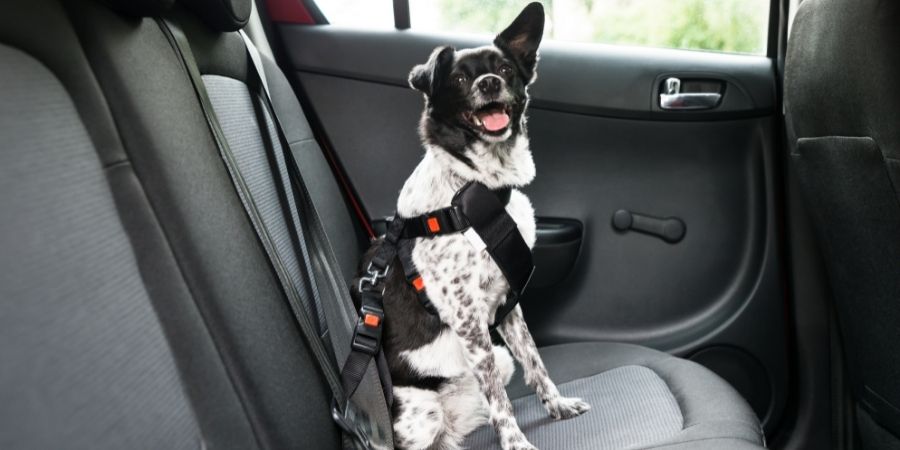
How to make car travel more comfortable for your pet
When it comes to travelling in the car, all pets will be different – some will have no problem travelling, and others will hate it! Luckily, there are plenty of things you can do to make the journey more relaxed and comfortable for your four-legged friend. Here’s our tips:
- Start young: Pets who are used to travelling in the car from a young age are much more likely to be relaxed and comfortable during car trips. Introduce them to the car as early as you can as part of their socialisation . Start out by introducing them to the parked car and get them used to sitting in it with you, and then begin making short trips. You can then build up to longer journeys, while making sure their experiences are as positive as possible by ending the journey with something fun such as a treat, a walk or an exciting day out.
- Give them time to digest: If your pet gets car sick, try not to feed them right before a car ride. Make sure they have plenty of time to digest their meal, or leave it until after the car journey. If they get car sick even on an empty stomach, which some pets may, talk to your vet to see if they can have medication to help settle their tummy.
- Take a break: If you’re taking your pet on a longer journey, make sure they get a chance to stretch their legs and have a drink. Break up your journey with a trip to a park or dog-friendly attraction, or stop at a service station that has a dog walking area – a break is good for us, too!
- Keep them cool: Cars can warm up really quickly, so it’s important to be aware of your pet’s temperature when you’re on the go, and remember to pop the air conditioning on or open a window to keep them cool.
- Don’t let dogs stick their head out the window: Letting your dog stick their head out of the window can be dangerous – they could knock their head on something, fall out of the window, be injured by stones kicked up by the tyres, or distract other drivers.
Safe car travel in hot weather
Warm weather offers the tempting opportunity to get out and about with your four-legged friend, but don’t forget that a warm day for us is even hotter in a fur coat! Whether you’re taking them to visit family, road-tripping for a holiday, or visiting the vets, it’s important to be prepared for hot weather and think ahead about travelling safely and beating the heat.
Here are our top tips when travelling with your pet during the warmer months:
- Travel in the early morning or late evening: These tend to be the coolest times of day so will make the journey easier on your pet.
- Take plenty of water: Make sure you offer water to your pet regularly throughout your journey. You could try a non-spill water bowl , so your pet has access to water for the whole trip.
- Check the temperature in the back of the car: Although most cars have great air conditioning for the front seats, the back seat or boot can heat up very quickly and become dangerously warm for your pet, especially if they are in a carrier with less airflow. If it’s getting warm, open the windows, adjust the fans so that they are facing into the back seat and make sure you remove the parcel shelf – use a pet carrier or boot guard to keep your pet secure instead.
- Use cooling aids: Providing your pet with a cooling mat to lie on during the journey, can help keep them nice and cool.
- Stop regularly to check your pet: If they’re starting to breathe heavily or look warm, stop for a while and let them cool and calm down. If you’re travelling with your dog, try to plan a few stops for short walks out of the sun or visit a dog friendly café for lunch along the way, to keep the journey fun.
- Try to minimize the time in the car: If you’re going to an appointment, try to arrive at the right time so you won’t be waiting in the car too long. If you know there’s often a lot of traffic, try to leave at a different time and avoid busy roads so the journey is as quick as possible. Small changes can make a big difference to your pet, especially as the temperature in the car tends to rise if you’re stuck in a traffic jam in the sun!
- Keep the car cool: When you park, take your pet out of the car as soon as possible, and try to leave your car in the shade. Consider using towels or a sun shade to cover the windows and block direct sunlight, keeping the car cooler for you and your pet when you get back in. If you’re waiting in the car with your pet, open the windows on the shady side and put on the air conditioning to keep you both cool. Never leave your pet alone in the car – remember, not long is too long.
Dogs die in hot cars
Many people believe it’ll never happen to them, yet every year people gamble with their beloved dog’s life and every summer dogs die in hot cars.
Even parked in the shade with the windows open, a car can quickly become an oven. When it’s 22°C outside, within an hour the temperature in a car can reach an unbearable and deadly 47°C. If your dog’s internal body temperature exceeds 41°C, it can be fatal.
If you’re out and about in the summer, don’t take your pooch with you if it’s likely you’ll have to leave them in the car. Look for dog friendly days out, or find alternative care for your dog. Even if you're popping to the shop for a minute or two, a delay or an unexpected occurrence could lead to tragic consequences for your dog – it’s not worth the risk.
What to do if you see a dog in a hot car
If you see a dog in a hot car, it’s important to ask yourself whether they are showing any of the following signs of heatstroke :
- Is the dog panting heavily?
- Is the dog drooling excessively?
- Does the dog appear lethargic, drowsy, or uncoordinated?
- Is the dog collapsed or vomiting?
If you see a dog in a hot car showing any of these signs, dial 999 immediately.
Many people's instinct in this situation would be to call the RSPCA, or other welfare organisations. In an emergency, RSPCA inspectors may not be able to attend quickly enough, and because they have no powers of entry, they would still need police assistance. Don't ever be afraid to dial 999 – the police deal with hundreds of such incidents each year.
If the situation becomes critical for the dog, and the police are too far away or unable to attend, many people's instinct will be to break into the car to free the dog. If you decide to do this, please be aware that, without proper justification, it could be classed as criminal damage and you may need to be prepared to defend your actions in court.
Make sure you tell the police what you intend to do and why, and take images and/or footage of the dog and the names and numbers of witnesses to the incident. The law states that you have a lawful excuse to commit damage if you believe that the owner of the property that you damage would consent to the damage if they knew the circumstances (section 5(2)(a) Criminal Damage Act 1971). If you need legal advice, please speak to a lawyer.
What to do if the dog is not showing signs of heatstroke
If the dog is not yet showing signs of heatstroke, here's some steps to follow:
- Look out for the owner of the vehicle. If you’re at a shop, supermarket or event, ask the staff to make an announcement to let the owner know about their dog’s condition.
- Look for indications of how long the car has been there for – a parking or pay and display ticket could help.
- Take note of the car’s registration number. If you’re worried about the dog’s welfare, you may wish to report the incident to the police.
- While you’re seeking help, try and get someone to stay and monitor the dog’s condition. If they show signs of heatstroke, dial 999 immediately.
You can call the RSPCA’s cruelty line for help and advice. But if the dog is in danger, dial 999 immediately .
Planning the perfect dog-friendly staycation
Why not involve your four-legged friend and plan a UK staycation with your favourite pooch this summer?
FREE first aid guide
Would you know what to do if your pet was involved in an accident or stopped breathing? Download our FREE guide to find out what you can do
Travel essentials for pets
Shop our range of travel essentials on our online pet store.

Before you go!
Why not sign up for our newsletter to receive regular pet health advice from our vets.
- Cheap and Budget Friendly Recipes
- Health Related Illness Diets
- Homemade Treat Recipes
- Homemade Dog Treats for Health Issues
- Seasonal Recipes
- Can Dogs Eat…
- Dog Diseases & Conditions
- Dog Symptoms
- Dog Grooming
- Caring For Seniors
- Dog Loss & Grieving
- Dog Reproductive Health
- Treatments and Home Remedies
- Dry Dog Food
- Wet Dog Food
- Best Dog Products
- Dog Accessories
- Dog Health Products
- CBD for Dogs
- Toy Dog Breeds
- Working Dog Breeds
- Terrier Dog Breeds
- Sporting Dog Breeds
- Non-Sporting Dog Breeds
- Mixed Breeds
- Hound Dog Breeds
- Livestock and Herding Dog Breeds

Best Way To Travel with A Dog (A Video Guide)
If you've ever traveled with a dog, you know how stressful it can be. Whether you're just running down to the pet store or traveling across the country to visit your family, there are a number of things that you can do to make the journey easier. In my opinion, the best way to travel with a dog is by car.
This article will share tips and tricks for traveling with dogs in cars, planes, trains or any other method of transportation. I think that car travel is the best because it's easiest and it's the most comfortable for your dog.
Your dog may have to be separated from you while flying or traveling by bus or train. At the very least he will need to be confined to a kennel or travel bag . While he should be restrained in the car, he'll be with you. That will make you both feel more comfortable.
ALSO READ: 15 Safety Tips for Traveling with Dogs in Cars
Best Way To Travel with A Dog
Preparing to travel with a dog.
Traveling with dogs isn't always easy, even if your pup likes to ride in a car or doesn't mind a plane flight. You need to be prepared for the trip. Think about the trip, make the necessary arrangements and gather the supplies you'll need in advance.
At the very least, you should bring the following supplies with you while traveling with your dog:
- Food, treats and water
- Airline-approved carrier (if needed)
- Harness, collar and leash
- Travel-friendly crate (if needed)
- Dog car seat or seat belt (if needed)
Of course, the supplies you'll need will depend on the type of transportation you'll be using and where you are traveling to. If you're just taking a short day trip, you won't need to pack much. However, if you'll be spending a week camping with your dog your packing list will be much longer.
You'll also need to make sure that your dog is healthy and physically ready to make the trip. This is especially important if you'll be flying with your pet. If you have concerns about your dog's health, call your veterinarian and ask for their advice. Depending on where you're going, you may need to get your pet updated on vaccines before leaving home.
You should also bring along a pet first aid kit and be prepared for any medical needs that may arise. Make sure that your dog has updated ID tags and/or an up-to-date microchip. You should also have the contact information for an emergency veterinarian in the area where you will be traveling. Bring a list of your dog's medications or any important health information that an emergency vet may need to know.
RELATED: How To Prevent and Treat Your Dog's Car Sickness

Tips for traveling with a dog
If you're looking for tips on specific forms of travel, these resources may help answer your questions:
- Flying with A Dog – Short Dog Travel Guide for Pet Parents
- Are Dogs Allowed In Airports? And Tips for Air Travel
- Tips for Traveling with Your Dog
- Dog Car Anxiety – 5 Ways To Solve It
Allow for extra time when traveling with your dog. Everything is going to take longer. If you're traveling in the car, you'll need to stop every hour or so for bathroom breaks. Checking in for a plane or bus trip will take longer if you're bring your dog along. It will also take longer to get yourself and your dog settled when riding on public transportation.
It is best to plan ahead and see what hotels and restaurants are pet friendly ( and there are many in the US ). You should have your lodging already planned and reservations made before you leave for your adventure. While there are some that don’t allow dogs at all, most places will make arrangements.
Be clear on what the rules are if you're traveling by plane, train or bus. You'll also need to know the rules of any hotels you may be staying at. It will be embarrassing and very inconvenient if you don't know the rules in advance.
Unless you don’t mind going through the drive thru all the time, it is best to plan places to eat as well. It is always best to plan your vacay and locate rest stops and eating places that are pet friendly. With the growing number of extreme dog lovers, these establishments are located in virtually every city in the world. Most restaurants, hotels and resorts will always accept dog owners.
Finally, be sure that you are always respectful when traveling with your dog. Clean up after your dog if he uses the bathroom in a public area. Make sure your dog stays quiet when you're in a public space or staying in a hotel.
I know it's difficult to believe, but some people do not like dogs. You may even encounter people that are scared of dogs. Always keep your dog on a leash and be respectful of the other people around you.
READ NEXT: 25 Most Travel Friendly Dog Breeds

LATEST FEATURES
Can I Afford A Dog?
How to Get Rid of a Dog: The Right Way
Why Are Dogs So Loyal?
Why Do Pets Make Us Happy?
Dog Names Starting With Z
How Many Dogs Are Too Many?
Can Dogs Get Sick From Humans?
Dandie Dinmont Terrier Breed Profile
Dog Names Starting With Y
Can Dogs Be Blood Donors?

- Terms of Use
- Privacy Policy
- No AI Clause
How to Travel With Your Dog: The Ultimate Guide

In This Article
Though there are great pet sitters and boarding facilities available, nothing beats a road trip with your pup.
These fur-filled getaways—especially the first one—take preparation. So, how can you get ready for your trip? Here's what you need to know to keep your fur baby safe and comfortable on the road.
Speak With Your Veterinarian
Dr. Jana Bryant , DVM, a veterinarian at CityVet in Las Colinas, Texas, has two large Labradors .
Her kids beg her to take the pups on every trip, big or small. According to Bryant, loop your vet into your plans before hitting the road with your dog .
Get Essential Vaccinations
“Ask your vet if your pet needs any additional vaccinations,” Bryant says. For example, if you’re traveling to the Northeast United States ( where deer tick populations are highest ), make sure that your dog is prepared with a Lyme vaccine and tick preventative .
For trips to the southern parts of the United States, dogs should receive leptospirosis vaccinations.
Get a Health Certificate
Dog health certificates state that your vet has examined your fur baby and they don’t appear to have any potentially contagious diseases.
Health certificates are typically good for 30 days, though some airlines require a health certificate dated within 10 days of travel.
Update Your Medical Records and Microchip ID
Ask for an electronic copy and/or a printed copy of your pup’s most recent medical records. This is also a good time to ensure your dog's microchip information is accurate, too.
Get Ahead of Motion Sickness
About half of pet parents and their dogs travel by car , and some of those pups experience motion sickness .
Signs of motion sickness include excessive drooling, licking of the paws, whining, or yawning. If this sounds like your dog, Bryant suggests asking your vet if an anti-motion sickness medication could help.
“Many puppies will grow out of motion sickness. However, we want to prevent them from feeling nauseous in the car, as it can lead to a negative association with car rides as they grow older,” she says.
Does Your Dog Need Calming Aids or Sedatives?
If your dog is easily excitable, anxious , or reactive , consider whether a trip is the best choice for them. If your pup must travel, it’s very important to consult with your vet before purchasing any calming supplements or aids .
“There are many over-the-counter supplements that aren't tested for safety or purity," Bryant says.
Your vet may prescribe medications to help your dog sleep through car or train rides.
However, your vet may not recommend giving your pup a sedative if they have any underlying health conditions before flying, such as liver or heart disease .
Alternatively, sedatives may not be allowed by the airline, as sedatives can increase the risk of issues in a pup’s ears during pressure changes, as well as lung and heart problems.
Do Your Research
Plan your route.
Leigh Siegfried, a dog behaviorist, and founder of Opportunity Barks , maps out her route before taking a trip with her pup. She makes sure to plan a few potty stops for her dog.
While rest stops are convenient, they are often along major highways and lack green space. She recommends adding a park to your route. “Let your dog stretch, do some scent work , and really get a good amount of exercise ,” Siegfried says.
Locate Emergency Veterinary Offices
Make sure to have the name and number of a few urgent care vet clinics along your route and near your destination.
If you’re visiting friends or family, they may know of a trustworthy emergency vet. If they can refer a vet, give the office a call and ask them about their walk-in policy and what documentation you should have on hand.
Bryant also recommends packing a first aid kit with a minimum of these essentials:
Understand the Rules of Your Airline or Train Agency
In 1990, Gayle Martz helped change airline policies to allow some pets in passenger cabins.
If a dog’s carrier can’t find under the seat, pet parents can purchase a seat for their furry companions.
“Destinations, airlines, and rail lines all have their own rules and regulations,” Martz says. “That's why I do my research before traveling with my pup.”
For example, dogs traveling with American Airlines must be at least 8 weeks old and cannot be on tranquilizers or sedatives. Additionally, brachycephalic breeds are not permitted to travel in cargo.
Dogs can’t be exposed to air temperatures above 85 degrees Fahrenheit or below 45 degrees Fahrenheit for more than four hours.
If the weather is too hot or too cold at your departing airport or destination, your dog won't be allowed to fly, even when meeting the above requirements.
Here are a few other factors to take into consideration:
Make a reservation for your dog . Airlines and train agencies typically have a limited number of spaces for pets in the passenger cabin.
Your dog must be up to date on their vaccinations . Flying internationally with a pet may require additional vaccines and/or documentation. Your pup may need their health certificate approved by the USDA’s Animal and Plant fit Health Inspection Service (APHIS) .
Your dog must be in a carrier for the duration of the flight or train ride . However, you may need to take your pet out of the carrier while passing through security so that their bag can be scanned. “Airport security will tell you how to proceed,” she says. “It’s important to be discreet, compliant, and respectful with your pet.”
There may be pet fees . The amount varies by airline or train agency. Contact the company you’re traveling with to see how much you can expect to pay.
Prepare Your Pup
You don’t want to wait until the day of your big trip to introduce your dog to their travel gear.
Siegfried stresses that they should be comfortable with their gear before you take them on the road.
For example, your dog should be prepared for the confinement and limited movement of a seat belt tether before clipping them in.
The first step is letting your dog sniff and investigate their gear.
Then, put the gear on your dog for short periods in your house. Create positive associations by praising them, playing with them, or giving them a treat while they use the equipment.
Slowly work up to taking your dog outside in the gear, clipping them into their seat, or securing them inside their crate in the car.
Pack the Essentials for Your Pup
Whether you and your pooch are taking off for an overnight trip or a weeklong getaway, be sure to check off the must-haves on our dog-friendly packing list:
Toys . When traveling with your dog, it’s important to pack a few items that they love and will help them feel comfortable and entertained. “I like to pack enrichment toys that I can stuff with food ,” Siegfried says. Other items to consider are your dog’s favorite stuffed animal , tug toys , and a ball for playing fetch . If you’re flying, be sure to pack a few (non-squeaky) options in your carry-on.
Water and a travel doggy water bottle and/or collapsible bowl. No matter the temperature, water bottles and bowls are always essential. “An excited dog is typically too busy sniffing to remember to drink, so you may need to wait until they calm down to encourage them to have some water,” Bryant says.
Food and a travel food bowl. Using a kibble carrier (rather than lugging a bag of kibble around) helps cut down on the amount of luggage you’re carrying and will help keep your dog’s food fresh. Make sure to purchase a travel food bowl for your pup as well.
Medication . Your dog’s medications are essential, and they’re even more important on a road trip. Bring extra doses in case the road trip goes longer than originally anticipated or you misplace it. If your dog’s medication needs to be refrigerated, ensure your pet-friendly accommodation has an in-room or community refrigerator. While traveling with the medication, be sure to keep those meds cool by placing them in a refrigerated backpack or cooler.
Treats . Spoiling your pup with a handful of treats just before a car ride or take-off isn't a great idea. However, pack high-reward training treats to reinforce positive behavior throughout your trip. Zukes , Vital Essentials , and Fruitables are all good options.
Bathroom essentials . You can never be too prepared for accidents, so consider throwing an enzyme cleaning solution in the car, poop bags , and a few extra potty pads in your carry-on. Grab a plastic trash bag or two for any soiled pee pads.
Crate . Not all dogs are trained to rest or travel in crates. If your dog is crate-trained , buy a good crate that's collapsible . This can help your pup feel at ease, especially if you’re able to use it at your destination. Add all the necessities that your dog requires to be comfortable in their crate, such as a quilted mat or a battery-operated fan if it's warm.
Bedding . With all the excitement of travel, your pup is sure to want somewhere cozy to nap. Travel beds are typically machine washable, quick-dry, and come with a carrying case that’s small enough to serve as a carry-on. A portable sound machine may also help your pup get a restful night of sleep.
Find the Right Travel Carrier
When traveling with your pet, it’s important to choose a carrier that meets the size requirements of the airline or train agency you will be using.
Amtrak requires that dog carriers be no larger than 19 inches long, 14 inches wide, and 10.5 inches high, while United Airlines restricts hard-sided carriers to 17.5 inches long, 12 inches wide, and 7.5 inches tall.
In addition to regulation size, there are a few other essential features to look for in a dog carrier:
A leak-proof bottom to prevent accidents
Good ventilation to keep your pet cool and comfortable
Fit under the seat in front of you (depending on your pup’s size)
Enough space for your pet to stand up and turn around
Martz's favorite pet carrier for travel is the Sherpa carrier , which she created out of love for her dog Sherpa.
The Sherpa carrier meets the requirements of most major airlines and is even backed by the Worldwise Guaranteed On-Board™ program .
This program will refund the cost of your airline flight and your pet airline travel fee if you can't board a flight because of your carrier.
Stay at Pet-Friendly Places
Choosing the right accommodations is important for anyone, but it's especially important when your pup is in the mix.
When it comes to finding pet-friendly accommodations, there are a few tips and tricks to make the search easier.
Use a pet-friendly travel website or app . These include BringFido and GoPetFriendly , though Airbnb and Vrbo also have pet-friendly filters.
Contact the accommodation directly . Even if a property doesn't advertise itself as pet-friendly, it's always worth a call to see if they'll make an exception for your fur baby.
Ask your friends, family, and social media contacts for recommendations . People who have traveled with their pets before will likely have some good recommendations for pet-friendly places.
Choosing to stay at a pet-friendly accommodation while traveling with your dog ensures they’re welcome and that you’ll have everything you need to make their stay comfortable.
Even though a hotel is pet-friendly, you should still call ahead to ask what their pet policies are.
Understand the Cost and Budget Accordingly
It’s important to understand the cost of traveling with your pet, which can vary depending on your means of travel and the airline or train line, the destination, and the size of your dog.
Pet Travel FAQs
Can i travel with a dog internationally.
If you want to include your dog in your international travel plans, contact the visiting nation’s embassy or consulate to find out what their customs policies are.
Some countries (and Hawaii ) require pets to undergo a quarantine period to reduce the spread or introduction of diseases such as rabies , which means additional lodging costs for the traveler.
Using a pet travel agency such as Pet Airways or PetAir can help you find a pet-friendly flight, book your tickets, and make sure your pup meets all the requirements.
If I’m traveling to a distant destination, can I travel with my dog in the car?
Pets can travel long distances by car safely if they are properly prepared . They should be secured in a crate, carrier, booster seat , or seat belt harness that’s the right size for them.
Featured Image: Stock.adobe.com/FedBul
USDA APHIS | Care and Handling of Pets During Air Travel—Instructions (Lesson 2). Usda.gov. Published 2020. Accessed September 7, 2023.

Freelance Writer
Help us make PetMD better
Was this article helpful?
Related Articles

Subscribe to Our Newsletter
Sign up for weekly pet health tips and insights from our veterinarians.

Traveling With Dogs: Tricks and Tips for a Smooth Journey
B ringing your dog along for a vacation can make the experience even more enjoyable for the whole family. But before you hit the road and start traveling with dogs, it’s essential to consider the extra planning and preparation that is necessary for their health and safety during the trip.
Keep in mind, not all dogs enjoy traveling, and some may not be in the right mental or physical shape for it. It’s necessary to have a plan in place to ensure that your dog is comfortable and safe throughout the journey.
From finding the right travel crate to ensuring your dog has proper identification, to planning out your hotel stays, I’ll walk you through all the necessary steps to make your vacation with your dog a truly memorable and enjoyable one.
Schedule a Pre-Trip Vet Checkup
Before embarking on an adventure with your dog, it’s a good idea to schedule a visit to the vet to ensure that they are in good health and ready for travel.
This visit not only allows you to ensure that all vaccinations are up-to-date and that your dog is in good physical shape, and gives you an opportunity to discuss any concerns or special needs your dog may have when it comes to traveling.
For example, your dog may have a fear of flying or may have a medical condition that makes flying unsafe, so your best bet would be a road trip with your dog instead, If you are flying with your dog, the airlines will require a health inspection, generally within 10 days of travel, so make sure you time things correctly!
Your vet will be able to advise you on how to handle these situations and give you peace of mind that you and your dog are ready for the journey. They can review if anxiety medication would be a good idea for your dog if they struggle with car rides.
By having a pre-trip vet check-up, you will be able to be proactive in case your dog has any health issues that may arise during the trip. This will allow you to take action immediately, avoiding potential complications and making sure that your dog receives the best care possible.
Plan For Medical Emergencies
When traveling with your dog, be prepared for any emergency or health-related issues that may arise. First, make sure you have your pet’s medical records with you. This includes their vaccinations, medication and any other relevant information that a veterinary professional might need to know.
Have the contact information of at least one veterinarian in the area where you will be staying so you can get help quickly if needed. You can research the location of the nearest 24-hour veterinary emergency hospital at your destination and save the number in your phone or screenshot their phone number so you aren’t scrambling in an actual emergency.
Pack a doggy first aid kit that includes items such as bandages and antiseptic ointment. Bring any medications that your pet is currently taking and make sure they are properly labeled in case there are any mix-ups.
Having a plan in place is not only about being prepared for the worst-case scenario, it’s also about being able to enjoy your vacation without stressing about your dog’s well-being if they get into something they shouldn’t!
You can have peace of mind knowing that you are prepared for any situation that may arise, and you can focus on enjoying the journey with your dog. In case of an emergency, your dog will receive the best care possible, and you will be able to act quickly and efficiently thanks to the information and resources you have at hand.
Prep With The Right Travel Essentials
When traveling with your dog, bring along all the essentials to ensure their comfort and well-being during the trip. This includes bringing along a supply of their regular food, plenty of water, as well as any medications they may require.
You’ll need to consider the type of travel you will be doing and bring any necessary items such as a crate for air travel or a dog seatbelt for car travel.
Bringing along your dog’s favorite toy or their comfortable bed can help them feel more at home and reduce anxiety in unfamiliar surroundings. Bring extra poop bags for accidents and potty breaks. Traveling can be rough on all of our tummies, including our dogs, who often have no idea what’s going on!
Remember that traveling with a dog is not just about bringing the essentials, it’s also about making sure your pup is comfy and happy throughout the journey. By bringing their favorite toy or a comfortable mat, you can create a sense of familiarity and make the trip less stressful for them.
Using Crates for Safe Travel
The advantages of using a crate for travel.
When traveling with your dog, a crate can provide a number of benefits to ensure their safety and comfort. For air travel, a crate is often a mandatory requirement, and it can be used as a safe space for your dog while in a hotel or at a host’s home.
Crates can also be used during car travel, providing a safe and secure environment for your dog while in transit . After flying Roxy and Rico from Alaska to Colorado, we started taking them on tons of road trips.
Using a crate makes life easier as they’re used to them, it keeps them a bit more safe in case of an accident, and helps reduce their reactivity to situations like when our car was completely surrounded by mountain sheep at Mount Evans!
Using a crate allows you to have peace of mind knowing that your dog is safe and secure. In case of an emergency, the crate can act as a barrier and protect them from any potential hazards.
Crates provide a familiar space for your dog, reducing their anxiety and stress while traveling. It’s a place where they can retreat to and feel safe and secure. Roxy and Rico are so much calmer in their crates than when we travel without them.
Dog crates can a helpful training tool for your dog. By gradually getting them used to the crate before the trip, it can make the transition to travel smoother and less stressful for them.
How To Pick The Right Dog Crate
When selecting a crate for travel with your dog, consider certain criteria to ensure safety, comfort, and compliance with travel regulations. The crate should be large enough for your dog to stand, turn, and lie down comfortably, and be made of strong materials and free of any interior protrusions that could harm your dog.
A leak-proof bottom covered with absorbent material and ventilation on opposing sides is also important for your dog’s well-being. When we travel with Roxy and Rico, we use a crate mattress like this one for them to be comfortable.
When purchasing a crate for air travel, make sure that it complies with airline requirements to ensure that your dog can travel safely and comfortably.
Identification and Recovery Measures
Identifying your dog while traveling is essential in case they get lost or separated from you. A sturdy leash and collar with identification tags are a must-have when traveling with your dog.
The collar should have identification tags with the dog’s name, your name, and your phone number and address. Some places require a rabies tag on there as well, so be mindful of that if it’s required at your home or your destination.
Remember that collars and leashes not only serve as a means of identification but also as a means of control and safety. A sturdy leash and collar can prevent your dog from running away or getting into dangerous situations.
Practice using the leash and collar before your trip. By getting your dog used to wearing it and walking on a leash, you can make the transition to traveling smoother and less stressful for them.
By having proper identification on your dog and getting them used to their collar and leash, you can greatly increase the chances of recovery in case of separation and ensure their safety while traveling.
Permanent Identification – Microchips
While collars and leashes can provide temporary identification for your dog, permanent forms of identification can offer added peace of mind and increase the chances of recovery in case of separation.
Microchipping is a safe and permanent method of identification that involves inserting a small chip under your dog’s skin. This chip contains a unique identification number that can be scanned by veterinarians and animal shelters, making it easier to reunite lost pets with their owners.
Furthermore, microchipping is a one-time procedure that doesn’t require any maintenance and it can last the entire life of your pet. It provides a layer of protection against theft and lost as well as offering an additional way to prove ownership.
Update your contact information with the microchip registry as soon as possible after any changes in your contact information. This way, if your dog is ever lost and found, they can be quickly and easily returned to you.
By microchipping, you can greatly increase the chances of recovery in case of separation and ensure the safety of your pet.
Photo and Health Records
When traveling with your dog, it’s essential to have a recent photo of your pet and their health records on hand. A clear and current photo of your dog can greatly assist in identifying them in case they get lost or separated from you. This will help shelters and rescue organizations to identify your dog and reunite them with you as soon as possible.
Having a copy of your dog’s health records can be extremely helpful in case of an emergency. This includes vaccinations, medications, and any known health conditions. This information can be used to make sure that your dog is in compliance with any travel regulations and can provide vital information to veterinarians in case of an emergency.
Keep a copy of these records in a safe place, such as your email, a cloud-based storage, or with a trusted friend or family member, so that you have access to them even if you lose your original copies.
Our Dog Health & Wellness Journal has everything you need to keep your dog happy, healthy, and safe. It’s perfect for bringing along when you travel, so you have all your dog’s vital information handy. Grab it on Amazon here!
C. Crate Preparation
Preparing your dog’s crate for travel is just as important as selecting the right crate. By stocking the crate with familiar items such as a comfortable mat, your dog’s favorite toy, and a water bottle, you can create a sense of familiarity and comfort for your dog. This can greatly reduce their anxiety and stress while traveling.
Make sure the crate is clean and free of any debris or odors. This can help prevent any potential health issues and ensure that your dog has a clean and comfortable environment while traveling.
Get your dog used to the crate before the trip. By gradually introducing them to the crate and allowing them to explore it at their own pace, you can help them become more comfortable with it. This can make the transition to traveling smoother and less stressful for them.
Overall, by properly preparing the crate and getting your dog used to it, you can create a sense of familiarity and comfort for them during travel. This can greatly reduce their stress and anxiety, making the trip more enjoyable for everyone.
Traveling by Car
Familiarization with the car.
When it comes to traveling with your dog by car, prepare them for the experience in advance. One of the best ways to do this is by familiarizing your dog with the car. This can be done by letting them sit in the car with you without leaving the driveway, and then going for short rides.
By doing this, your dog can become accustomed to the sights, sounds, and smells of the car, reducing their stress levels when it comes time for the actual trip. This process can be beneficial for dogs with car sickness, as they can get used to the motion of the car before the longer trip.
Make sure that your dog is comfortable in the car. You can do this by providing them with a comfortable mat or blanket, and their favorite toy. This will help create a familiar and safe space for your dog and make the trip more pleasant for them.
Overall, by familiarizing your dog with the car and making sure they’re comfortable, you can greatly reduce their stress levels and make the trip more enjoyable for both you and your pup.
Carsickness Prevention
Carsickness is a common issue that can affect dogs, just as it can affect humans. It can cause them to feel nauseous and can make the car ride an unpleasant experience for both you and your dog. To prevent carsickness, take steps to make the car ride as comfortable as possible for your dog.
One way to do this is by feeding your dog a light meal before the trip, this way they will not have a full stomach and it will reduce the chances of them getting carsick. Providing plenty of fresh water for your dog during the trip will help them stay hydrated.
Make sure that the car is well-ventilated, this way your dog can breathe fresh air, which can help reduce the chances of carsickness. If your dog is traveling in a crate, make sure that the crate is well-ventilated, this way fresh air can flow in and out.
If your dog is prone to carsickness, you may want to consider consulting with your veterinarian to see if there are any medications that can help prevent carsickness.
Overall, by taking steps to prevent carsickness, you can make the car ride a more comfortable experience for your dog and ensure that both you and your dog enjoy the trip.
Keeping your dog safe while traveling by car is crucial for a successful and enjoyable trip. One of the most important things to consider is using a crate or a dog seat belt to keep your dog secure. This not only protects your dog in the event of an accident, and prevents them from distracting you while driving.
Another safety measure is to never let your dog ride with his head sticking out of an open window. This can lead to eye injuries and other accidents. Never let your dog ride in the back of an open truck. This is extremely dangerous and can lead to severe injuries or death.
Make frequent stops for exercise and potty breaks. This will not only keep your dog happy and healthy, and give you a chance to stretch your legs. Be sure to clean up after your dog and always supervise them during these breaks.
Lastly, never leave your dog unattended in a closed vehicle, particularly in the summer. The temperature inside a closed car can quickly become dangerous for your dog.
Overall, by following these safety measures, you can ensure that your dog is protected and secure during the car ride and make the trip a more enjoyable experience for everyone.
Safety Tips
In addition to using a crate or seat belt, and avoiding open windows and truck beds, there are other safety tips to keep in mind when traveling with your dog in the car.
One of the most important tips is to make sure that your dog is well-trained and obedient. This way, they will follow your commands and stay calm during the car ride.
Another tip is to instruct your children not to tease or annoy the dog in the car. Car rides can be boring for everyone, and a frustrated dog can become a safety hazard.
Be aware of the weather conditions and plan accordingly. If it’s hot outside, be sure to bring plenty of water for your dog and make frequent stops to let them cool down. If it’s cold, make sure your dog is properly insulated and protected from the cold.
Be aware of the laws and regulations regarding traveling with dogs in your destination state or country. This will help you to avoid any legal issues and ensure that your dog is safe and comfortable during the trip.
Overall, by keeping these safety tips in mind, you can ensure that your dog is safe and secure during the car ride and make the trip a more enjoyable experience for everyone.
Frequently Asked Questions About Traveling With Dogs
How do i know if a hotel is truly pet friendly.
Traveling with your pet can be a great experience for both of you, but make sure that the places you’re staying are actually pet friendly. After all, you don’t want to end up in a situation where your pet is not welcome. So, how do you know if a hotel is truly pet friendly?
The first step is to check the hotel’s website or call ahead to confirm their policies. Most hotels will have information on their website regarding whether pets are allowed, and any fees associated with bringing a pet along.
They may have restrictions on the size and type of animal that they allow, so be sure to read through these carefully. It’s worth inquiring if there are any nearby parks or green spaces that would be suitable for walking your dog or letting them exercise.
In addition to checking the hotel’s policies, you should consider other travelers’ experiences with the hotel. Look for reviews online from people who have stayed at the hotel with their pets and find out what their overall experience was like.
This could give you an idea of how accommodating the staff were and whether there were any issues during their stay. It may help you identify potential problems before booking a room at the hotel; such as noisy rooms and lack of amenities specifically tailored for pets.
Should I Bring My Dog’s Own Food And Water Bowls?
If you’re planning to travel with your pup, consider what pet supplies you should bring. One essential item is a food and water bowl for your dog. Having their own bowls ensures that your pup is eating and drinking from a container that is clean and bacteria-free. Plus, their own bowls can be comforting and familiar for them in unfamiliar places.
When choosing the right food and water bowl for your pet, there are several factors to consider. The size of the bowl should be appropriate for the size of your dog so they can comfortably eat without spilling or making a mess. Look for bowls that are easy to clean and durable enough to withstand daily use. For convenience when traveling, collapsible bowls are a great option as they take up less space in your bag or backpack.
When selecting a food and water bowl for your pooch, think about their nutritional needs while on the road. Remember to bring along enough food and treats that will last throughout the duration of your trip – plus some extra just in case! Bring along bottled water or store-bought filtered water so that your pup stays hydrated during long days of sightseeing or hiking.
What Should I Do If My Dog Becomes Lost While Traveling?
When traveling with your dog, be prepared for any situation. One of the most stressful situations you may encounter is if your pup becomes lost while away from home. The first step in this situation should be to remain as calm as possible and begin searching for your pet immediately. Start by asking people nearby if they have seen your dog, and then start widening the search area. If you don’t find your four-legged friend right away, try to stay in the same spot so that you can become a point of reference for them.
Have contact information on hand just in case someone finds your pup before you do. Make sure their collar has up-to-date contact info and any applicable medical information. You may even want to consider having a temporary ID tag made before leaving home with emergency contact info just in case they become lost while on vacation. Microchipping is recommended as another form of backup identification in the event that they wander off without their collar or tags.
If all else fails, reach out to local animal shelters , vets or rescue groups who can help reunite you with your dog. Check online lost and found pet listings such as Craigslist or Facebook groups for people who may have spotted your dog along the way.
With these steps taken beforehand, you can hopefully increase the odds of safely finding your pup and continuing on with a safe and enjoyable travel experience!
Sign up for our list and get a FREE printable pet identification sheet! It’s super helpful for pet sitters or if your dog wanders away for home!
How Do I Find Reliable Pet Sitters Or Dog Walkers Near My Destination?
Traveling with your pet can be a great experience, and having reliable help while you’re away in case you want to explore non-pet-friendly spaces makes it even better. A good way to find pet sitters or dog walkers near your destination is to do some research.
Start by searching online for services in the area that provide temporary care for pets, such as Rover. Check out reviews from others who have used them before. This will give you an idea of what kind of quality and reliability they offer. Make sure to read through the policies and procedures carefully before making your decision.
Another option is to ask friends or family if they know of any reputable pet sitting and dog walking services in the area. They may be able to provide information about experiences they’ve had with particular companies or people who offer these services.
Ask them questions such as how long have they been in business, what kind of training do their employees receive, and whether the company has insurance.
Once you’ve identified a few possible options, contact each one and ask questions about their rates, availability, and any special needs your pet might have.
![Bringing your dog along for a vacation can make the experience even more enjoyable for the whole family. But before you hit the road and start traveling with dogs, it’s essential to consider the extra planning and preparation that is necessary for their health and safety during the trip. Keep in mind, not all dogs enjoy traveling, and some may not be in the right mental or physical shape for it. It’s necessary to have a plan in place to ensure that your dog is comfortable and safe throughout the journey. From finding the right travel crate to ensuring your […] Bringing your dog along for a vacation can make the experience even more enjoyable for the whole family. But before you hit the road and start traveling with dogs, it’s essential to consider the extra planning and preparation that is necessary for their health and safety during the trip. Keep in mind, not all dogs enjoy traveling, and some may not be in the right mental or physical shape for it. It’s necessary to have a plan in place to ensure that your dog is comfortable and safe throughout the journey. From finding the right travel crate to ensuring your […]](https://img-s-msn-com.akamaized.net/tenant/amp/entityid/AA1mVizp.img?w=768&h=576&m=6)

Traveling Cross Country with a Dog: Great Travel Hacks + Guide
Disclosure: This article contains affiliate links and is a member of Amazon Services LLC Associates Program, meaning when you make a purchase, I earn a small commission. Affiliate links cost you nothing to use, and help keep my content free. It’s a win-win for us both! For more info, see the Privacy Policy
I can totally guess your favorite dog breeds based on how you travel
Take this quiz to see which breeds match your style!
Have you been wondering about the best ways to take a cross country road trip with your dog?
We have driven over 100,000 miles on the road with our dogs. We crossed borders, traveled top to bottom, and coast to coast within the United States. Our dogs have been along (lucky us!) for the journey. We have also done this in a car that only has space for us, our dogs, and the stuff we need for the trip. It doesn’t have to be anything fancy for you to have a great trip, but there are a few things that make a huge difference!
This guide weaves together our own experience as well as some of the professional recommendations that the AKC and the Center for Pet Safety provide for traveling with dogs. It is a huge topic, but I really wanted to focus on the things that are in your control and can make a difference between a chaotic trip and a smooth one.
My goal is for this to be useful whether this is your first cross country tip, or you just want some tips and tools to make your next trip go better than the last. Even for veterans there are some tools (see our packing list and food calculator ) that can help plan your cross country trip.
I hope this helps you on towards a great cross country road trip with your dog!

First, if in the back of your mind you are wondering “is it really so complicated you have to write a whole article?” then you are in the right place. As you will see, the actual “how to” is pretty straightforward. However, it is a lot of distance to cover, a lot of things can happen, so I want you to make the best of this trip. If you are like me, you want to know how to do this safely, comfortably, and efficiently.
A quick guide for a cross country road trip with a dog
This section is a quick review of the basic parts of a road trip. Skim through this part to make sure you didn’t miss anything, then keep reading to get to our hacks .
It helps to look at the simplest scenario: a solo cross country road trip where you are just trying to get coast to coast as quickly and as safely possible. Whether it is for fun or for necessity (like moving to a new place or an unexpected life event), a cross country road trip requires both you and precious pup to drive…and drive…and drive all the way across the map.
To achieve this you:
1) Plan your route 2) Drive 3) Make pits stops for food, water, bathroom, car fuel 4) Find and stay in accommodations that allow pets
Road trip essentials
So now with the power of the internet and some common sense, here is a quick guide to traveling cross country with a dog:
Plan and pack for your trip
- Use google maps or Wayze to plan your route
- Break the trip up into daily segments based on how long you can drive without getting tired (be conservative, this is a marathon not a sprint)
- Use the pet friendly filter on Expedia.com or Booking.com to find and book accommodations that allow dogs*
- Pack the basic dog necessities ( food , water, leash, poop bags, bedding, medicines)
- Pack your own travel necessities (clothes, toiletries, etc)
- Use a traveling harness or crate to keep your dog safe**
Hit the road
- Load up the car, get your dog comfy and secure
- Drive (so much driving!)
- Take breaks to keep you and your dog hydrated, fed, alert, relaxed and comfortable. Truck/travel are great pit stops usually with shade and good amenities
- Use shade, climate control, cooling devices/strategies, etc to keep your dog safe when you have to go inside without them (be very careful!)
- Check in to your accommodation. Sleep. Then begin again. * Accommodation is a huge topic all of its own but on trips where you spend one night in each place a hotel is usually your best bet for cost and convenience ** We will cover the benefits of safety restraints in more detail, but is also good to know that there are a growing number of states that by law require dogs to be restrained in your vehicle .
Yes. That’s it! Obviously, for your own trip this list might not be complete. If you are camping, or biking, or touring as a wandering minstrel and circus show … you’ll know best the special things and activities you require for your own adventure.
What should you pack for such a long trip with a dog?
If you have completed any kind of road trip with your dog already, I have good news! You probably have the essentials, but you might need a few extra things that are helpful on the road. If you want to double check that you have everything you need for a road trip, we put together a checklist for you. Our packing list is pretty comprehensive. Rather than exploding this post with long list, we put that at the end, and you can jump to that here if you want.
The checklist is also organized as a system, so the most frequent items are right at hand for you and your doggo, while the important but less used items are off out of the way.

Secure your dog with a Safety Harness or Crate
Both the AKC and the Center for Pet Safety are very clear that the best thing you can do to keep your pet safe is to secure them in a crash tested safety restraint such as a harness or crate. Since you will be spending a lot of time driving, it is one of the best things to minimize movement and distraction for you and your dog.
This can be a challenging topic, but we have a great Travel Hack that has worked really well for us (see Travel Hack #1 ).
TIP : Here is a surprising fact that has been true for all of our dogs. Safety restraints help our dogs settle into “driving mode “. If you help them get used to the setup, it becomes a familiar and even calming routine for them. We have terriers, folks, so if a terrier can get on board, yours can too.
What we have found most surprising is that when they are NOT in their harness or crate, they are more agitated, stressed and active. So bottom line in our car: we wear seatbelts, they wear seatbelts or go in a crate …it is just a part of safe and smooth driving.
3 Great Travel Hacks for a Road Trip With a Dog
Next let’s move next into the heart of this guide, and what I hope you’re really here for: how to maximize comfort, ease and safety.
There is no way around it, you are looking down the road at some serious amounts of travel and driving time. It can be a fun adventure. You might also find yourself wondering what if my dog gets anxious or how do I go to the bathroom if I’m solo driving and one of the biggest questions, what do I do if I need to leave my dog in the car?
So now let’s focus on how to make this trip safe and comfortable for everyone involved. Here are our 3 travel hacks that have really made a difference for us and we hope will for you too.
Travel Hack #1: Our Favorite Crash Tested Restraint
Since crates can take up more room in the back of the car, our first big tip is to use a crash tested safety harness for dogs up to 75 lbs.

We found that SleepyPod Clickit harness is the best for freedom of movement and flexibility while also being secure. We are able to use it as a harness both in the car and for walks. Sam is fine wearing it for long hikes. So it is both comfortable and very solidly constructed. This harness has sizes that fit larger dogs, so even labs can wear it.

For smaller dogs like Denver, a harness will not protect them. We found that the Sleepypod Air is also great. It is comfortable and is built to be secured by the seatbelt. Because it is made to sit in the car seat, we can move Denver in and out of it easily.
We don’t have personal experience with crates that get tied down in the back of a car. However, for larger dogs or to free up your backseat for other passengers, you may need a crate. The Center for Pet Safety tested and approved Cabela ‘s, Gunner , Lucky Duck , and Rock Creek Crates .

While none of these products are cheap, they are built with safety first. The reason why we like the safety harness is because it is one of the more affordable and flexible options.
There’s a great Facebook group for learning how to set up your crate in your vehicle.
Tip : Crates have different purposes and are not interchangeable. Wire house crates and plastic airline crates will not hold up to the impact of a crash
So to sum up here are some of the many reasons to use safety restraints. The biggest is to protect your most precious cargo. They deserve it!
- Safety : Protects your pup and passengers in case of an accident.
- Traffic Laws : Some states require safety restraints!
- Distraction Prevention : Keeps the dog from distracting the driver.
- Comfort : Ensures a more comfortable ride for your canine traveler.
- Stress Reduction : Lessens anxiety for both you and your pet.
- Emergency Preparedness : Easier to manage in unexpected situations.
- Vehicle Cleanliness : Keeps the dog hair, paw prints, etc in one consistent spot
Now do some dogs and their humans have a tough time with this equipment? YES , and yet dogs can learn to make it work. Traveling is a set of skills that almost every dog can master (more on this later).
Travel Hack #2: The Best Pit Stops for Traveling Solo with a Dog
The most efficient routes across the country are also major trucking routes. Gas stations that are built for truckers also make for great places to to take a break with your dog.
Recommended gas stations
Love’s are a pet parent favorite because they often have fenced dog parks TA Travel and Pilot are all over the United States Wawa and Sheetz are popular in many eastern states (and they have often superchargers) Buc-ees are great if you are down South
Our dogs may have seen Niagara Falls and the Golden Gate Bridge , but some of their favorite things have been grass patches at rest stops. I guess there’s a lot of “pee-mail”.
Dog-friendly retail stores are a lifesaver
There is a big problem when traveling solo, since travel stops serve food, you can’t take your dog inside . When the weather is extreme or when you are worried about the safety and security of your dog, retail stores are a great alternative!
Petco, Petsmart, Home Depot , Lowes , and TJ Maxx are just a few of the places that you can usually take your pet. They are large enough so that you can stretch your legs walking around. Home Depot and Lowes typically have big spacious bathrooms right near the entrance.
Note that many of these retailers have pet policies on a store by store basis, but we generally have not had any trouble just waltzing on in (thank you big box retailers!)
Tips for Leaving Your Dog in the Car (Travel Hack #3)
At some point, you will need to leave your dog unattended in the vehicle. It is almost unavoidable, especially if you are traveling solo. There are a few things people do that can really help when you need to leave your dog in the car to use the bathroom, grab something to eat, etc.
The method that works best for you will depend on the type of car you have.
- Remote Start : turn on climate controls while outside of the vehicle (newer cars)
- Physical Key : leave the fob in the car to keep it running, take the physical key out and lock it
- Tesla Dog Mode (This is a life saver. Never heard of it? Well, read on…)
- 3rd party vehicle cooling systems : these are especially popular with sprinter vans and RVs, but you can use them in a regular car too.
- Park in the shade: even on cool days, direct sun can make your car crazy hot
Please be very careful , even with automatic climate controls like Dog Mode, there are some risks to leaving your dog alone in the car especially in extreme heat.
Tips for what to look for in a vehicle
Most folks will just be using the vehicle that they have for their road trip. It is such a big ticket item and car rental prices can be stiff, so most of the time you just go with what you have. However, if you find yourself needing to rent a vehicle or actually are planning on getting a car that is great for traveling with a dog, then it is worth spending a little time on the topic. It is the MAIN piece of gear for your road trip.
Obviously we will only touch the surface here. Cars, trucks, vans all are such a huge topic that depend heavily on budget, style of travel and the size of your dogs. But I have been surprised at how little the “Top Vehicles for Dogs” articles focus on the things that are actually useful for traveling with a dog.
So here are our major features to pay attention to:
- Cargo Space : very important for dogs traveling in crates. You need generous space AND the seats need to lie completely flat
- Remote Start : most new cars will have this, helps keep your dog safe in a pinch
- Automatic Doors : easier to get in and out with your pup and all the stuff
- Configurable Space : seats that easily fold, seats that lie flat (for crates). Sometimes you need to have space for your dog(s), sometimes you need it for people.
- Easy to Clean : dog hair, muddy paws, you know the drill. Can the materials handle it?
Benefits of EV cars like Teslas when traveling with a dog
Dog Mode: this is amazing! It allows you to set the climate of the car to stay the same while you are away. Your dogs can stay comfy in their car while you grab a bite to eat or pop into a store. Using the Tesla App you can monitor the car to make sure the climate is staying on.
Safety Features: Tesla is also the safest vehicle on the road as independently tested by a bunch of different organizations. It has both active and passive safety features to protect you and your pups.
The main drawback – Charging . Our experience with EV Charging is mixed. Charging can be a hassle and in the middle states, the charging infrastructure is sparse. On the flip side more and more hotels are adding charging stations. So forget the gas station, if your hotel has EV charging you can be all fueled up and ready to go in the morning. So there are both pluses and minuses. Interested to learn more? Take one for a test drive ! You can both get some perks and send some thanks my way by using my referral code when you do a test drive or if you go all the way and get one for yourself! Use this link :

Traveling is a skill and your dog can learn it (Bonus Tip)
One last tip is a special combo that can really help your dog become a great traveler on the road and in life in general. A safe space helps your dog keep something familiar through all the changes. A learning mindset helps both you and your dog adjust to all these changes.
A safe space might simply be a favorite blanket and/or toy. The ideal safe space can easily be moved from the car to the room where you are staying. Your dog’s safe space can also be very useful when working on travel skills that help your pup become a happy camper.
The two main skills that will really help your pup make the journey are riding in the car and crate training . Your dog’s safe space can bring comfort and confidence to your dog as they take on these skills. It is a virtuous cycle.
Some dogs will naturally be good travelers, but many dogs have to learn how to travel. Others will have a negative experience and traveling with them can become a nightmare. In most cases this can be avoided.
Car training skills to practice
If this is your first big road trip with your dog, there is a lot you can do ahead of time to get them ready. This section is primarily for those making their first big trip with their dog. But even for folks with few trips under your belt, let’s do a quick sanity check. Here are skills that a well rounded dog will have that really help with traveling:
- Can they settle themselves down and sleep in the car when driving or stopped?
- Can they go for long stretches of driving without getting restless and crazy?
- Can you leave them to stay calm in an unfamiliar place (like a crate in a hotel room)?
- Are they fine to pee and poo on different surfaces and under a variety of conditions?
- Do they eat and drink easily in an unfamiliar place?
Why is this such a big deal? Because if your dog is miserable, than you will also probably be miserable and have fewer options when traveling. The more your dog knows, the more freedoms you both have to enjoy the experience. Since our goal is for and your dog to be comfortable and safe, teaching your dog traveling skills will really help.
Riding in the car : I know it sounds a little silly that riding in the car is a skill, but think about it. It can be bumpy, noisy, nauseating and scary to a dog. Wearing a safety harness or traveling in a crate will also be something your furry friend will need to get used to.
Crate training : this is a lifelong skill that will help your pup deal with separation, learn to calm themselves down, get used to relax in confined spaces, and to be patient. It is a true game changer.
While it is too long a subject to go through here, our post about dogs that refuse to get in the car provides more of a deep dive into some of the issues dogs face while traveling. You can also learn more about what panting in the car might mean for your dog. Most of these skills can fit naturally into your day. Like with anything useful it just takes a small adjustment but can bring a big payoff in the end.

Road trip packing list for your dog
We organize our gear into three categories. 1) things we use all the time, so it just stays right near the dog in a door cubby or footwell 2) things we use daily/nightly, we try to fit those all in one “overnight bag” 3) gear that is useful for longer stays, or used less often If you want to see a brief talk through of our stuff, here’s a video I threw together (plus Denver cameo)

What to pack: what we need all the time
- Water bottle
- Travel Harness /Crate
- Treats and Snacks
- Belly Band / Diapers (for Sam our senior dog)
What to pack: the daily/overnight bag
- Blankets (Pawtect Waterproof is great!) and/or Dog Bed
- Dog Bowls for Water Food
- Towels/Rags for spills and paws
- Stain Remover for spills and accidents
- Collapsible Dog Crate – this one pops open like a tent (fast setup/teardown)
- Toothbrush and Toothpaste
What to pack: important, but bulky or less frequent
- Collapsible Wire Dog Pen : outdoor use, for yards without fences, parks, etc
- Mr Peanuts Dog Packpack : for public transport or carrying dog on long outings
- Collapsible Soft Dog Pen : used inside as a sleeping area
- Grooming Kit
- Bulky Dog Bed
- Refills on frequent items (poop bags, snacks, wipes, etc)
How much dog food do I need for my road trip? Dog Food Calculator

Dog Food Calculator for Your Trip
Do’s and don’ts for traveling in a car with a dog.
To summarize, let’s touch on some dos and dont’s to be aware of. As a start, here is a condensed list of important things to consider for the road ahead.
- Get Records from Your Vet : Ensure vaccinations and medications are up-to-date. Keep your records with you! You can’t plan for everything and there are many dog services (doggy daycare, grooming, etc) that require the records
- Consult a Mechanic : Is your car ready and are your tires in good health?
- Create a Safe Space : A divider, favorite blanket or dog bed can help your dog relax in the car
- Use a Safety Restraint : Our recommendation is a crash test-certified harnesses.
- Have FUN! : Get some great audio books, podcasts and playlists for yourself. Bring toys and chews for the doggo. Take breaks for walks, site seeing, play games!
- Book Longer Stays in Advance : Good pet-friendly Airbnb and Vacation Rentals go fast in popular destinations. Book a few months ahead to beat the crowds
- Get Real Time data with Navigation Apps: Wayze, google maps, etc
- Prepare for Weather : Layers to manage temperatures, umbrellas/raincoats for rain
- Pack a First Aid Kit : Like with the weather, best to be prepared
- Always have a Jug of Water: Stay hydrated, keep it full especially in summer.
- Use Belly Bands or Diapers for Seniors or Puppies: the change and stress of a trip can cause a dog to lose some of the control they normally have. Disposable diapers can help keep everything clean and keep things moving.
DON’T
- Don’t Drive Drowsy, Angry or Distracted : It is as dangerous as driving under the influence. Pull over, take a break. Recharge. Take a nap if you need to.
- Don’t Ignore Signs of Stress : Be aware of your dog’s comfort and health. Take a break and check your dog out if they are showing signs of distress.
- Don’t Get Nailed by Crazy Pet Fees or Policies : Read the fine print, call to confirm, look through all of the house rules and policy sections on Airbnb, Vrbo, etc. The pet fee amount on 3rd party booking sites is often missing or incorrect. You may need to check with the hotel directly.
Wrapping Up: How to Travel Cross Country with a Dog
Planning a successful cross-country road trip with your dog can be intimidating, but with a little preparation and smart packing, you can be on your way. We hope that this guide helps you get ready for the road ahead.
We’ve learned a lot through research and planning, but most experience just came from hitting the road and learning from there. So I hope you have what you need for an enjoyable and memorable adventure across the country with your faithful companion.
Resource Guide for Travel with a Dog
🧳 What’s the best carrier for my dog when traveling?
You need different carriers for different types of travel
This is my favorite carrier for a small dog – Sleepypod Air
This is my favorite car harness for medium-large dogs – Sleepypod Clickit
This is the best for a large dog on a plane – Skymate Kennel
This is my favorite backpack for a small-medium sized dog – Mr. Penuts Tahoe
You can read more about my r eview of types of dog carriers for travel here .
🏨 What’s the best site to find cheap pet-friendly hotels?
To find cheap hotels, I recommend Expedia
Vacation Rentals are often the best option for people with pets VRBO
Stay for free or have someone watch your pet with Trusted Housesitters!
—–We love traveling and we love our dogs
It’s not always easy to combine the two especially when that means getting on flights or crossing borders. We brought our first dog from Kenya to California, and a few years later she went with us to Ecuador before returning to California where we settled down for a while. Now we are gearing up for a new adventure as we look to bring Sam and Denver on our next global journey. This site is a gift of love to my dogs and to others who love their pets so much, they can’t imagine leaving them behind
Similar Posts
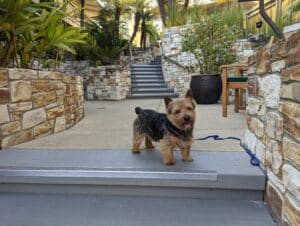
The 7 Best Dog Friendly Weekend Getaways in Northern California
Disclosure: This article contains affiliate links and is a member of Amazon Services LLC Associates Program, meaning when you make a purchase, I earn a small commission. Affiliate links cost…

Dog Park at Dog Mountain: Celebrate Life With Your Pet
Have you thought of visiting the dog park at Dog Mountain in St Johnsbury? I hope you do. It is one of the best places to both mourn the pets…

Flying With A Big Dog: Travel Tips For Ease & Safety
Are you planning to fly with a big dog? Get a step-by-step guide that provides travel tips for ease and safety

50 Dog Travel Picture Captions: Top 10 Dog Breeds
LOOKING FOR THE BEST DOG TRAVEL CAPTIONS FOR YOUR BREED’S INSTAGRAM PICTURES? Fun ideas to capture your Golden Retriever, German Shepherd, Labrador, French Bulldog, Beagle, Poodle, Rottweiler, Yorkshire Terrier (Yorkie),…

Why Dogs Scratch the Carpet – 8 Reasons + Solutions
Why do dogs scratch at the carpet? The main reason why dogs scratch at the carpet is because your pup is following a very normal instinct and routine to settle…

Driving Through Europe with a Dog: The Ultimate Guide
Are you traveling in Europe with a dog? We asked nomad expert Julie from WarrenJulieTravel for her top tips on how to get around with your pups. Embarking on a…

IMAGES
VIDEO
COMMENTS
Make sure the vehicle is cool with fresh air circulating. It also helps some dogs if they can see out of a window — for smaller dogs, consider a booster seat or dog pod. Most dogs travel best with a handful of dry biscuits in their stomach, given 1-2 hours beforehand, rather than traveling with a totally empty stomach.
5. A crate, car seat, and/or seatbelt are necessary. Safety is important when you're on the road. If you stop short, slam on the brakes, or get into an accident, your dog can get seriously hurt. To protect your dog, make sure to secure them while in the vehicle. For medium to large dogs, try a crate or dog seatbelt.
Avoid carsickness by letting your dog travel on an empty stomach. However, make sure they have plenty of water at all times. Keep the car well-ventilated. If the dog is in a crate, make sure that ...
2. Introduce your dog to the cage, if you are using one. Present the cage to your dog positively. Allow the dog to sniff the cage before it goes in the car. Once the cage is placed in the car, lock your dog in it. Continue your positive attitude about the cage and walk away from the dog in the cage for several minutes.
That way, you can crack the windows, feel the breeze, and enjoy the scenery, knowing your dog is safe and sound. Road Trip Essentials for Your Dog's Safety The first part of dog car safety is ...
Buckle up your pup. Seatbelts are lifesaving — for people as well as pets. Any time you take your dog in the car it's crucial they are secured. Kennels are the best way to keep your pooch safe and ensure they aren't distracting you while you navigate and drive. However, if you'd prefer to keep an eye on your buddy during your trip, you ...
Pack a few water bottles and a travel-sized water bowl for your dog, and offer them water every time you stop at gas stations or rest stops. This is especially important if your dog doesn't like to drink while the car is in motion. 5. Regular Potty Breaks.
By car. Do you know the best place for your dog or cat in your car? Dogs shouldn't roam in the car. The safest way for your dog to travel in the car is in a crate that has been anchored to the vehicle using a seat belt or other secure means. Dog restraints or seat belts are useful for preventing your dog from roaming around the car and being a ...
Give your dog a meal 3 to 4 hours before you hit the road. Whenever it is time for them to eat again, always pull the car over and stop to let them eat and take a bathroom break before resuming. 4. Don't Leave Your Dog in the Car. Do not ever leave your dog in a car unattended.
Successful car travel with your pet takes some planning, some patience, and some flexibility. ... The last thing that you want to find out an hour into your family's epic 10-day adventure to Yellowstone is that your dog gets car sick every time you turn a corner. Some pets aren't healthy enough or don't have the temperament for traveling ...
This may help avoid pet car sickness. Never leave your dog alone in a parked car. It is a safety concern at temperatures higher than 70°F or lower than 35°F. However, passersby may decide to ...
A dog car harness that buckles into a seat belt or clips to cargo tie-down is an option that works for most dogs and vehicles. A car harness for dogs can create a safer, more comfortable ride for your pup. When it comes to picking a dog harness, we recommend the PetSafe Deluxe Harness. This harness works with any seatbelt and can also be used ...
Consult your veterinarian to create the best travel plan for your dog if he does not travel well. Strategies to de-stress dog road trips include: A Thundershirt® swaddles the dog like an infant is swaddled, and can reduce anxiety. A pheromone calming collar can help reduce anxiety. Medication prescribed by your veterinarian: trazodone (brand ...
Service dogs travel for free. The fee for pets is $25 each way for trips less than 7 hours. One pet per passenger is allowed in coach class only. Pet dogs must weigh 20 pounds or less, including the carrier, which can be no more than 19-by-14-by-10.5 inches, and must be stowed under your seat.
As your pet becomes more accustomed to car travel, start to gradually increase the length of your trips. And, of course, pets are not excluded from the old adage to buckle up for safety! Make sure your pet is safe and secure in the back seat. You can invest in a pet car seat, travel crate or seat belt leash to keep your dog restrained in the back.
Gunner G1 Kennel, available at Gunner, from $499. According to Wolko, you should never travel with your dog in a plastic crate that has been buckled in with a car seat belt because it can easily ...
Ideally, a dog should be kept inside the cabin of the truck. If the car is a two-seater, the dog is better off in the front seat than in the truck bed. But if that's not possible, and you cannot keep your dog inside a truck, they should be kept in a crate securely fastened to the truck bed. Too many times, I have seen dogs standing loose in ...
3. Behavioral Management for Car Anxiety - Avoidance of Stressors. For dogs with fear or anxiety, sometimes the best choice is to avoid the stressor altogether. If riding in the car is not the problem, but interacting with other dogs is, select stops on your route that are less likely to involve other dogs.
If they show signs of heatstroke, dial 999 immediately. You can call the RSPCA's cruelty line for help and advice. But if the dog is in danger, dial 999 immediately. Most pets will need to take a trip in the car at some point Our vets have plenty of tips about harness and safe car travel with your dogs, cats and small pets.
Crate. A safer way for your dog to travel in a car is in a dog crate, preferably made from a strong material such as aluminum. Some crates even have padding for added impact protection. No matter ...
In my opinion, the best way to travel with a dog is by car. This article will share tips and tricks for traveling with dogs in cars, planes, trains or any other method of transportation.
If your dog is easily excitable, anxious, or reactive, consider whether a trip is the best choice for them. If your pup must travel, it's very important to consult with your vet before purchasing any calming supplements or aids. "There are many over-the-counter supplements that aren't tested for safety or purity," Bryant says.
Make frequent stops for exercise and potty breaks. This will not only keep your dog happy and healthy, and give you a chance to stretch your legs. Be sure to clean up after your dog and always ...
Traveling is a set of skills that almost every dog can master (more on this later). Travel Hack #2: The Best Pit Stops for Traveling Solo with a Dog. The most efficient routes across the country are also major trucking routes. Gas stations that are built for truckers also make for great places to to take a break with your dog. Recommended gas ...
Chewers may gnaw at the bed liner. The Roverlund Pet Carrier is made with marine and mountaineering fabric, designed to last during all travel adventures. It comes in two sizes: small (up to 15 ...
San Francisco's Municipal Railway (MUNI) has a different set of rules. Pet can't ride during peak hours, and during off-peak hours, only one pet can ride on a vehicle at a time. Dogs must wear ...